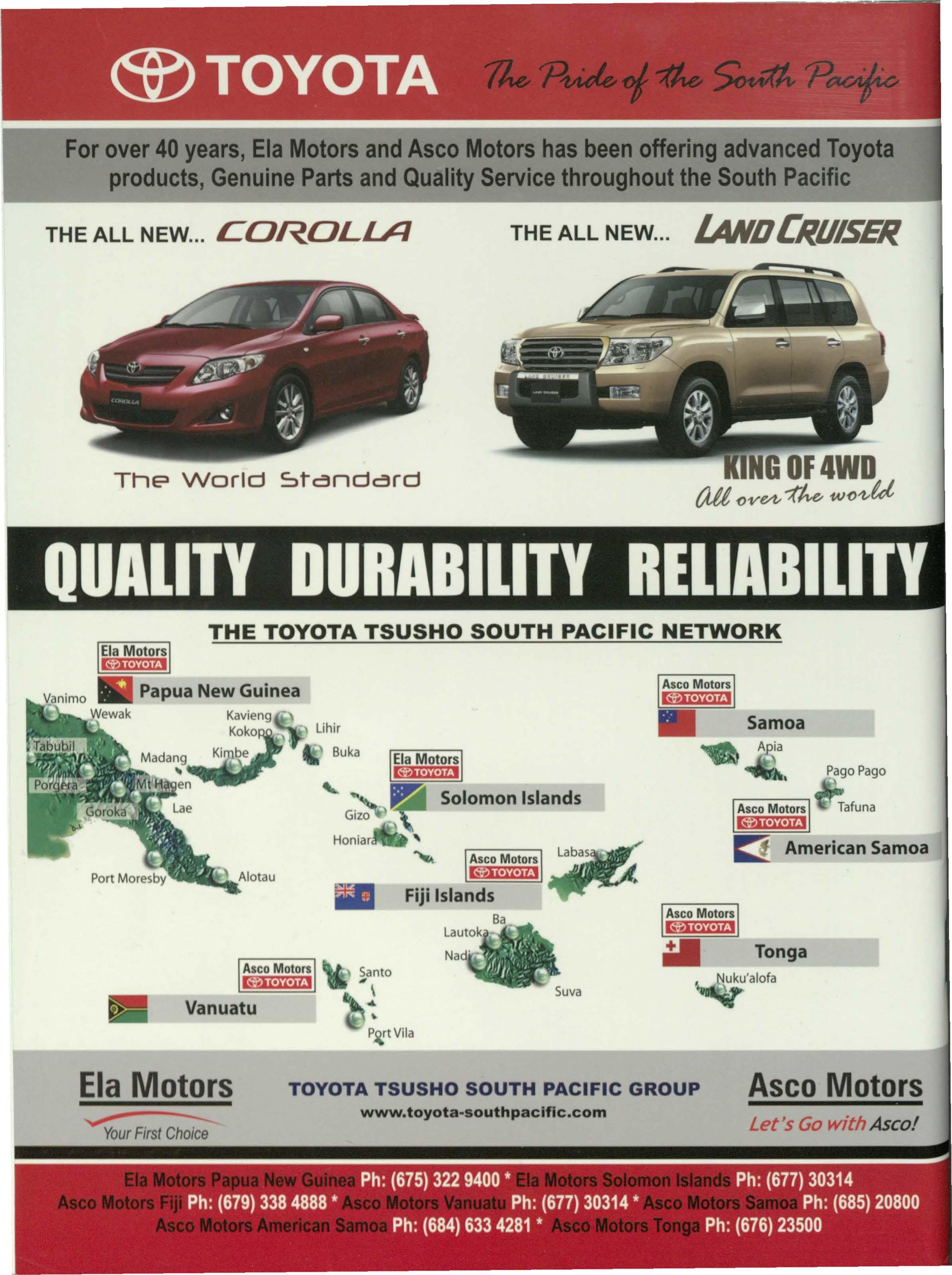




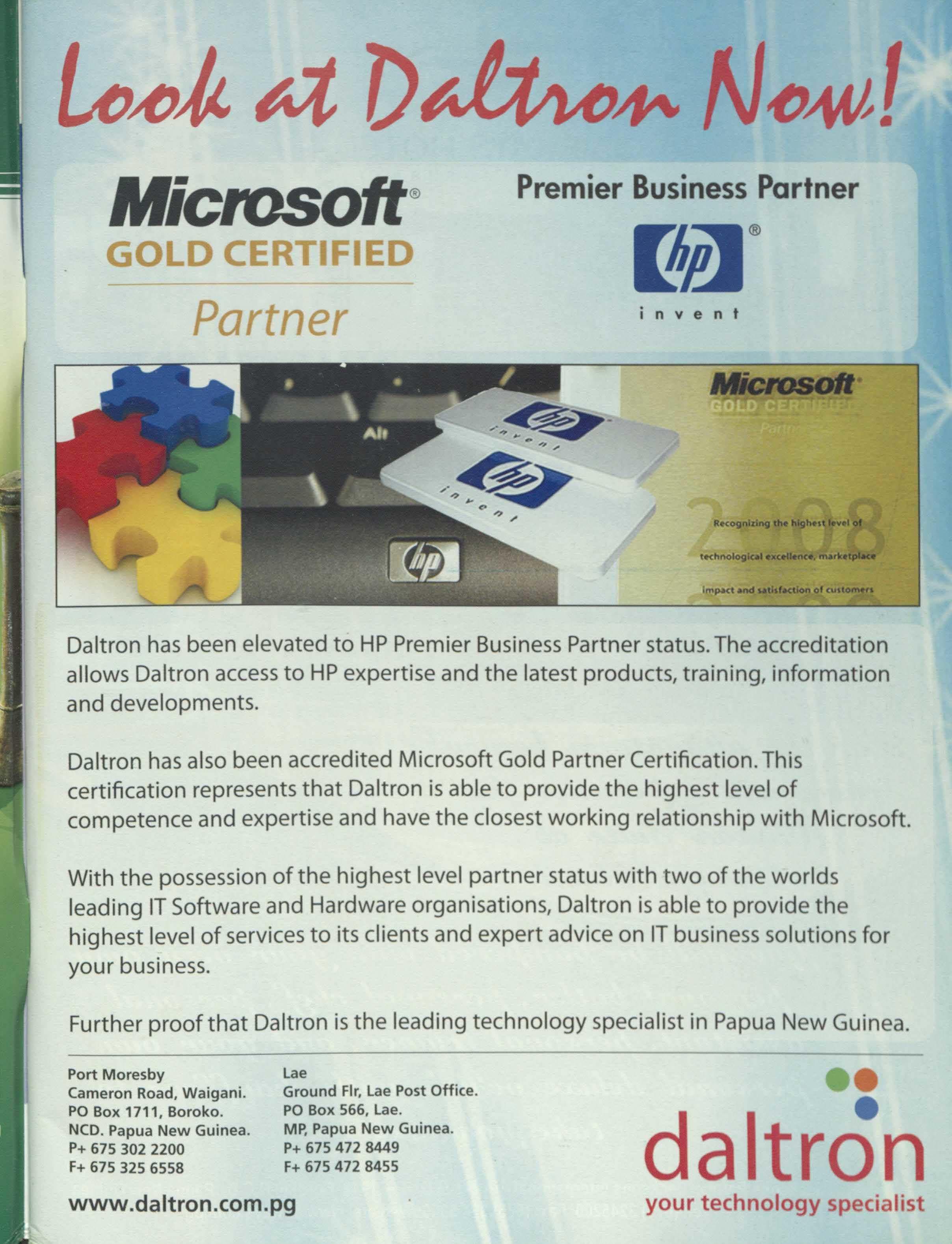
Daltron has been elevated to HP Premier Business Partner status. The accreditation allows Daltron accessto HP expertise and the latest products, training, information and developments.
Daltron has also been accredited Microsoft Gold Partner Certification. This certification represents that Daltron is able to provide the highest level of competence and expertise and have the closest working relationship with Microsoft.
With the possession of the highest level partner status with two of the worlds leading IT Software and Hardware organisations, Daltron is able to provide the highest level of services to its clients and expert advice on IT business solutions for your business.
Further proof that Daltron is the leading technology specialist in Papua New Guinea .
Port Moresby
Cameron Road, Waigani.
PO Box 1711, Boroko.
NCO. Papua New Guinea.
P+ 675 302 2200
F+ 675 325 6558
Lae
Ground Fir. Lae Post Office. PO Box 566, Lae.
MP. Papua New Guinea.
P+ 675 472 8449
F+ 675 472 8455


Company
Welcome Aboard our Bird of Paradise Service.
As we move into the second half of this year, Air Niugini is poised to celebrate its 35 years of operation as the national airline of Papua New Guinea on November 1, 2008.
Two years ago we operated our domestic schedule with a fleet comprising (4) Dash 8-200s; (4) F28-4000 series; and (2) F100s - one F100 was also operating the Port Moresby-Cairns route.
Within two years I am pleased to say, the domestic fleet has expanded to include (6) F100s; (3) 50-seater Dash 8-300s; (3) 36-seater Dash 8-200s; and (2) Dash 8-103 - of which one is a dedicated freighter.
The international schedule is operated by a Boeing 767-300, a Boeing 757 and an Embraer 190.
Since we introduced a second aircraft on the international routes in August 2007, we have been able to increase schedule reliability. We are rationalising the domestic schedule to reduce multiple regional port services to provide a more efficient operation. The issue of pilot shortage is also being addressed and when resolved, will enable us to achieve better schedule reliability on our domestic network.
With the current fleet of 17 aircraft mix operating the domestic and international schedule, the airline is positioned to offer the best travel options to meet our customers' expectations.
The introduction of one way fares last month from Port Moresby to Cairns, Brisbane and Sydney and vice versa will ensure we remain competitive in these markets.
We commenced operating a second service to Manila on May 24 with the Boeing 757-200 to alleviate the capacity shortage on the route and with the confidence it will offer excellent same day connections to and from Asia and the Pacific Islands through Port Moresby.
With our vision to be the premier airline in Papua New Guinea and the region, we have joined the queue of airline customers for the long-range, high-tech jetliner 8787 for delivery in 2010. The order for the Dreamliner is in line with the shareholder's plan to see Air Niugini equipped with a modernised fleet to meet future expansions and growth as a regional airline. With the currently announced delivery delays, we expect the actual delivery around April 2012.
In our cultural calendar of events during July and August, Rabaul (East New Britain) will host the 14th National Mask Festival from 16-19 July. The festival will display a variety of cultural masks from the many ethnic groups, some of which have not previously been seen in public. The world famous Mt Hagen Show will once again be staged from August 14-16; promising another spectacular cultural display of singsing groups from the Western Highlands Province, as well as surrounding highlands provinces turning out in their magnificent plumes and fineries; a most pleasing sight for every photographer and ethnographer.
Inside your PARADISE issue, we bring you a fascinating glimpse of history through stunning photographs from the Frank Hurley's Exhibition and the images of a rugged journey through Kokoda, as it is now and in 1942.
Whether we are taking you home or bringing you to our fascinating country, experience our unique Melanesian hospitality right here with our inflight service.
Enjoy your flight.
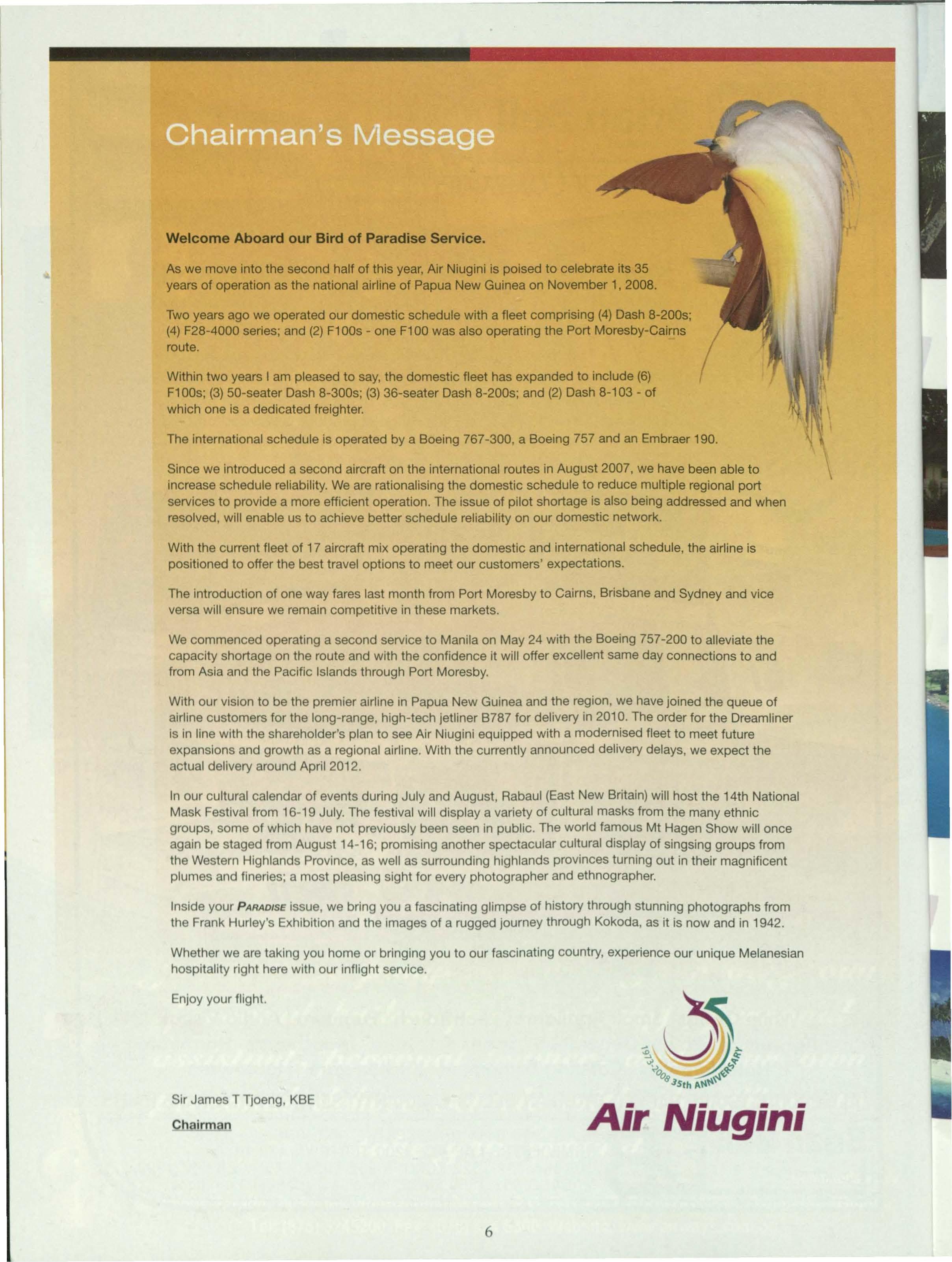
Sir James T Tjoeng, KBE Chairman
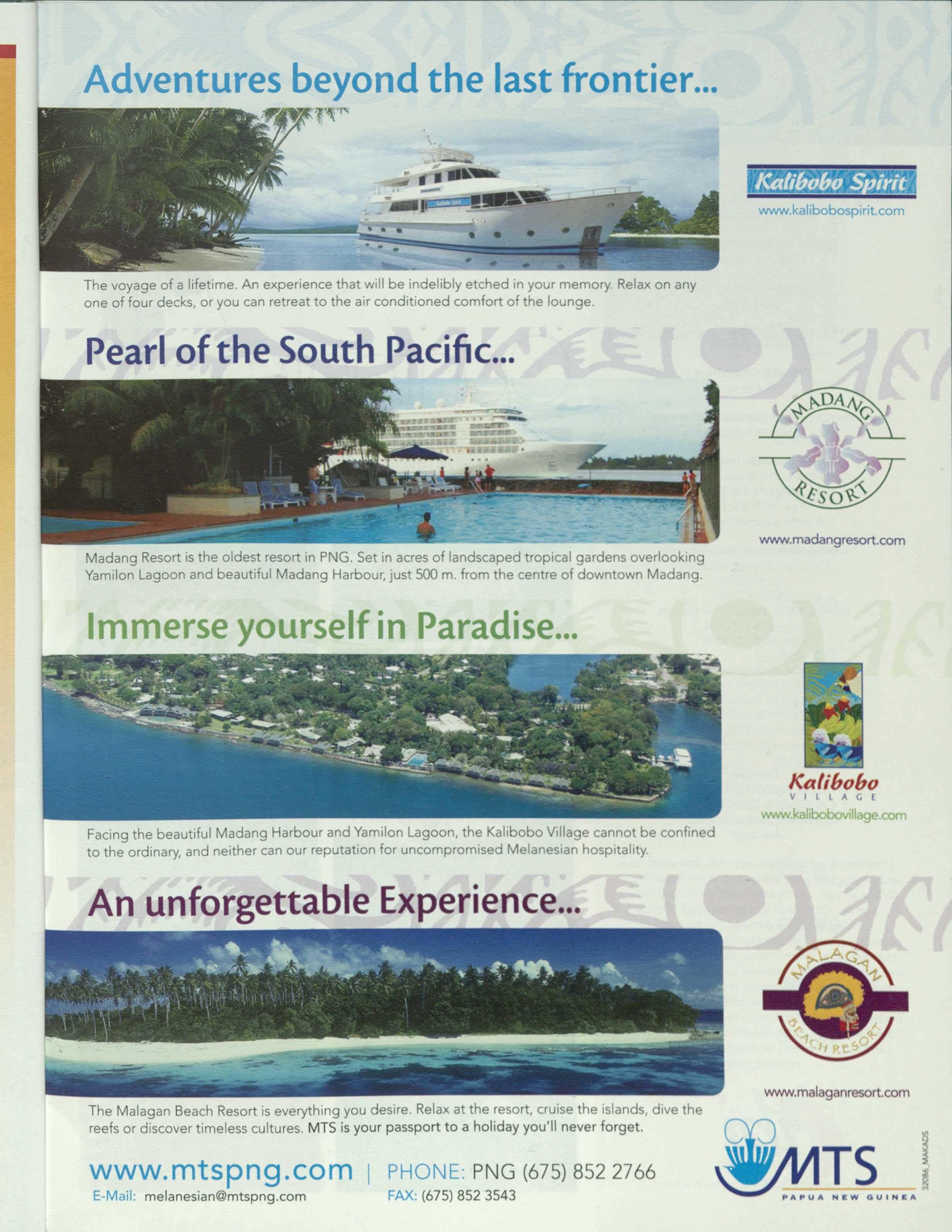

Paradise is the complimentary inflight magazine of Air Niugini, Papua New Guinea's international airline. It is published six times a year by Islands Business International.
Publisher/Managing Director
Godfrey Scoullar
Group Editor-in-Chief Laisa Taga
Design Stanley Prasad
Editorial Consultant EvaArni
Advertising & Marketing Manager
Sharron Stretton
Islands Business International
GPO Box 12718, Suva, Fiji Islands
Tel: +679 330 3108
Fax: +679 330 1423
E-mail: advert@ibi.com.fj
Correspondence to the airline to: The Chief Executive Officer Air Niugini PO Box 7186
Boroko, NCD, Papua New Guinea
Tel: +675 327 3458
Fax: +675 327 3350
Editorial correspondence to: Paradise lnflight Magazine
PO Box 12718, Suva, Fiji Islands
Tel: +679 3303 108
Fax: +679 3301 423
E-mail: editor@ibi.com.fj
Printing
raft lnprint Pty Limited
Cnr Bilsen & Zillmere Roads
Boondall, Queen land, 4034 Australia
Uns licited maJ1uscripts, artwork, transparencies and photographs are submitted at the sender's risk. While all care will be taken neither the publishers nor the airline will accept respon ibility for accidental loss or damage. No part of this publication may be reproduced without the written p rmission of the publisher. Statements, opinions and points of view expre ed by the writ rs are their own and do not necessarily represent those of the publisher, ditor, or th airline. Information contain d in this publication may be correct only at the time it was originally obtained by the writers and may be subject to change at any lim and without notice.

Wuvulu
Another world, well worth the visit
Papa Bilong Chimbu
Discovering family in the Chimbu province
The Underwater Glider
The unique pig-nosed turtle
Did You Know That ... World's largest moth
Kokoda
Lush, beautiful, brutal...impossible
A Long Lost 'Wantok'
Following the trail of Sam Fenichel
Frank Hurley's Journeys into Papua
A pioneer of photography in colonial ra
The Trobriands' Carver
Making a mark internati nally
West New Britain
A tropical paradi
Movie making in PNG
Growth of local industry elu iv
'I'm in Heaven when I'm in Fiji'
Tokoriki: A hon ymoon r' playground
Sydney
Australia' very own m cca for touri t


Fax (675) 548 9155
Fax (675) 982 1129
Fax (675) 986 4107
Fax (675) 983 5144
Fax (677) 30 692

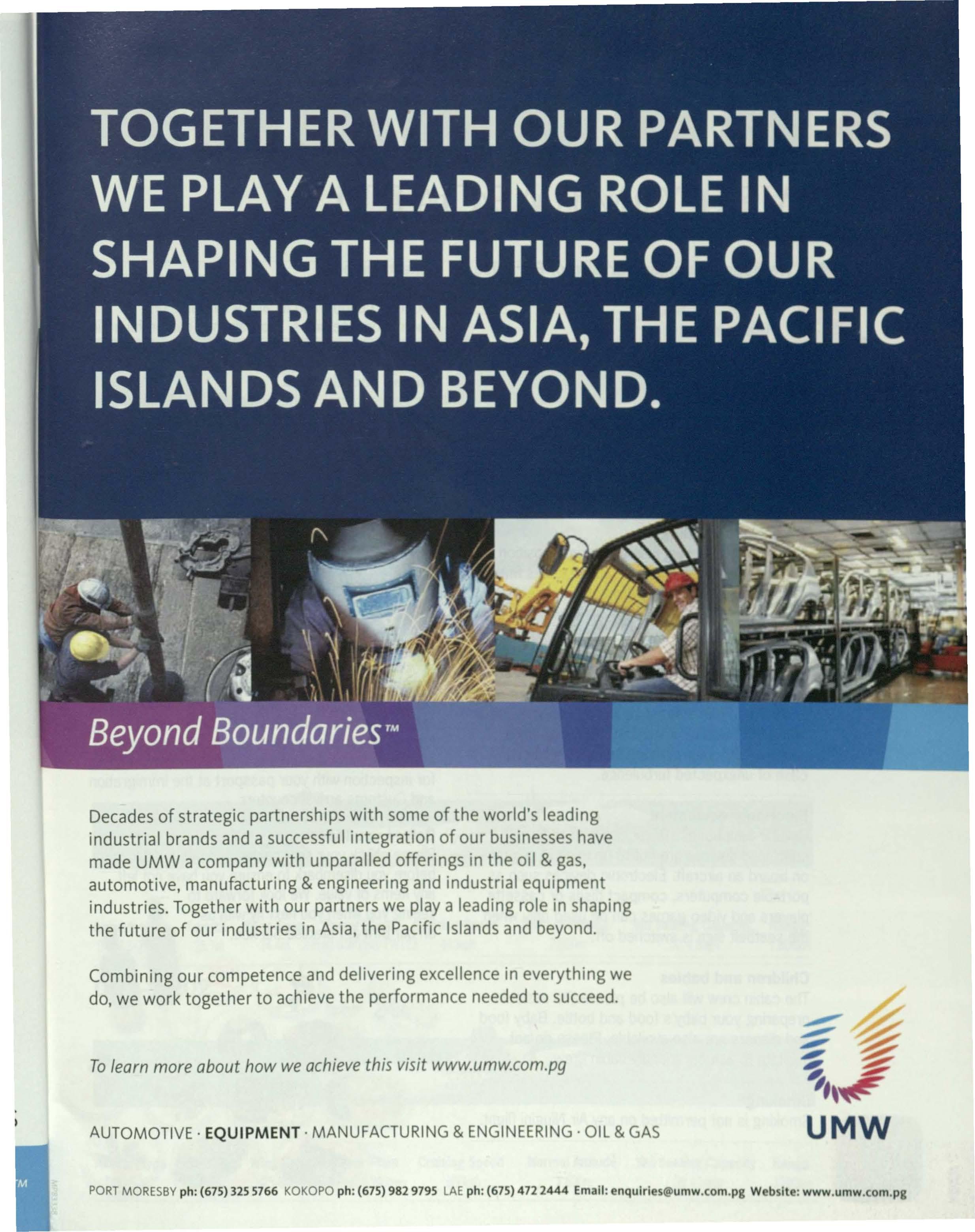
Decades of strategic partnerships with some of the world's leading industrial brands and a successful integration of our businesses have made UMW a company with unparalled offerings in the oil & gas, automotive, manufacturing & engineering and industrial equipment industries. Together with our partners we play a leading role in shaping the future of our industries in Asia, the Pacific Islands and beyond.
Combining our competence and delivering excellence in everything we do, we work together to achieve the performance needed to succeed.
To learn more about how we achieve this visit www.umw.com.pg

We hope you enjoy our Bird of Paradise In-flightService
If there is anythingour cabincrew can assist you with duringyour flight, pleasedo no hesitateto ask them.
Pleaseensurethat your carry on luggage is placedin the overheadlocker or under the seat in front of you.
Ensurethat your seat is in the uprightposition duringtakeoff and landing.Foldingtables must be returnedto their originalpositionin the seat back or the armrest.
Yourseatbeltmust be securelyfastenedduring takeoff and landingor wheneverthe seatbeltsign is on. Whenthe seatbeltsign is off you may move aboutthe cabinas necessary.Howeverwhile seated,keepyour seatbeltfastenedsecurelyin case of unexpectedturbulence.
Cellulartelephones,TV receiversor radio controlleddevicesare not to be usedat anytime on boardan aircraft. Electronicdevicessuchas portablecomputers,compactdiscs or cassette playersandvideogamescan be usedonlywhen the seatbeltsign is switchedoff.
The cabincrew will also be pleasedto assist in preparingyour baby'sfood and bottle. Babyfood and diapersare also available.Pleasedo not hesitateto ask our friendlycabincrew.
Smokingis not permittedon anyAir Niuginiflight.
A selectionof moviesand musicincludingclassical, modern,countryand local are availableon internationalservices.Programmescan be foundin the in-flightentertainmentsectionof this magazine.
On Internationalflights, pillows and blankets are availableon request from our cabin crew.
Ourinflightmealshavebeenspeciallypreparedfor your enjoyment.If you requirea vegetarianmealor you are on a specialdiet, child or babyfood, pleaseinformus whenmakingyour reservation.
Duringthe flight take sometime to look through our In-flightDutyFreebrochurelocatedin your seat pocket.Dutyfree purchasescan be madeafter MealService.All majorcredit cardsare accepted.
Duringyour flight, our cabincrewwill distribute Immigrationand Customsforms beforeeach landingpoint. Ensurethat you carefullyreadand completethese documentsand havethem ready for inspectionwith your passportat the Immigration andCustomsarrivalcounters.
Pleasecheckyour seatpocketandoverheadlockers beforeyou disembarkto ensureyou havenot left anyitemsof value.Welookforwardto seeingyouwhenyou nextfly with us on our Birdof ParadiseService.
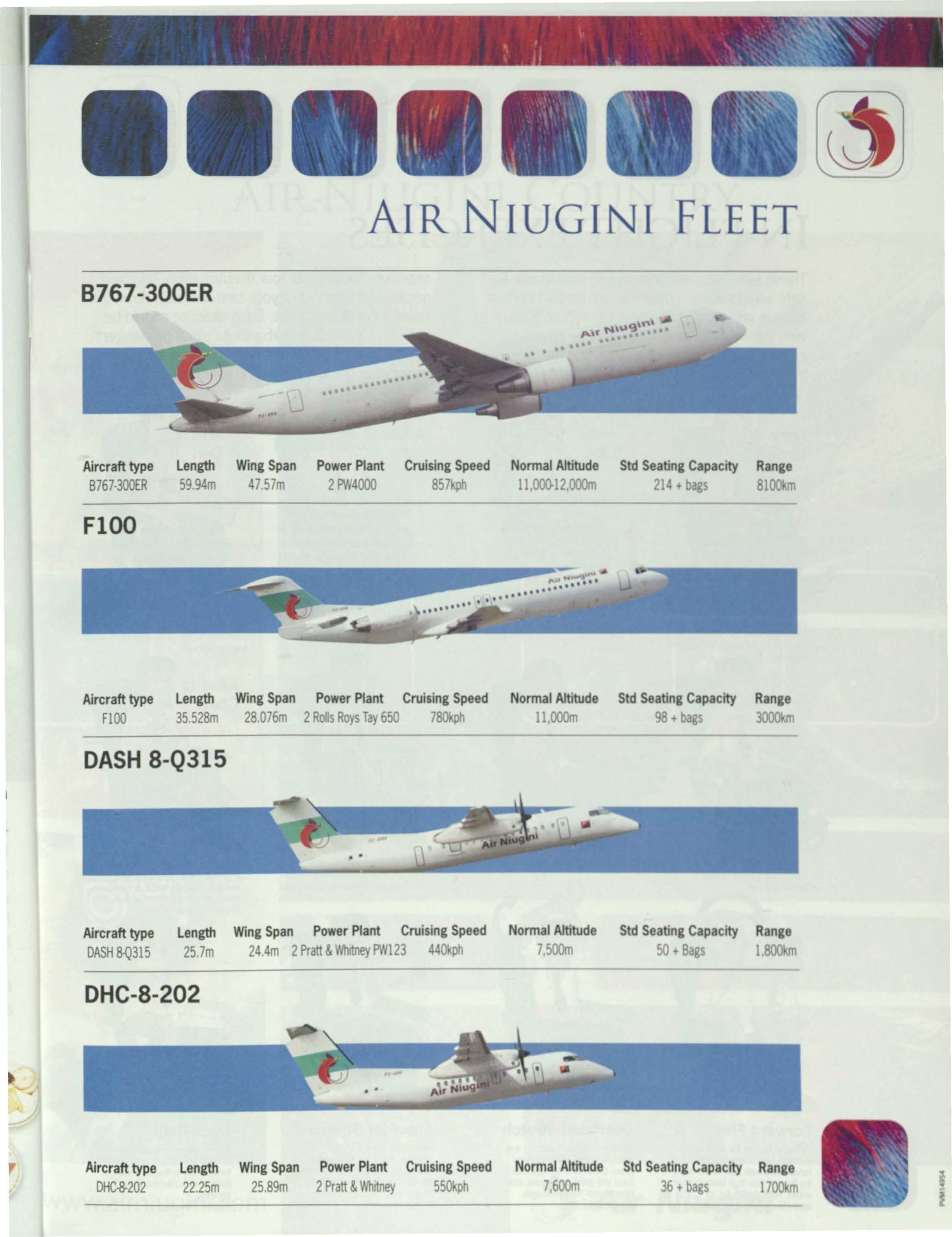
Aircraft
Theseexercisesare designedto encouragea safe way to enjoymovementand stretchcertain musclegroupsthat can becomestiff as a resultof long periodsof sitting.Theymaybe effectivein increasingthe body'scirculationandmassaging the muscles.Werecommendyou do these
exercisesfor three or four minuteseveryhourand occasionallyget out of your seat andwalkdownthe aislesif conditionsallow.Eachexerciseshouldbe donewith minimaldisturbanceto other passengers. Noneof the followingshouldbe performedif they causepainor cannotbe donewith ease.
Lift feet off the floor: Drawa circlewith toes,simultaneouslymovingonefoot clockwiseandthe otherfoot counter clockwise.Reversecircles.Doeach directionfor 15 seconds.Repeatif desired
Lift leg withkneebentwhile contractingyourthighmuscle. Alternatelegs.Repeat20.30timesfor eachleg
l. Startwithbothheelson the floorandpointfeet upwardas hlghasye
2. Putbothfeetfiat on the floor.
Hunchshouldersforward,thenupward, thenbackward,thendownwardusinga gentlecircularmotion
3. Lift heelshigh,keepingballsof feet on floor.Continuethesethreestages withcontinuousmotionin 30 second intervals.
Startwith armsheldat 90' angle- elbowsdown,handsout in front. Raisehandsup to chestandbackdown alternatingarms.Dotheseexercisein 30 secondintervals.
Bend forwardslightly. Clasphandsaroundleft kneeandhug it to yourchest.Holdstretchfor 15 seconds.Keepinghandsaroundknee, slowlylet it down.Alternatelegs. Repeat10 times
Withbothfeeton the floorand stomachheldIn slowly,bend forwardandwalkyourhandsdown thefrontof yourlegstowardsyour ankles.Holdstretchfor 15 secondsandslowlysit backup.
Raisebotharmsstraightup and overyourhead.Withonehand graspthewristof theopposite handandgentlypullto oneside. Holdstretchfor 15 seconds. Repeatotherside.
Reachrighthandoverleft shoulder.Placeleft handbehind rightelbowandgentiypresselbow towardshoulder.Holdstretchfor 15 seconds. Repeatotherside
Withshouldersrelaxed,dropear to shoulderandgentlyroll neck forwardandto the otherside, holdingeachpositionabout5 seconds. Repeat5 times Wv,
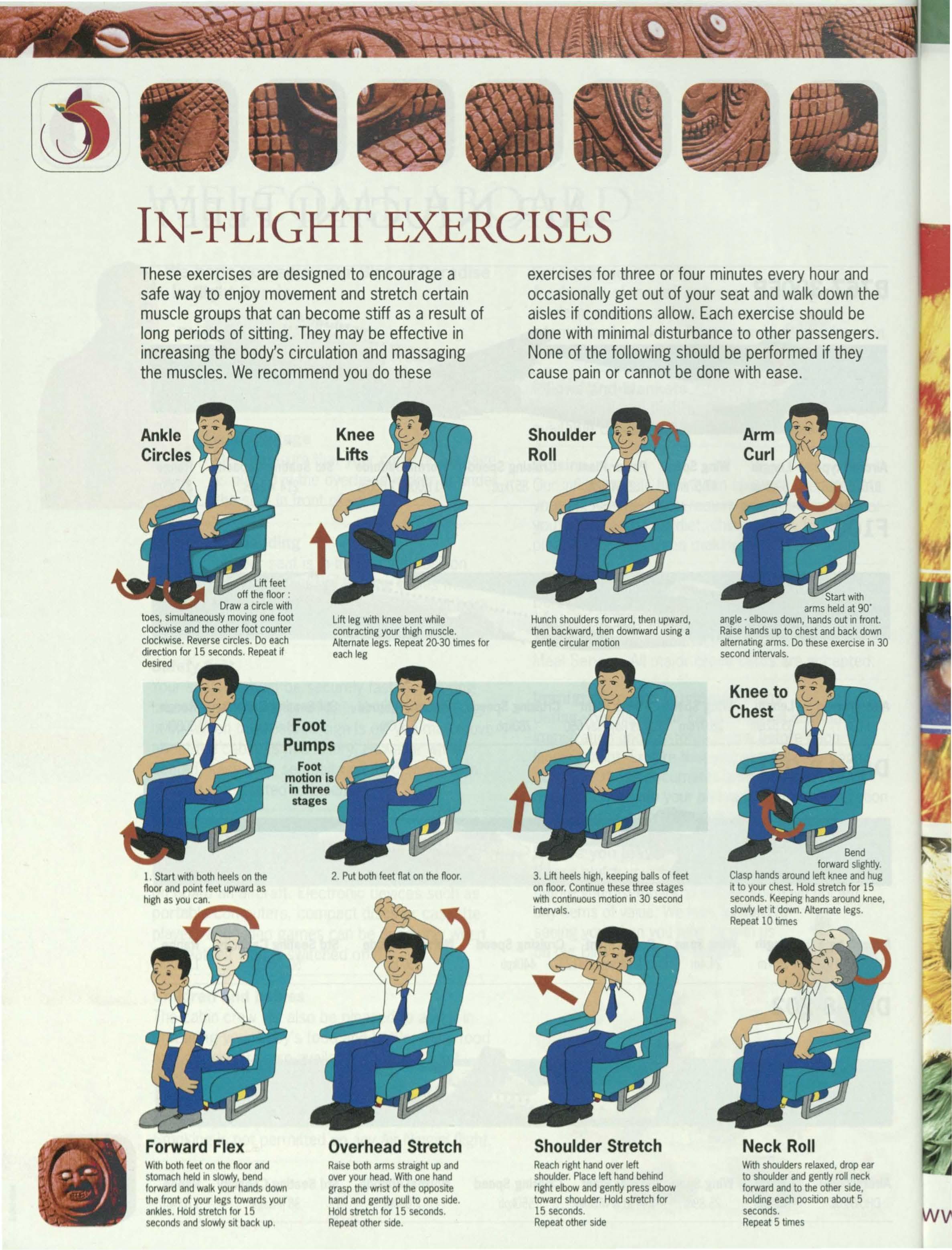
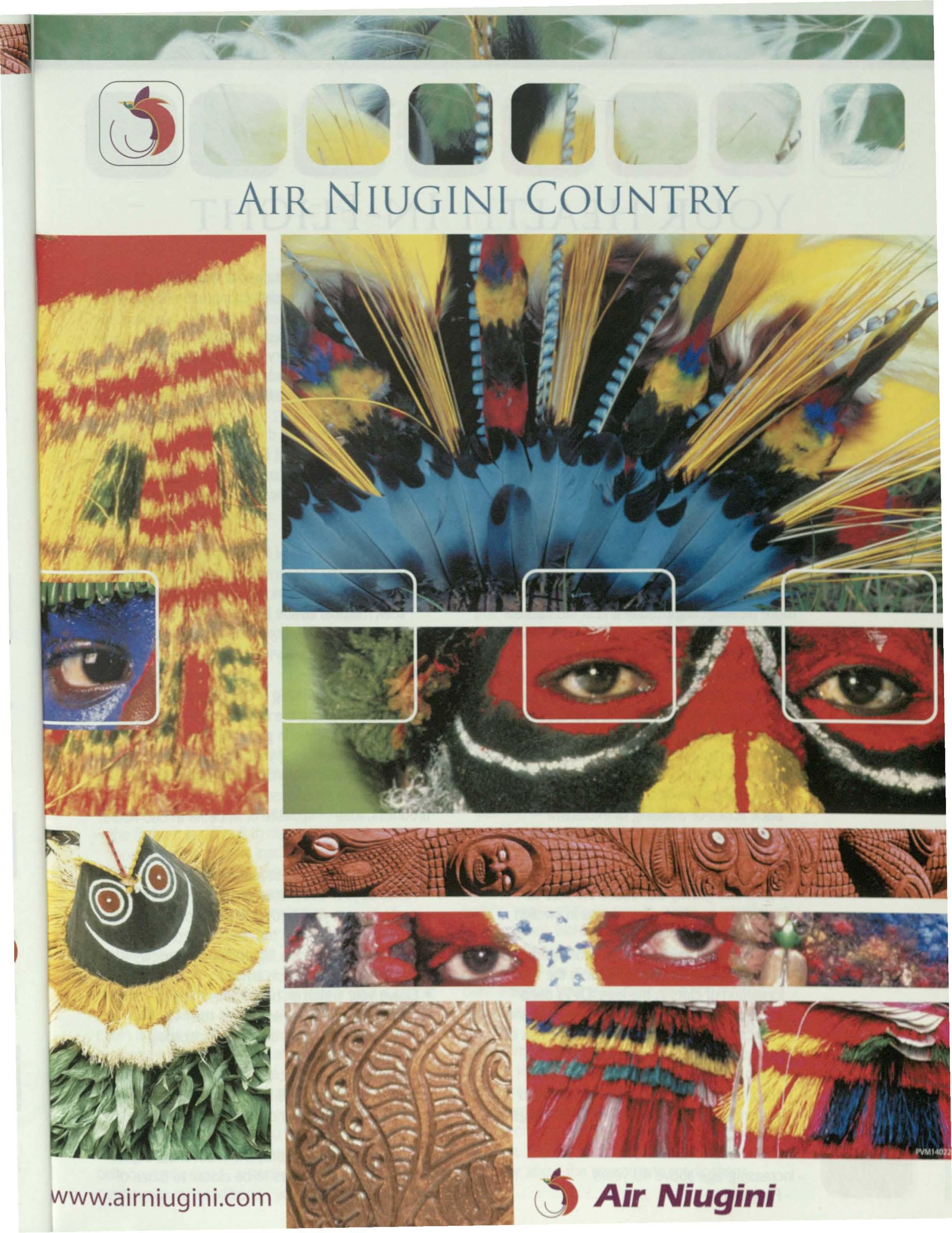
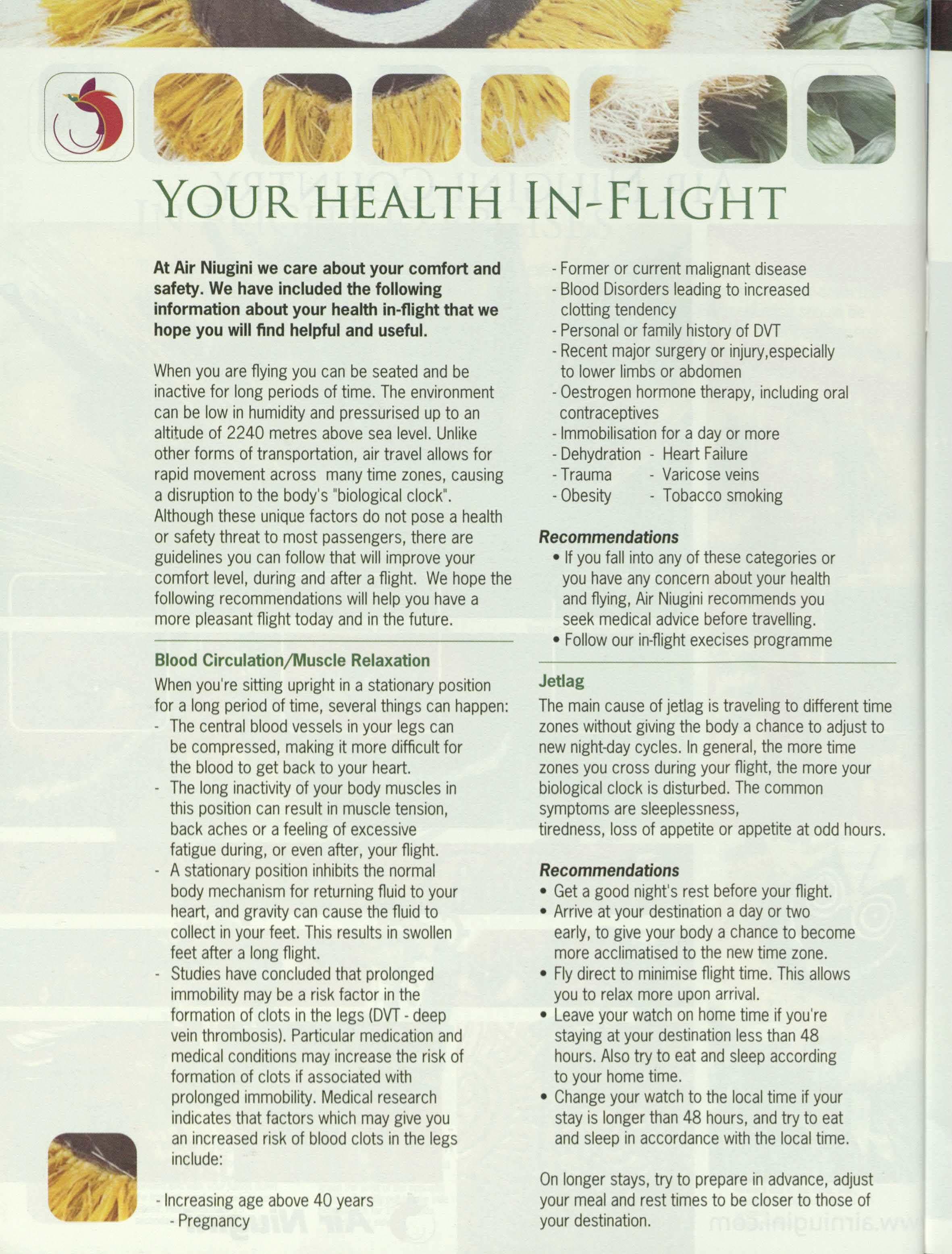
At Air Niuginiwe care aboutyour comfortand safety.We have includedthe following informationaboutyour healthin-flightthat we hopeyou willfind helpfuland useful.
Whenyou areflyingyou can be seatedand be inactivefor long periodsof time. Theenvironment can be low in humidityandpressurisedup to an altitudeof 2240 metresabovesea level.Unlike otherforms of transportation,air travelallowsfor rapidmovementacross manytime zones,causing a disruptionto the body's"biologicalclock". Althoughtheseuniquefactors do not posea health or safetythreatto most passengers,there are guidelinesyou canfollowthat will improveyour comfort level,duringandafter a flight. Wehopethe followingrecommendationswill helpyou havea more pleasantflight today andin the future.
BloodCirculation/MuscleRelaxation
Whenyou'resittinguprightin a stationaryposition for a longperiodof time, severalthingscan happen: Thecentralbloodvesselsin your legscan be compressed,makingit moredifficultfor the bloodto get backto your heart. Thelonginactivityof your bodymusclesin this positioncan resultin muscletension, backachesor a feelingof excessive fatigueduring,or evenafter,yourflight.
A stationarypositioninhibitsthe normal bodymechanismfor returningfluidto your heart,andgravitycancausethe fluidto collectin yourfeet. Thisresultsin swollen feet after a longflight.
Studieshaveconcludedthat prolonged immobilitymaybe a riskfactor in the formationof clots in the legs(DVT - deep veinthrombosis).Particularmedicationand medicalconditionsmayincreasethe risk of formationof clots if associatedwith prolongedimmobility.Medicalresearch indicatesthat factorswhichmaygiveyou an increasedrisk of bloodclots in the legs include:
- Increasingage above40 years - Pregnancy
- Formeror currentmalignantdisease
- BloodDisordersleadingto increased clottingtendency
- Personalor familyhistoryof DVT
- Recentmajorsurgeryor injury,especially to lowerlimbsor abdomen
- Oestrogenhormonetherapy,includingoral contraceptives
- Immobilisationfor a dayor more
- Dehydration - HeartFailure
- Trauma - Varicoseveins
- Obesity - Tobaccosmoking
• If youfall into anyof thesecategoriesor you haveanyconcernaboutyourhealth andflying,Air Niuginirecommendsyou seekmedicaladvicebeforetravelling.
• Followour in-flightexecisesprogramme
Themaincauseof jetlagis travelingto differenttime zoneswithoutgivingthe bodya chanceto adjustto newnight-daycycles.In general,the moretime zonesyou crossduringyourflight,the moreyour biologicalclockis disturbed.Thecommon symptomsare sleeplessness, tiredness,lossof appetiteor appetiteat odd hours.
• Geta goodnight'srest beforeyourflight.
• Arriveat your destinationa dayor two early,to giveyour bodya chanceto become moreacclimatisedto the newtime zone.
• Flydirectto minimiseflighttime.Thisallows youto relaxmoreuponarrival.
• Leaveyourwatchon hometime if you're stayingat your destinationlessthan48 hours.Alsotry to eat andsleepaccording to your hometime.
• Changeyourwatchto the localtime if your stayis longerthan48 hours,andtry to eat andsleepin accordancewiththe localtime.
Onlongerstays,try to preparein advance,adjust your mealandrest timesto be closerto thoseof your destination.

Try somelightexercise - go for a briskwalk,or do somereadingif youcantsleepafterarrivalat your destination. It generallytakesthe body'sbiological clock approximatelyonedayto adjustper time zonecrossed.
CabinHumidity/Dehydration
Humiditylevelsof lessthan25 percentare common in the cabin.
Thisis dueto the extremelylowhumiditylevelsof outsideair suppliedto the cabin.Thelowhumidity cancausedryingof the nose,throat,eyesandit can irritatecontactlenswearers.
• Drinkwateror juicesfrequentlyduringthe flight
• Drinkcoffee,tea andalcoholin moderation.Thesedrinksact as diuretics, increasingthe body'sdehydration.
• Removecontactlensesandwearglassesif youreyesare irritated.
• Usea skinmoisturiserto refreshthe skin.
Eatingand Drinking
Propereatinganddrinkingwillenhanceyour comfortbothduringandafteryourflight.
• Avoidovereatingjust priorto andduring theflight.It is difficultto digesttoo much foodwhenthe bodyis 1nactJve.
• Drinkcoffee,tea andalcoholin moderation.Thesedrinksact as diuretics, increasingthe body'sdehydration.
CabinPressurisation
It is necessaryto pressurisethe outsideair drawn intothe cabinto a sufficientdensityfor yourcomfort andhealth.Cabinsare pressurisedto a maximum cabinaltitudeof 2440 metres.It is the sameair pressureas if you wereat an elevatJonof 2440 metresabovesealevel.Thecabinpressureand normalratesof changein cabinpressureduring climbanddescentdo not posea problemfor most passengers.However,if yousufferfrom upper respiratoryor sinusinfections,obstructive pulmonarydiseases,anaemiasor certain cardiovascularconditions,youcouldexperience
discomfort.Childrenandinfantsmightexperience somediscomfortbecauseof pressurechange duringclimbanddescent.
If youare sufferingfrom nasalcongestionor allergies,usenasalsprays,decongestantsand antihistamines30 minutespriorto descentto help openup yourear andsinuspassages.If youhavea coldor flu or hayfever,yoursinusescouldbe impaired.Swollenmembranesin yournosecould blockyoureustachiantubes-thetinychannels betweenyourmiddleearchamber.Thiscancause discomfortduringchangesin cabinpressure, particularlyduringdescent.
Recommendations
• If youhavea pr~x1stingmedicalcondition thatwarrantssupplementaloxygen,you canorderfrom us. Pleasegiveat least sevendaysnoticebeforetravehng.
• To clear yourearstry swallowingand/or yawning.Theseactionshelpopenyour eustachiantubes,equalizingpressure betweenyourmiddleear chamberand yourthroat.
• Whenflyingwithan infant,feedor give yourbabya dummyduringdescent Suckingandswallowingwill helpinfants equalizethe pressurein theirears.
Thisailmentis causedby a conflictbetweenthe body's senseof visionandI s senseof equilibrium. Air turbulenceincreasesits likelihoodbecause1t cancausemovementof the fluid1nthevestibular apparatusof the innerear.If youhavegoodvisual cues(keepingyoureyesfixedon a non-moving object),motionsicknessis lesslikelyto occur.
Recommendations:
• Whenweather1sclearandyoucansee the ground,seaor horizon,youare less susceptibleto motionsickness.
• Youcanbuyoverthe countermedications butwe recommendthatyouconsultyour doctoraboutthe appropriatemedications.

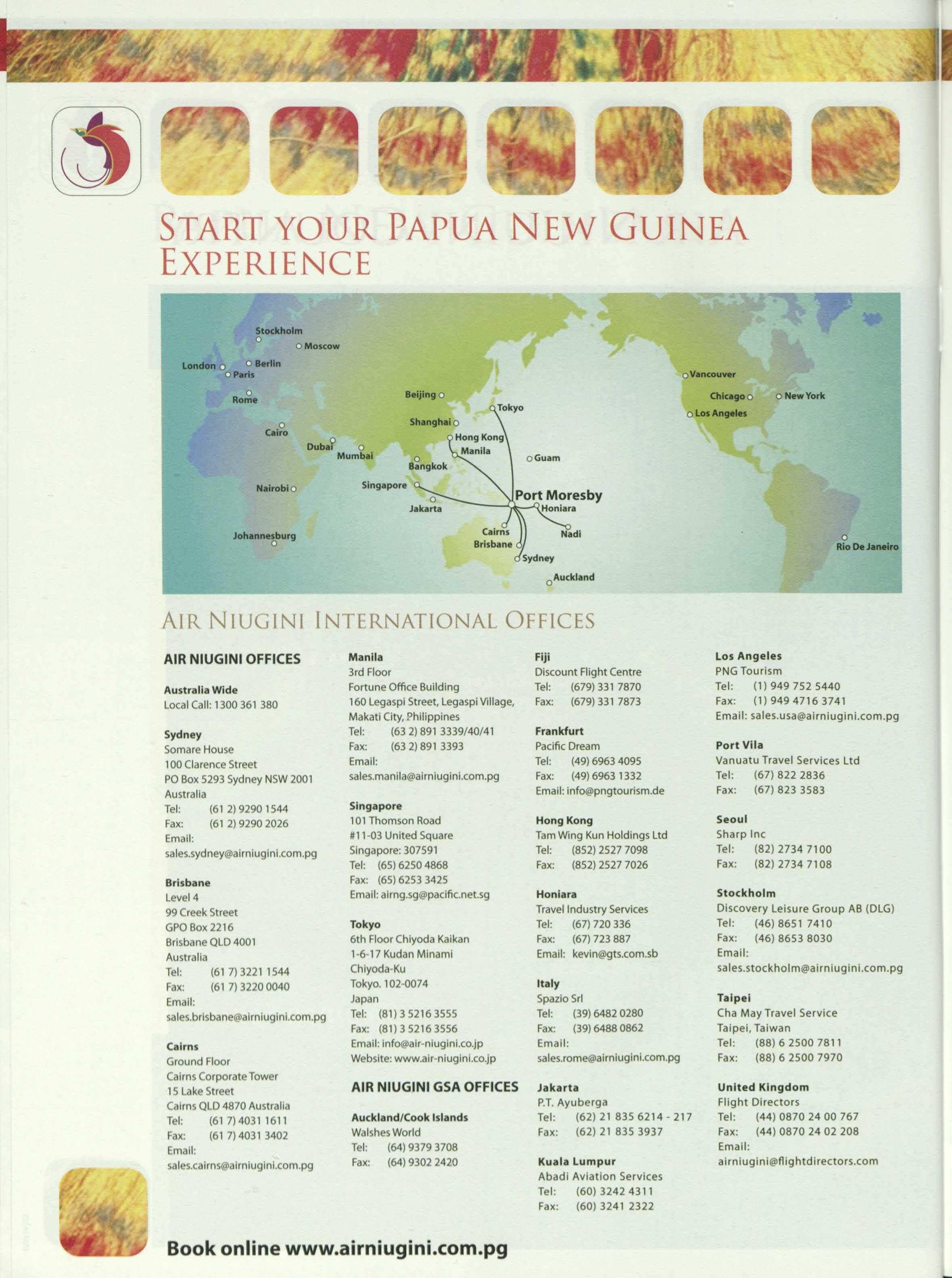
AIR NIUGINI OFFICES
Australla Wide
Local Call: 1300 361 380
Sydney Somare House
100 Clarence Street
PO Box 5293 Sydney NSW2001
Australia
Tel: (61 2) 9290 1544
Fax: (61 2) 9290 2026
Email: sales.sydney@airnluglnl.com.pg
Brisbane Level 4
99 Creek Street
GPO Box 2216
Brisbane QLD 4001
Australia
Tel: (61 7) 3221 1544
Fax: (61 7) 3220 0040
Email: sales.brlsbane@alrnluglnl.com.pg
Cairns
Ground Floor
Cairns Corporate Tower
15 Lake Str et
Cairns QLD 4870 Australia
Tel: (61 7) 40311611
Fax: (61 7) 4031 3402
Email: sales.calrns@alrniuglnl.com.pg
Manila 3rd Floor
Fortune Office Building
160 Legaspi Street, LegaspiVillage, Makati City, Philippines
Tel: (63 2) 891 3339/40/41
Fax: (63 2) 891 3393
Email: sales.manila@alrniugini.com.pg
Singapore
101Thomson Road
#11-03 United Square
Singapore: 307591
Tel: (65) 6250 4868
Fax: (65) 6253 3425
Email: alrng.sg@pacific.net.sg
Tokyo
6th Floor Chlyoda Kaikan 1-6-17 Kudan Minami
Chiyoda-Ku
Tokyo. 102-0074
Japan
Tel: (81) 3 5216 3555
Fax: (81) 3 5216 3556
Email: lnfo@alr-niuglni.co.jp
Website: www.alr-nluglnl.co.Jp
AIR NIUGINI GSA OFFICES
Auckland/Cook Islands
WalshesWorld
Tel: (64) 9379 3708
Fax: (64) 9302 2420
Fiji
Discount Flight Centre
Tel: (679) 331 7870
Fax: (679) 331 7873
Frankfurt
Pacific Dream
Tel: (49) 6963 4095
Fax: (49) 6963 1332
Email: lnfo@pngtourism.de
Hong Kong
Tam Wing Kun Holdings Ltd
Tel: (852) 2527 7098
Fax: (852) 2527 7026
Honiara
Travel Industry Services
Tel: (67) 720 336
Fax: (67) 723 887
Email: kevin@gts.com.sb
Italy
Spazio Sri
Tel: (39) 6482 0280
Fax: (39) 6488 0862
Email: sales.rome@alrniuglni.com.pg
Jakarta
P.T.Ayuberga
Tel: (62) 21 835 6214 - 217
Fax: (62) 21 835 3937
Kuala Lumpur
Abadi Aviation Services
Tel: (60) 3242 4311
Fax: (60) 3241 2322
Los Angeles
PNG Tourism
Tel: (1) 949 752 5440
Fax: (1) 949 4716 3741
Email: sales.usa@airniugini.com.pg
Port Vila
Vanuatu Travel Services Ltd
Tel: (67) 822 2836
Fax: (67) 823 3583
Seoul
Sharp Inc
Tel: (82) 2734 7100
Fax: (82) 2734 7108
Stockholm
Discovery Leisure Group AB (DLG)
Tel: (46) 8651 7410
Fax: (46) 8653 8030
Email: sales.stockholm@airnluginl.com.pg
Taipei
Cha May Travel Service
Taipei. Taiwan
Tel: (88) 6 2500 7811
Fax: (88) 6 2500 7970
United Kingdom
Flight Directors
Tel: (44) 0870 24 00 767
Fax: (44) 0870 24 02 208
Email: alrniuglni@flightdirectors.com
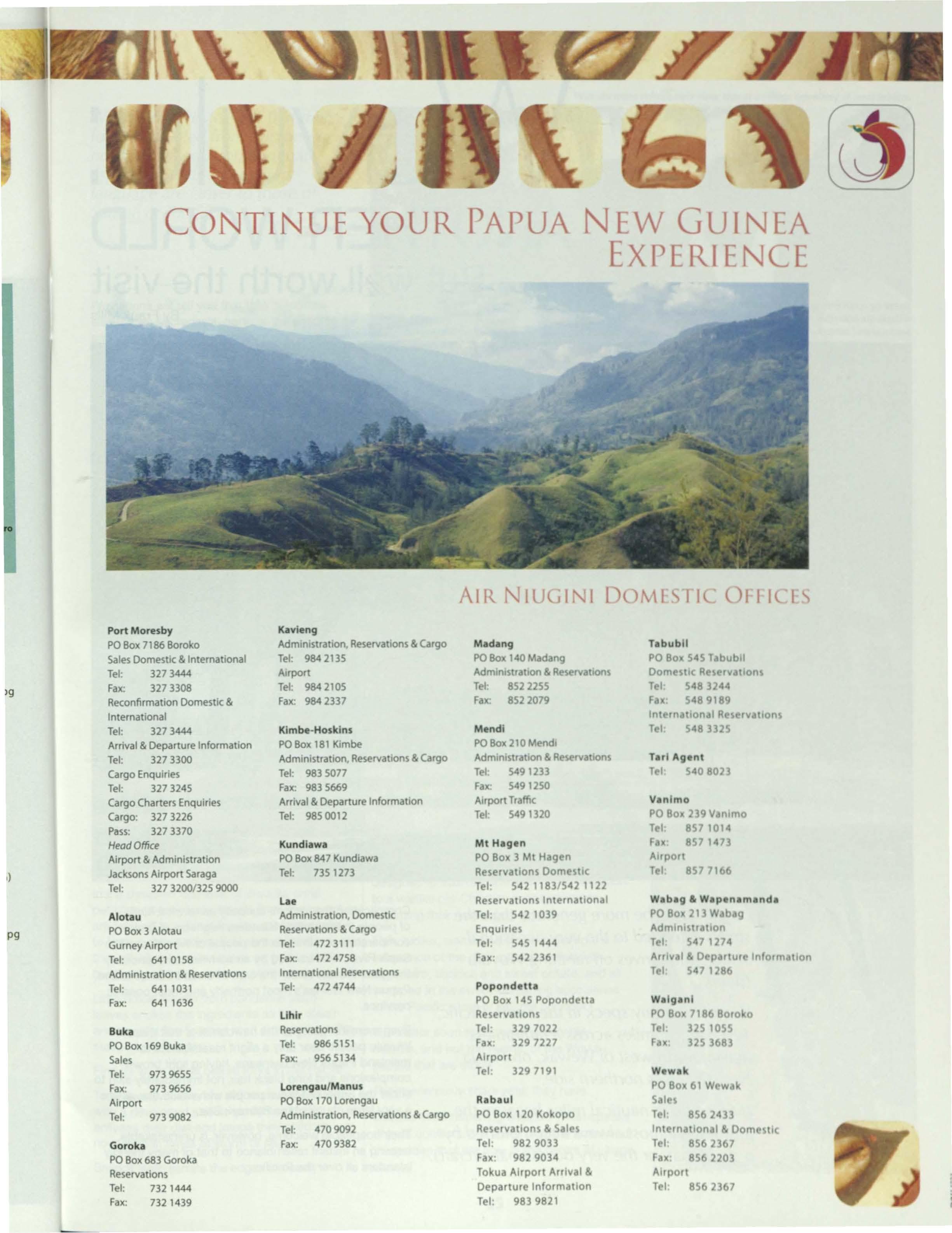
Port Moresby
PO Box 7186 Boroko
SalesOomestic & International
Tel: 327 3444
Fax: 327 3308
Reconfirmation Oomestic & International
Tel: 327 3444
Arrival & Oeparture Information
Tel: 327 3300
Cargo Enquiries
Tel: 327 3245
Cargo Charters Enquiries
Cargo: 327 3226
Pass 327 3370
HeadOffice Airport & Administration
JacksonsAirport Saraga
Tel: 327 3200/325 9000
Alotau
PO Box 3 Alotau
Gurney Airport
Tel: 641 015B
Administration & Reservations
Tel: 641 1031
Fax: 6411636
Buka
PO Box 169 Buka
Sales
Tel: 973 9655
Fax: 973 9656
Airport
Tel: 973 9082
Goroka
PO Box 683
Goroka
Reservations
Tel: 732 1444
Fax: 732 1439
Kavieng
Administration. Reservauons& Cargo
Tel: 984 2135
Airport
Tel: 984 2105
Fax: 984 2337
Klmbe-Hoskins
POBox 181 Kimbe
Administrat10n,Reservations& Cargo
Tel: 983 5077
Fax: 983 5669
Arrival & Oeparture Information Tel: 9850012
Kundlawa
PO Box 847 Kundiawa Tele 735 1273
Lae
Admin1stratIon,Oomestlc
Reservauons& Cargo
Tel: 472 3111
Fax: 472 4758
International Reservauons
Tel.· 472 4744
Lihir
Reservations
Tel: 986 5151
Fax: 956 5134
Lorengau/Manus
POBox 170 Lorengau
Administration, Reservations& Cargo
Tel: 470 9092
Fax: 470 9382
Madang
PO Box 140 Madang
Adm,n, trat,on & Reservations
Tel: 852 2255
Fax: 852 2079
Mendi
PO Box 210 MendI
Adm,n,matlon & Reservations
Tel: 549 1233
Fax: 549 1250
Atrport Traffic Tel S49 1320
Mt Hagen
PO Box 3 Mt Hagt>n
Reservauon Dome1t1C
Tel: 542 118315•421122
Reservations lnternauonal
Tel· 542 1039
Enquiries
Tel: 545 1444
Fax: 542 2361
Popondetta
PO Box 145 Popondetta
Reservations
Tel: 329 702 2
Fax: 329 7227
Airport
Tel· 3297191
Rabaul
PO Box 120 Kokopo
Reservations & Sales
Tel. 982 9033
Fax: 982 9034
Tokua Airport Arrival & Departure Information
Tel: 983 9821
Tabubll
PO Box 54 5 Tabub.l
Domestic Res rvat ons
Tel· 548 3144
Fax 548 9189
lnt<'rnatlonal s rvat ons
Tel 54 33'5
Tari Agent Tl'I 5408023
Vanlmo
PO Bo• 239 Vanlmo T I. 857 1014 ru 8S7 1473
Airpo,t T I 857 71 •
Wabag & Wap namanda
PO Box 1 l W bag
Ad lnl t 1110n
Tel 1174
Arrival D p rtur< Information
Ttl 547 1186
Walganl PO Box 7186 Boroko
T I 3 5 1055 fax: 325 3683
Wewak
PO Box 61 W wak
Sal 1
T I 856 2433
lnt rnatlonal Dom u,c
T I· 856 2367
Fax 856 J203
Airport
T I: 856 1367
Swept by ocea11breezesa11dcoconutbrooms,Wuvulu villagesnre beautifully tidy, i11the absenceof pigs, betel nut n11dmorlem-dnylitter.
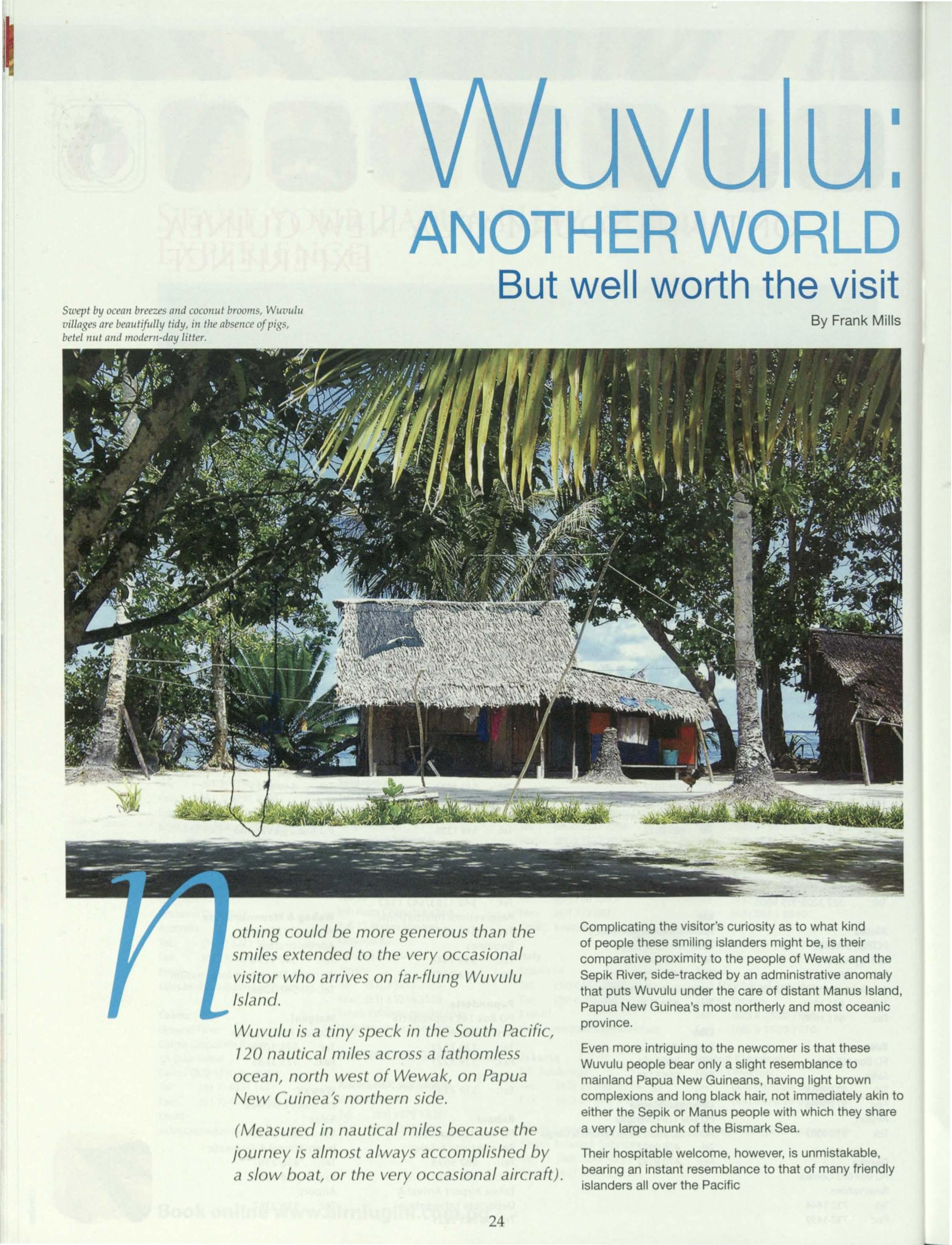
By Frank Mills
othing could be more generous than the smil extend d to the very occasional visitor who arrives on far-flung Wuvulu Island.
Wuvulu is a tiny speck in the South Pacific, 120 nautical mi/ s across a fathomless oc an, north we t of Wewak, on Papua N w Guinea's northern sid
(M asur din nautical miles because the journ y i almost always accomplished by a slow boat, or the very occasional aircraft).
Complicating the visitor's curiosity as to what kind of people these smiling islanders might be, is their comparative proximity to the people of Wewak and the Sepik River, side-tracked by an administrative anomaly that puts Wuvulu under the care of distant Manus Island, Papua New Guinea's most northerly and most oceanic province.
Even more intriguing to the newcomer is that these Wuvulu people bear only a slight resemblance to mainland Papua New Guineans, having light brown complexions and long black hair, not immediately akin to either the Sepik or Manus people with which they share a very large chunk of the Bismark Sea.
Their hospitable welcome, however, is unmistakable, bearing an instant resemblance to that of many friendly islanders all over the Pacific
l the maly Island, anic , akin to share ,le, ~ndly
Wuvuluans will tell you that thetr forebears ,;ailed from \1icronesia, north of the equator, and that a pects of their culture and language are clo.\er to those of Samoa or Tonga Wuvuluans will tell you that their forebears sailed from M1crones1a,north of the equator, and that aspects of their culture and language are closer to those of Samoa or Tonga, other terminal points on the great canoe voyages that entered the vastness of the South Pacific in relatively recent times, completing mankind's occupancy of every last corner of the planet.
It may indeed be from the ocean-going canoes and the cooking fires that were preserved within them on their voyages that the stony hearths of Wuvulu women first came ashore on this small, reef-fnnged atoll.
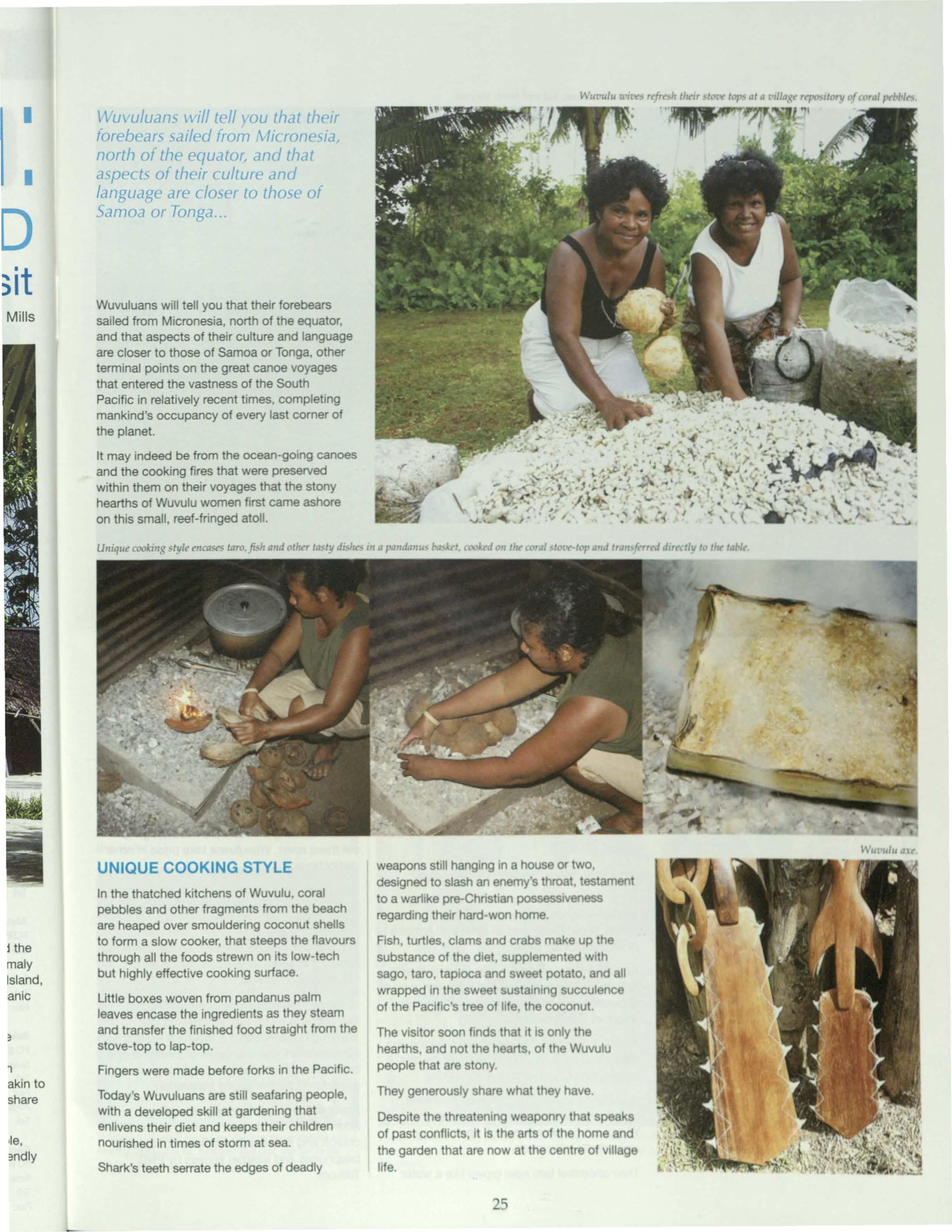
In the thatched kitchens of Wuvulu, coral pebbles and other fragments from the beach are heaped over smouldering coconut shells to form a slow cooker, that steeps the flavours through all the foods strewn on I s low-tech but highly effective cooking surface.
Little boxes woven from pandanus palm leaves encase the ingredients as they steam and transfer the finished food straight from the stove-top to lap-top.
Fingers were made before forks 1nthe Pacific.
Today's Wuvuluans are still seafanng people, with a developed skill at gardening that enlivens their diet and keeps their children nourished in times of stom, at sea.
Shark's teeth serrate the edges of deadly
weapons still hanging in a house or two, designed to slash an enemy's throat, testament to a warlikepre-Chnst1an possessiveness regarding their hard-won home.
Fish, turtles, clams and crabs make up the substance of the diet. supplemented with sago, taro, tapioca and sweet potato, and all wrapped in the sweet sustaining succulenc of the Pacific's tree of life, the coconut.
The visitor soon finds that 1t1sonly the hearths, and not the hearts, of the Wuvulu people that are stony.
They generously share what th y have.
Despite the threatening weaponry that speaks of past conflicts, it is the arts of th home and the garden that are now at the centre of v1llag life.
Milesfrom anywhere,atopa sea-mountanomaly,Wuvulu is very hard to access,but well worth the visit.
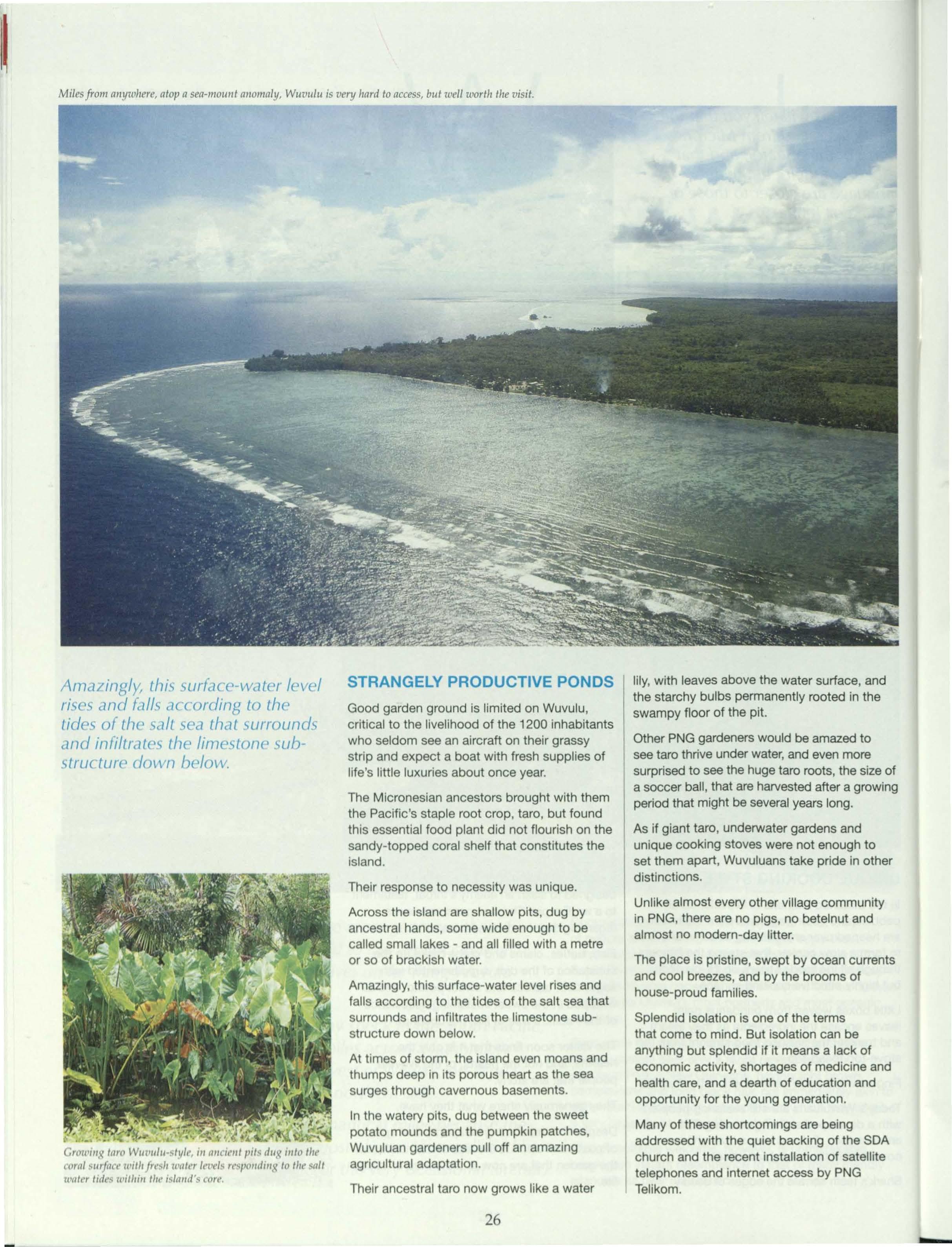
Ama?ingly, this surface-water level risC'sand (c1/lsaccording lo the tides of the sail sea thal surrounds and infiltrc1tes lhe limc5lone substructure clown below.
Good garden ground is limited on Wuvulu, critical to the livelihood of the 1200 inhabitants who seldom see an aircraft on their grassy strip and expect a boat with fresh supplies of life's little luxuries about once year.
The Micronesian ancestors brought with them the Pacific's staple root crop, taro, but found this essential food plant did not flourish on the sandy-topped coral shelf that constitutes the island.
Their response to necessity was unique.
Across the island are shallow pits, dug by ancestral hands, some wide enough to be called small lakes - and all filled with a metre or so of brackish water.
Amazingly, this surface-water level rises and falls according to the tides of the salt sea that surrounds and infiltrates the limestone substructure down below.
At times of storm, the island even moans and thumps deep in its porous heart as the sea surges through cavernous basements.
In the watery pits, dug between the sweet potato mounds and the pumpkin patches, Wuvuluan gardeners pull off an amazing agricultural adaptation.
Their ancestral taro now grows like a water
lily, with leaves above the water surface, and the starchy bulbs permanently rooted in the swampy floor of the pit.
Other PNG gardeners would be amazed to see taro thrive under water, and even more surprised to see the huge taro roots, the size of a soccer ball, that are harvested after a growing period that might be several years long.
As if giant taro, underwater gardens and unique cooking stoves were not enough to set them apart, Wuvuluans take pride in other distinctions.
Unlike almost every other village community in PNG, there are no pigs, no betelnut and almost no modern-day litter.
The place is pristine, swept by ocean currents and cool breezes, and by the brooms of house-proud families.
Splendid isolation is one of the terms that come to mind. But isolation can be anything but splendid if it means a lack of economic activity, shortages of medicine and health care, and a dearth of education and opportunity for the young generation.
Many of these shortcomings are being addressed with the quiet backing of the SDA church and the recent installation of satellite telephones and internet access by PNG Telikom.
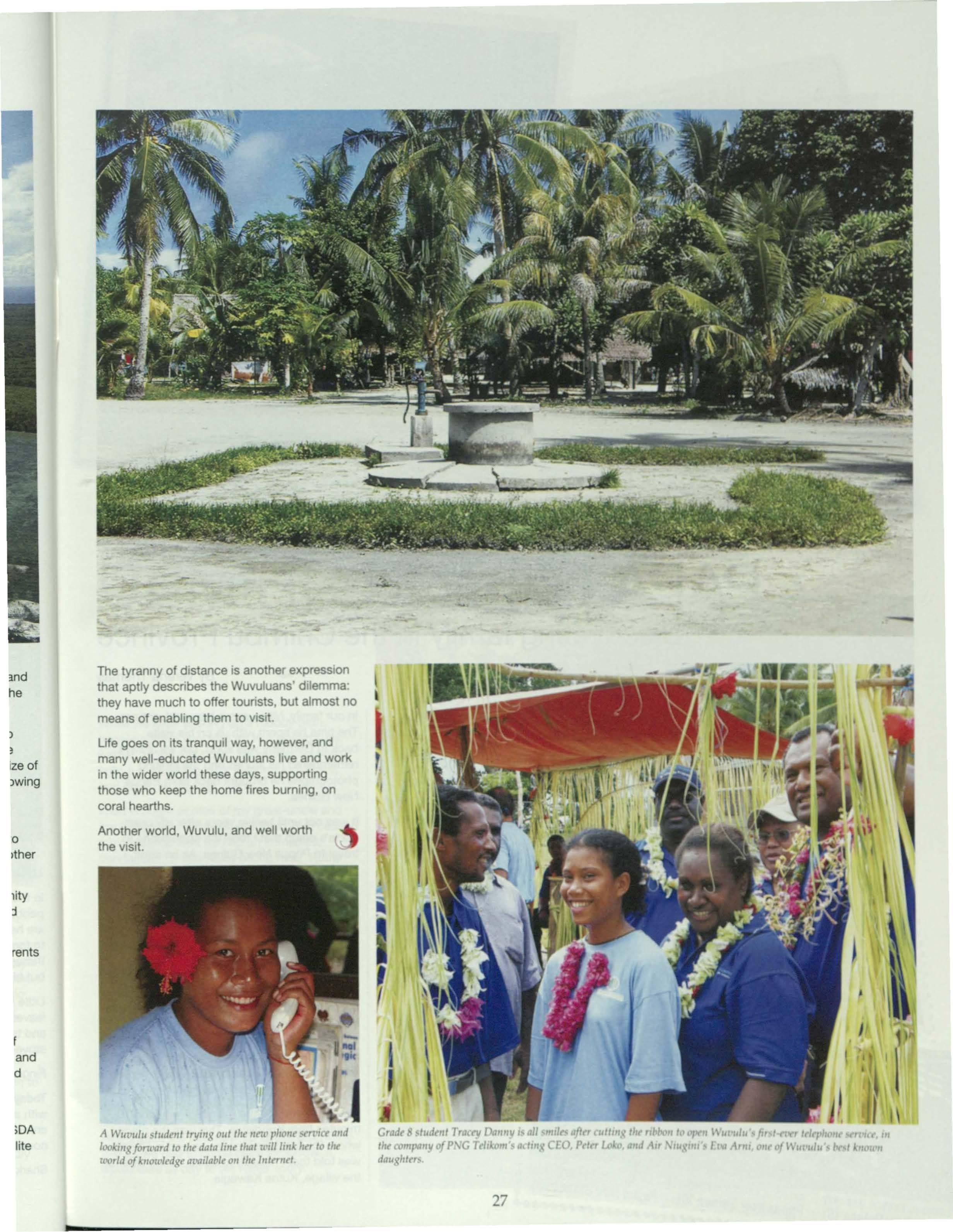
The tyranny of distance is another expression that aptly describes the Wuvuluans' dilemma: they have much to offer tourists, but almost no means of enabling them to visit.
Life goes on its tranquil way, however, and many well-educated Wuvuluans live and work in the wider world these days, supporting those who keep the home fires burning, on coral hearths.
Another world, Wuvulu, and well worth the visit.
By Verena Thomas

y great-uncle John Nilles had always held a great fascination for me, a fascination with his life, with the foreign culture he lived in, with th faraway.
A a child growing up in Germany, I received hi I tt rs with pride. I collected the stamps which w r the most beautiful and most xotic in my collection.
My great-uncle was a Catholic missionary. He was born in 1905 in a small German village lo e to th Fr nch bard r. When he was sent to Papua New Guinea in 7936, he knew he would d vat the rest of hi life to working th r H stay d for 54 y ars.
In our family, Nilles was a brave adventurer. The time he spent with us on his visits back to Germany was short, but we always remembered his stories and the striking photographs he brought back from Papua New Guinea.
It was not until twelve years after my greatuncle's death that I took the opportunity to travel to Papua New Guinea. As an adult, I had become interested in his experiences with the people and questioned his role as a missionary. I felt I had never truly known the man behind the loving letters I received as a child. I wondered what his life had really been about.
When I arrived in the Chimbu province I was overwhelmed by the warm and open welcome the people gave me as Nilles' great-niece and how vividly they remembered him. Everyone wanted to tell me their own personal story about him. I even discovered a few people that were named after John Nilles.
I was advised to first go to Dimbi, a small friendly village, off the main highway and 10 minutes from Kundiawa. This was the place where the first missionaries arrived in Chimbu.l was told that I needed to speak to the elder of the village, Kutne Kawagle.
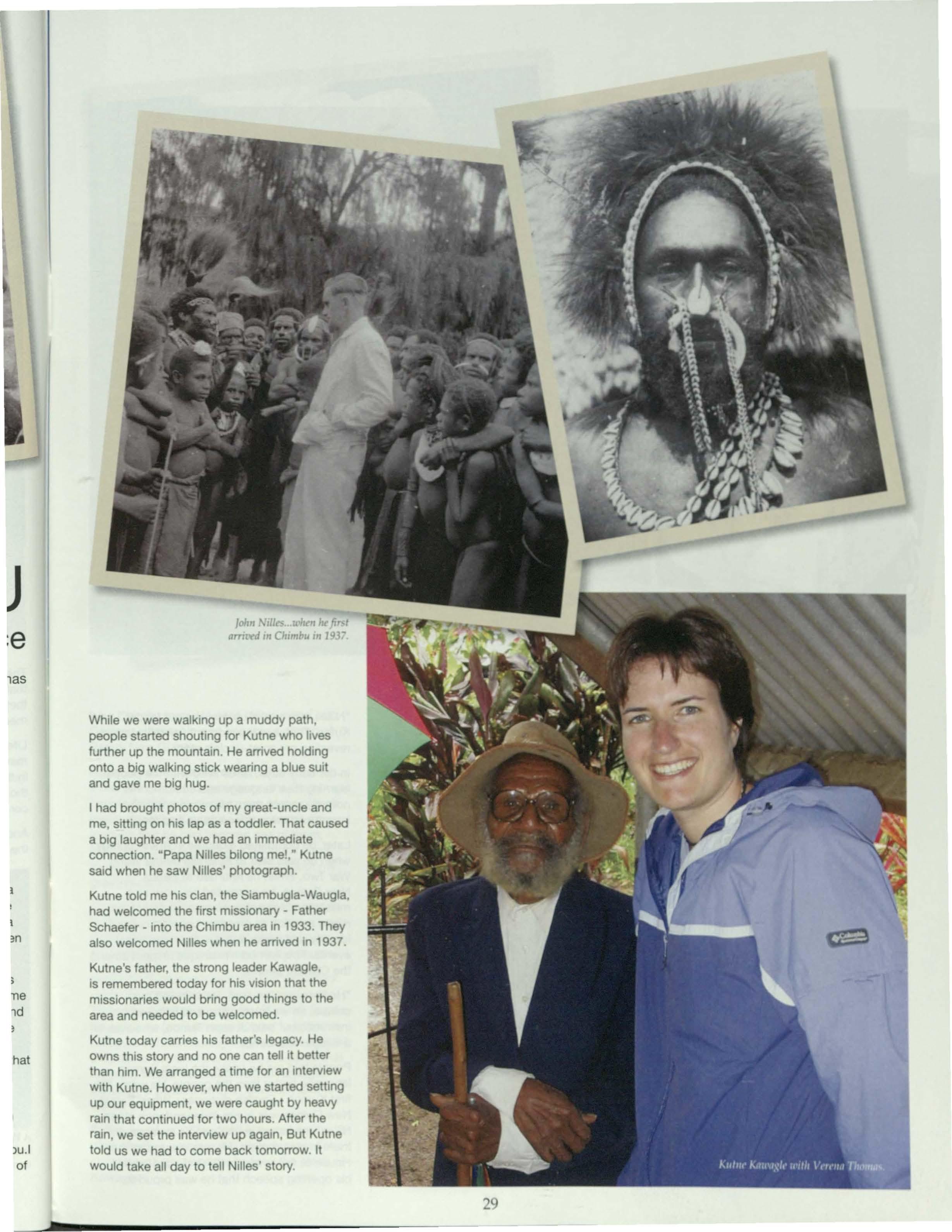
JWhile we were walking up a muddy path, people started shouting for Kutne who lives further up the mountain. He arrived holding onto a big walking stick wearing a blue suit and gave me big hug.
I had brought photos of my great-uncle and me, sitting on his lap as a toddler. That caused a big laughter and we had an immediate connection. "Papa Nilles bilong me!,· Kutne said when he saw Nilles' photograph.
Kutne told me his clan, the Siambugla-Waugla, had welcomed the first mIssIonary - Father Schaefer - into the Chimbu area in 1933. They also welcomed Nilles when he arrived In 1937.
Kutne's father, the strong leader Kawagle, is remembered today for his vision that the missionaries would bring good things to the area and needed to be welcomed.
Kutne today carries his father's legacy. He owns this story and no one can tell 11better than him. We arranged a time for an interview with Kutne. However, when we started setting up our equipment, we were caught by heavy rain that continued for two hours. After the rain, we set the interview up again, But Kutne told us we had to come back tomorrow. It would take all day to tell Nilles' story.

"Nilles was one of us. He was our leader," said Kutne. That was the moment I slowly started revealing my great-uncle's story.
In the early days, Nilles lived with the people, learning their language and customs. He not only taught them his religion, but also introduced them to new tools and foods.
Later, he completed a degree in Anthropology when he was sent to Australia during World War Two. When he returned to Papua New Guinea, he expanded his work as a missionary. Now also an anthropologist, he made an effort to preserve people's cultural identity and participated in their traditional events. This earned him unique respect among the Chimbu people.
"He knew us very well. He followed our culture, so we trusted him and followed his instructions," said Joseph Tembe, who lives in a village near Dimbi.
People told me he spoke the local Kuman language better than the people. He wrote the first Kuman - English dictionary. When Papua New Guinea was in pre-independence stage, Nilles was asked by the people to represent them in government. He was elected to the House of Assembly in 1970. He declared in his opening speech that he was proud to
said
be a Chimbu man. He even relinquished his ~d German citizenship and became a citizen of Papua New Guinea.
le,
Nilles' life as a Chimbu came full circle when, three years after independence, the Siambugla people decided to give him the name of their greatest leader, Kawagle. This was not only to show that he had become one of them, 9gy but one of their outstanding leaders. I came j to realise that I had known so little about my great-uncle's life.
Coming to Chimbu and hearing these stories 31 from the people he lived with for so long made me aware of his involvement and just how nong much 'Papa Nilles' had meant to the people.
However, there was one issue that remained unresolved, which came as a surprise to me.
s Three years before his death, Nilles left Papua ~sin New Guinea for Germany, hoping to improve his health. He left quietly without a farewell. As a leader of the Chimbu, he had promised that his body would be buried next to Kawagle. !the Instead, he passed away in Germany and is oua buried there.
1ge, Kutne explained: "We don't know where he int 16 died. That's a problem. He already signed the in contact with us, because he took the place of Kawagle."
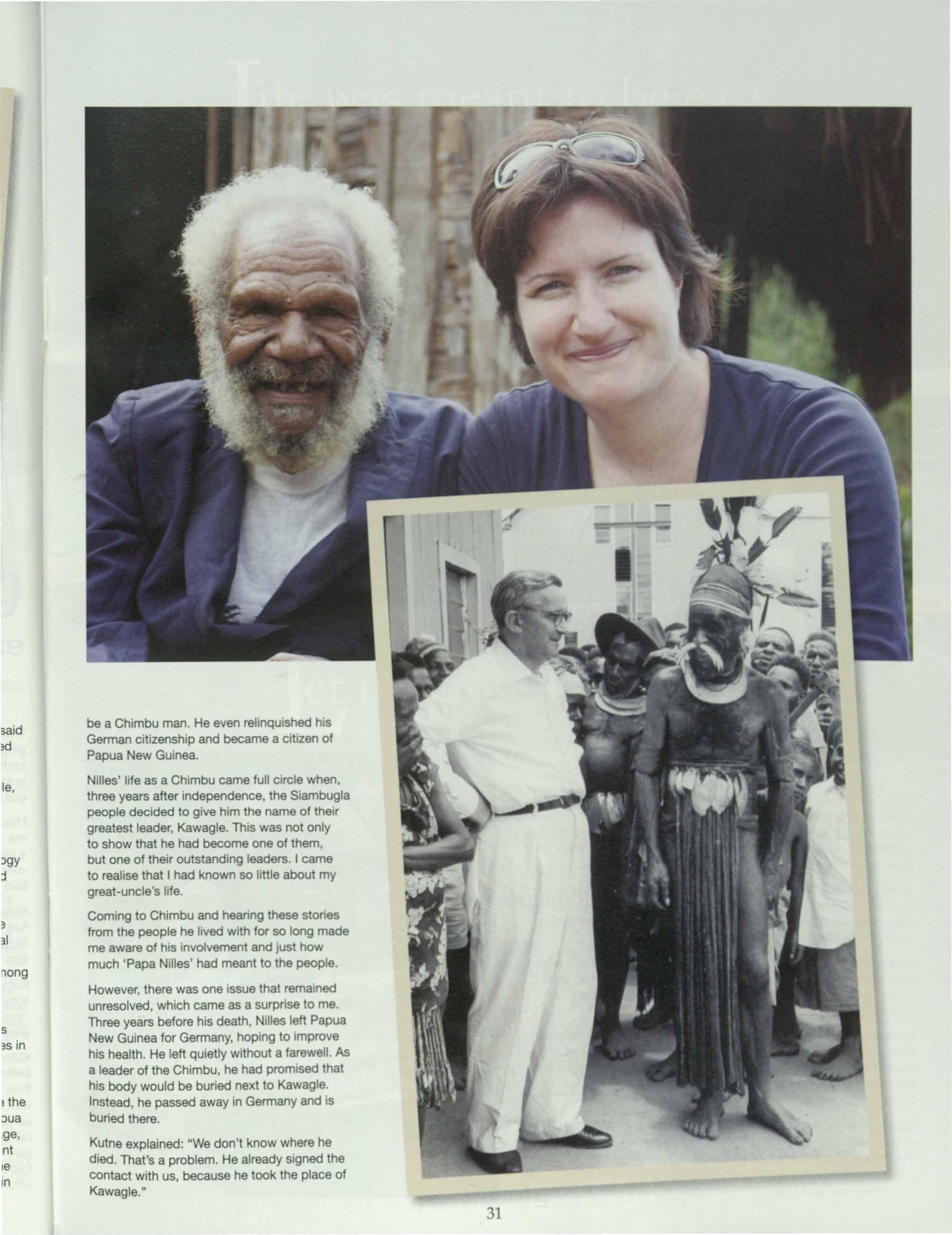
• The Papa Bilong Chimbu DVD can be ordered with Roninfilms: www.roninfilms.com.au
For more information see the website: www.papabilongchimbu.com

Everyone I spoke to expressed similar disappointment about this injustice. Elizabeth Gambugl, who knew Nilles from when she was a young women, said: "You took him to your home and we don't know whether you killed a pig. We are disappointed. We don't know if you gave him a proper burial and party."
Nilles never received a Chimbu funeral. It had never occurred to me that his departure affected the people of Chimbu so strongly. No one in our German family had ever realised the close family connection Nilles had established in Papua New Guinea.
Only now that I had the pieces of the puzzle together and had seen the people's affection for Nilles I realised that something had gone wrong. As a family member going to my great-uncle's place, I felt responsible for it.
In making the film 'Papa Bllong Chlmbu', I wanted to acknowledge the injustice the Chimbu people felt and to create a document for them in recognition of my great-uncle and their shared history, an extraordinary example of cross-cultural exchange and Papua New Guinea family relationships.
Kutne in the end was very happy about my visit and called me his great-grandniece. A new family was certainly not what I expected to find in Papua New Guinea, but the warm and open-hearted people I met In Chlmbu made me discover the life my great-uncle really lived. Now I can understand why he felt so at home with them.
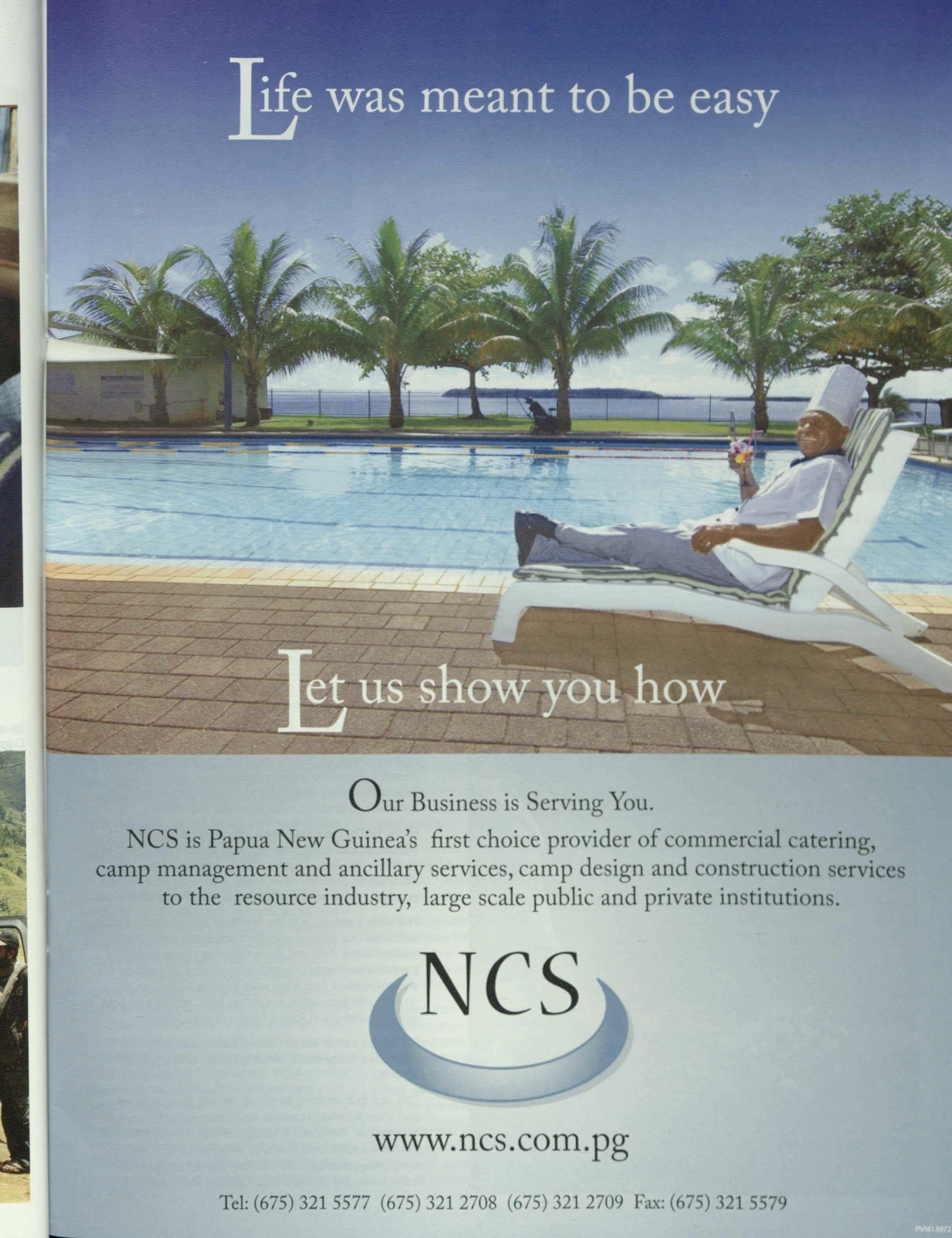
/though unlikely to win an animal beauty contest, the pig-nosed turtle is a unique creature.
It is also gaining a certain amount of attention of late because of the fact that its very existence may be endangered.
By John Brooksbank
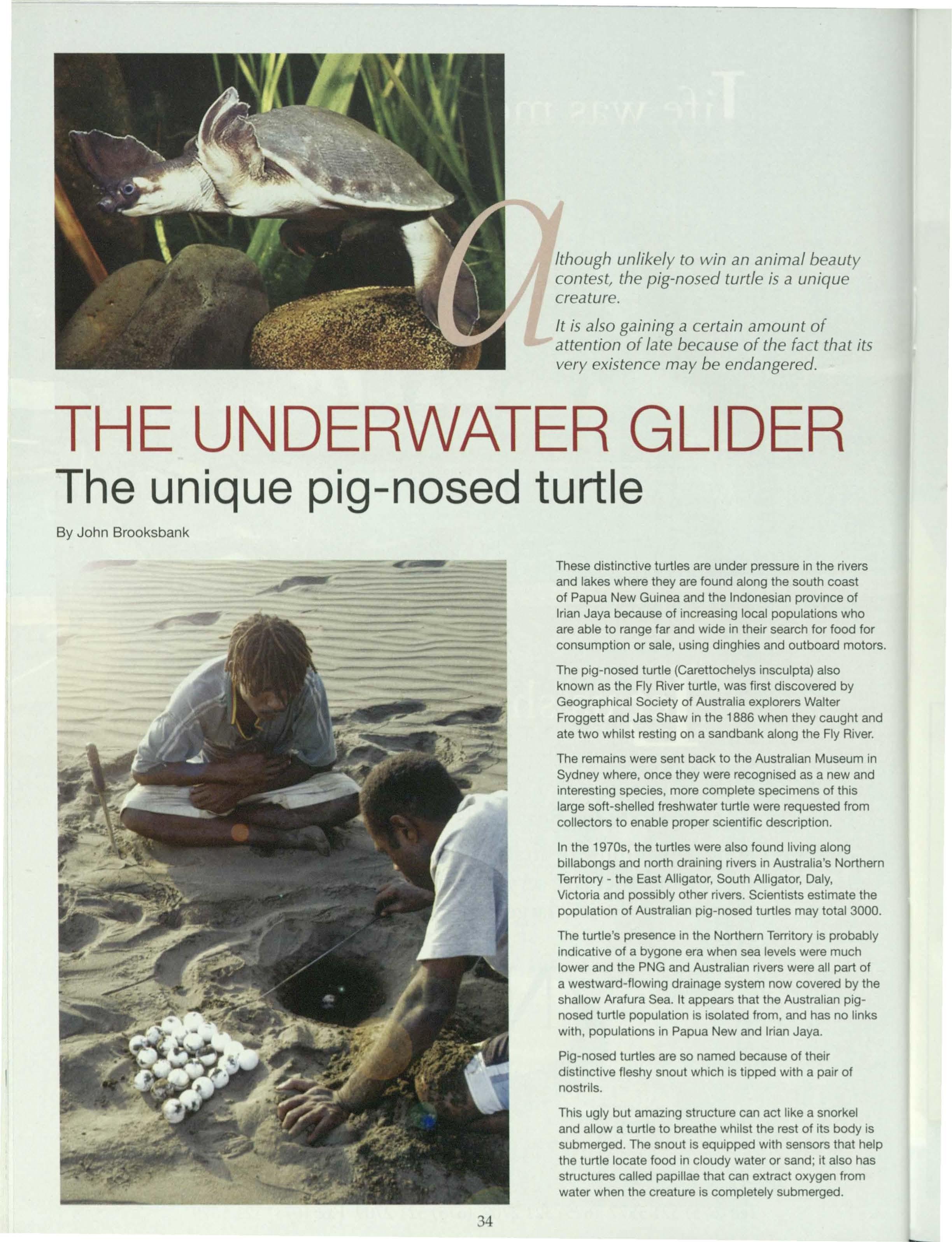
These distinctive turtles are under pressure in the rivers and lakes where they are found along the south coast of Papua New Guinea and the Indonesian province of lrian Jaya because of increasing local populations who are able to range far and wide in their search for food for consumption or sale, using dinghies and outboard motors.
The pig-nosed turtle (Carettochelys insculpta) also known as the Fly River turtle, was first discovered by Geographical Society of Australia explorers Walter Froggett and Jas Shaw in the 1886 when they caught and ate two whilst resting on a sandbank along the Fly River.
The remains were sent back to the Australian Museum in Sydney where, once they were recognised as a new and interesting species, more complete specimens of this large soft-shelled freshwater turtle were requested from collectors to enable proper scientific description.
In the 1970s, the turtles were also found living along billabongs and north draining rivers in Australia's Northern Territory - the East Alligator, South Alligator, Daly, Victoria and possibly other rivers. Scientists estimate the population of Australian pig-nosed turtles may total 3000.
The turtle's presence in the Northern Territory is probably indicative of a bygone era when sea levels were much lower and the PNG and Australian rivers were all part of a westward-flowing drainage system now covered by the shallow Arafura Sea. It appears that the Australian pignosed turtle population is isolated from, and has no links with, populations in Papua New and lrian Jaya.
Pig-nosed turtles are so named because of their distinctive fleshy snout which is tipped with a pair of nostrils.
This ugly but amazing structure can act like a snorkel and allow a turtle to breathe whilst the rest of its body is submerged. The snout is equipped with sensors that help the turtle locate food in cloudy water or sand; it also has structures called papillae that can extract oxygen from water when the creature is completely submerged.
5 or ors. in 1d n 1ern :he 100. bly of the 1ks , is help ,as n

It i estimated that fcmal pig-no. ed turtle c1 not maturity until the , ar 2 \ car of age, wht•n 1d lcJ twice a ear • but trangcl , on/' t'\ er
The pig-nosed turtle shell or carapace has a tough leathery skin that can vary from grey to olive in colour on top and is usually yellow to cream on the underside. Unlike other freshwater turtles the pig-nosed species has two clawed front flippers and webbed hind limbs rather than feet - this reflects a life spent in the water.
These adaptations allow the turtle to accelerate and carry out skilful, almost acrobatic manoeuvres rapidly when under water.
The only time female turtles ever spend time on land is when they come ashore at night to lay eggs on their local river bank or coastal beach.
These turtles can grow to a length of more than 50 centimetres from nose to tail tip and attain a weight of 20 plus kilos, with males being to be smaller than females but having longer and thicker tails. Adults spend a lot of their lives just lying around in their home range waterways • under logs, in sheltered bank overhangs and buried In the bottom litter of leaves, sand, gravel or other material. This seemingly laid back lifestyle is interspersed with bouts of eating both plant and animal food including fruits and leaves, algae, marine invertebrates, crustaceans and perhaps even carrion such as dead fish.
It is estimated that female pig-nosed turtles amazingly do not reach maturity until they are 25 years of age, when they mate and lay eggs twice a year - but strangely only every second
year. Clutches of pig-nosed turtle eggs. often up to 20 in number, look very much like piles of table tennis balls in their spherical shape, size and colour.
Eggs are usually laid during the dry ason and after 60-70 days of development, hatching of full-term embryos Is triggered by ImmersIon in water, as would occur during heavy rain or wet season flooding.
This behavioral adaptation provides hatchhngs with some protection from predators and a better chance of survival.
Like some other species. the sex of offspring is influenced by nest temperature during incubation - warmer nests produce f males and cooler nests males.
Whatever gender they are, pig-nosed turtles are reportedly temtorial and agg~ ssIve creatures, even against th Ir own kind - neck bites and claw marks are commonly found on females after mating.
Harvested from nests and along th waterways, pig-nosed turtle eggs and adults are a common site In K1koriand oth r local riverside markets n Gulf and W t rn provinces as well as being a regular part of village diets. In the K1koriR1v r area, th loc I name for this species Is P1ku.
Along with fish, turtl s are important as a source of protein for communities who traditionally subsisted on the harvesting of sago and whatever they could gath r from
Pending the outcome of current research, th conservation status of pig-nosed turtles is said to be vulnerable
wildlife and diverse cultures it is clear that traditionally wildlife and culture are closely linked.
Thus, to ensure that turtle populations survive as a resource for future generations, good science has to be effectively communicated to the affected local communities.
In association with staff of the WWF Kikori River Programme, also supported by Oil Search Limited, Professor Georges has organised field teams to study a number of aspects of the lives of these unique creatures.
This work includes PhD student Carla Eisemberg and is intended to assess pignosed turtle distribution, population densities, nesting habits, local harvesting regimes and
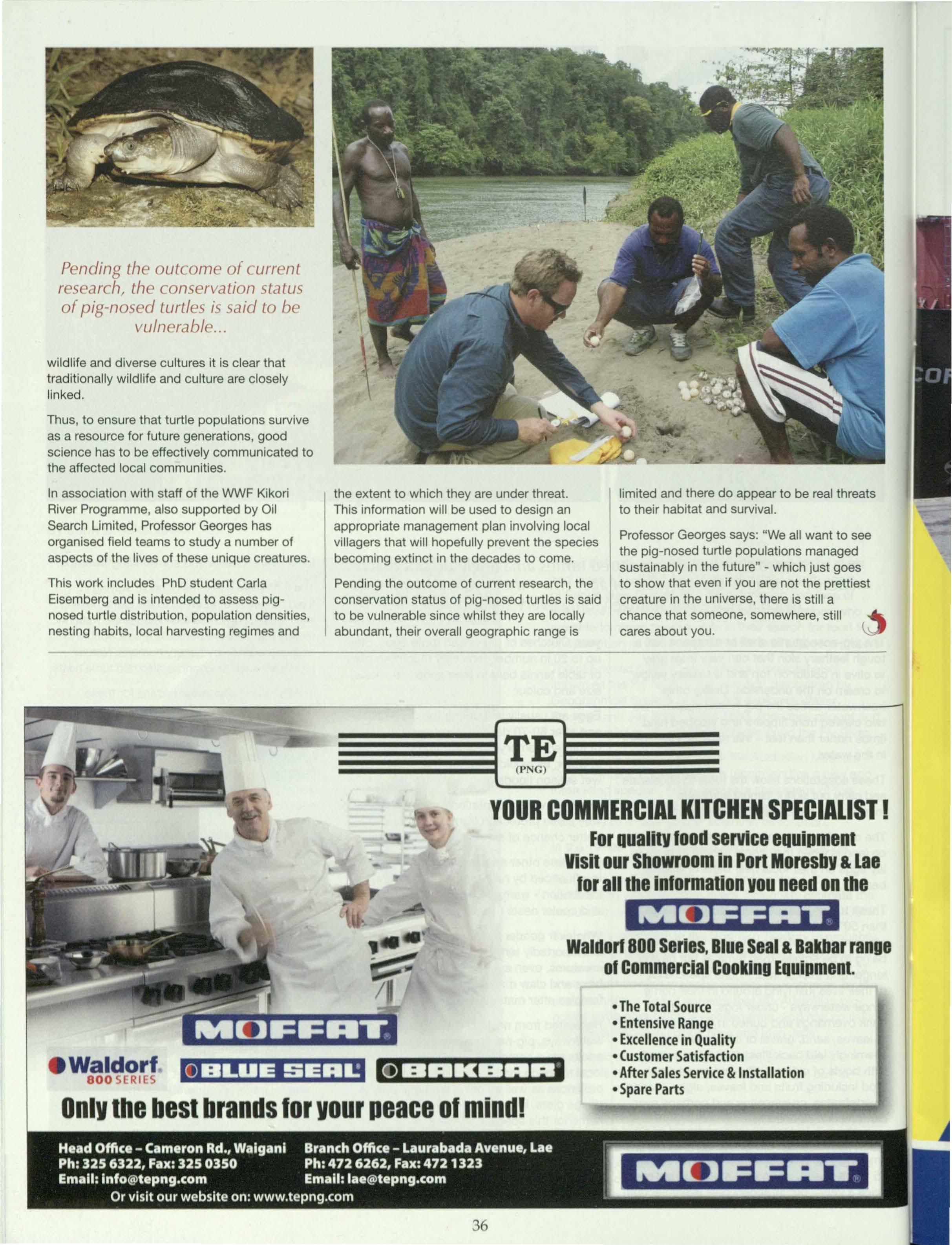
the extent to which they are under threat. This information will be used to design an appropriate management plan involving local villagers that will hopefully prevent the species becoming extinct in the decades to come.
Pending the outcome of current research, the conservation status of pig-nosed turtles is said to be vulnerable since whilst they are locally abundant, their overall geographic range is
limited and there do appear to be real threats to their habitat and survival.
Professor Georges says: "We all want to see the pig-nosed turtle populations managed sustainably in the future" - which just goes to show that even if you are not the prettiest creature in the universe, there is still a chance that someone, somewhere, still ._ cares about you.

Steamshipshavebeenshippingin PNGfor over90y ars.W op ratea fl t of co stalv s I includingtugs& bargesthat specialise in estuarineandnv r trad s in th GulfandW Mn Provincesof PNG.Aswell asprovidinga regular.reliablecargolin r s rvic w op rat short nd longtermchartersfor projectsdemandingspecialistshippingsolution~ In add1t1on to owningvessels,Steamshipsop ratesth larg st shipping g ncybus1nssin PNG, andis a shareholderandmanagerof st vedoringcompanisat th s v n I rg st port St msh1ps ownsa marineengineeringservicesoperationspecialisingin slipwayov rhaulingandshipr p ir. Ourwealthof experience,capabilityandcapacitymak usth id al shippingpartn r. Tel: +675 322 0400 I Fax: +675 321 2815 I www.steamships.com.pg
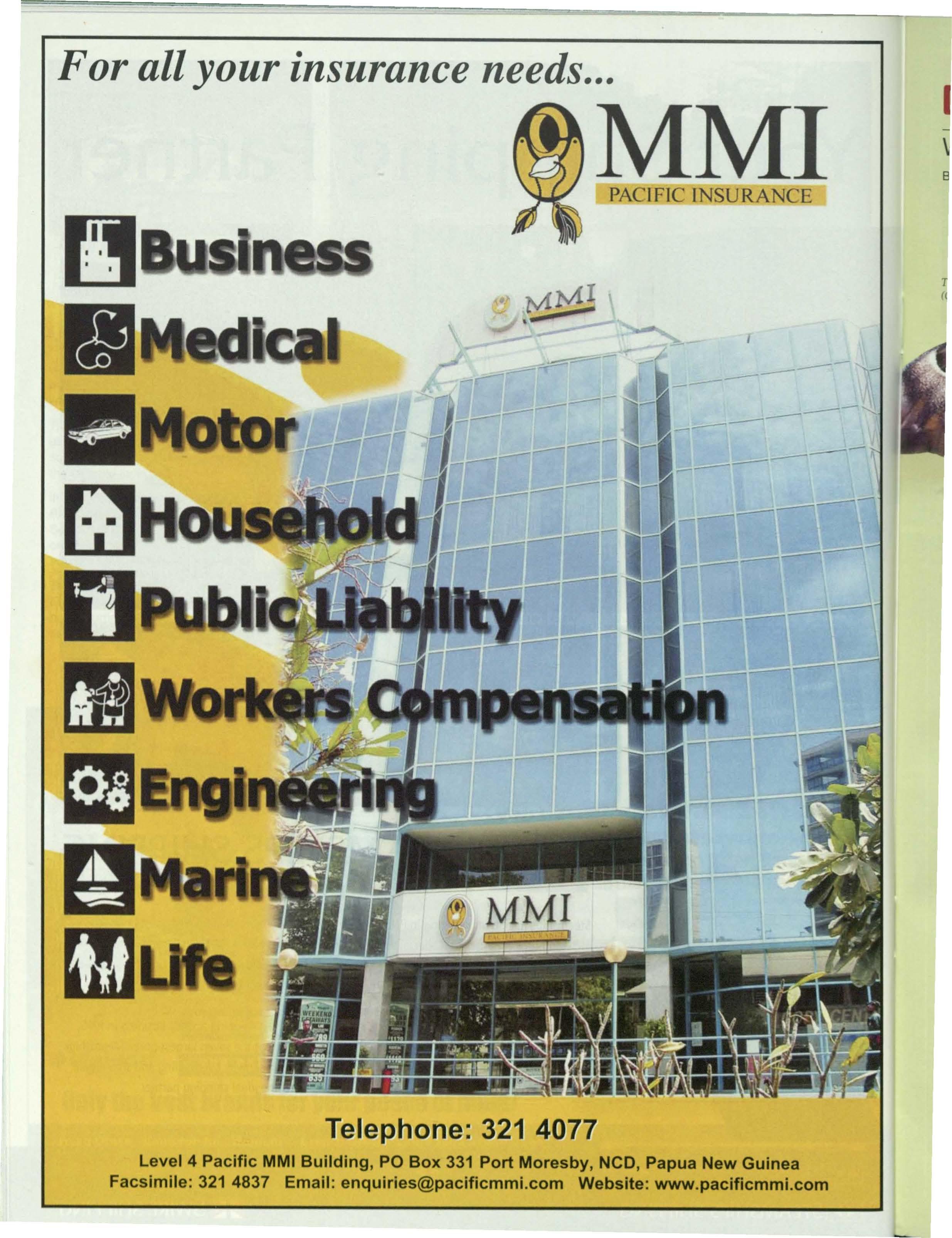
By John Brooksbank
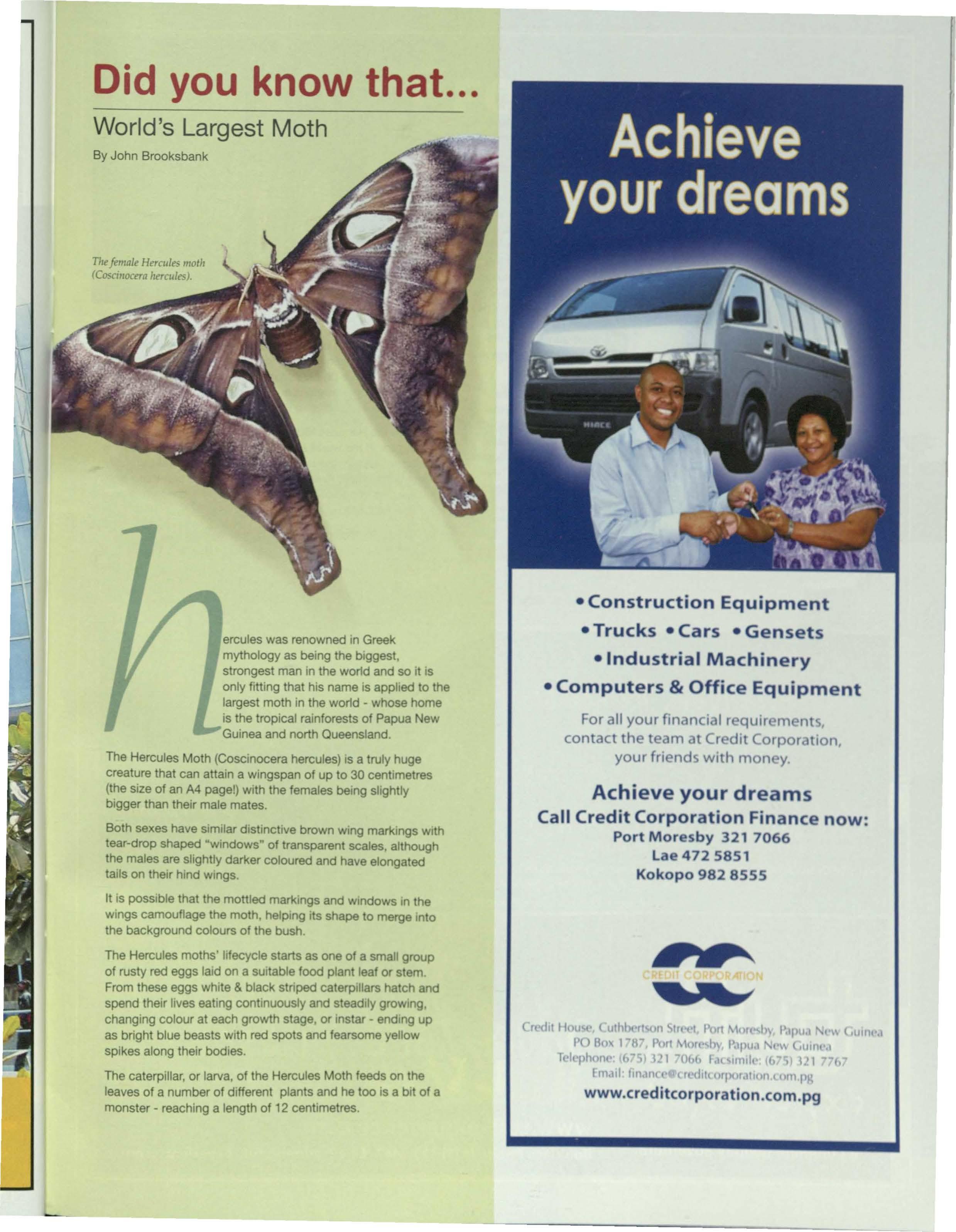
Tirefemale Herculesmot/r (Coscmoceralierrnles).
ercules was renowned in Greek mythology as being the biggest, strongest man in the world and so it is only fitting that his name is applied to the largest moth in the world - whose home is the tropical rainforests of Papua New Guinea and north Queensland.
The Hercules Moth (Coscinocera hercules) is a truly huge creature that can attain a wingspan of up to 30 centimetres (the size of an A4 page!) with the females being slightly bigger than their male mates.
Both sexes have similar distinctive brown wing markings with tear-drop shaped "windows" of transparent scales, although the males are slightly darker coloured and have elongated tails on their hind wings.
It is possible that the mottled markings and windows In the wings camouflage the moth, helping its shape to merge into the background colours of the bush.
The Hercules moths' hfecycle starts as one of a small group of rusty red eggs laid on a suitable food plant leaf or stem. From these eggs white & black stnped caterpillars hatch and spend their lives eating continuously and steadily growing, changing colour at each growth stage, or instar - ending up as bright blue beasts wrth red spots and fearsome yellow spikes along their bodies.
The caterpillar, or larva, of the Hercules Moth feeds on the leaves of a number of different plants and he too 1sa bit of a monster - reaching a length of 12 centimetres.
• Construction Equipment
• Trucks • Cars • Gen sets • Industrial Machinery
• Computers & Office Equipment
For all your fin nc1 I r quir m nt , contact th team t Cr dit Corporation, your fri nds with mon y.
Achieve your dreams
Call Credit Corporation Finance now: Port Moresby 321 7066 Lae 472 5851 Kokopo 982 8555
Level 1 A.Na House HunIer Streel Port Moresby Tel: 321 1880 BrianBellHomemakerCentreGordonaPortMOfesby www.houseofgem,ni.com
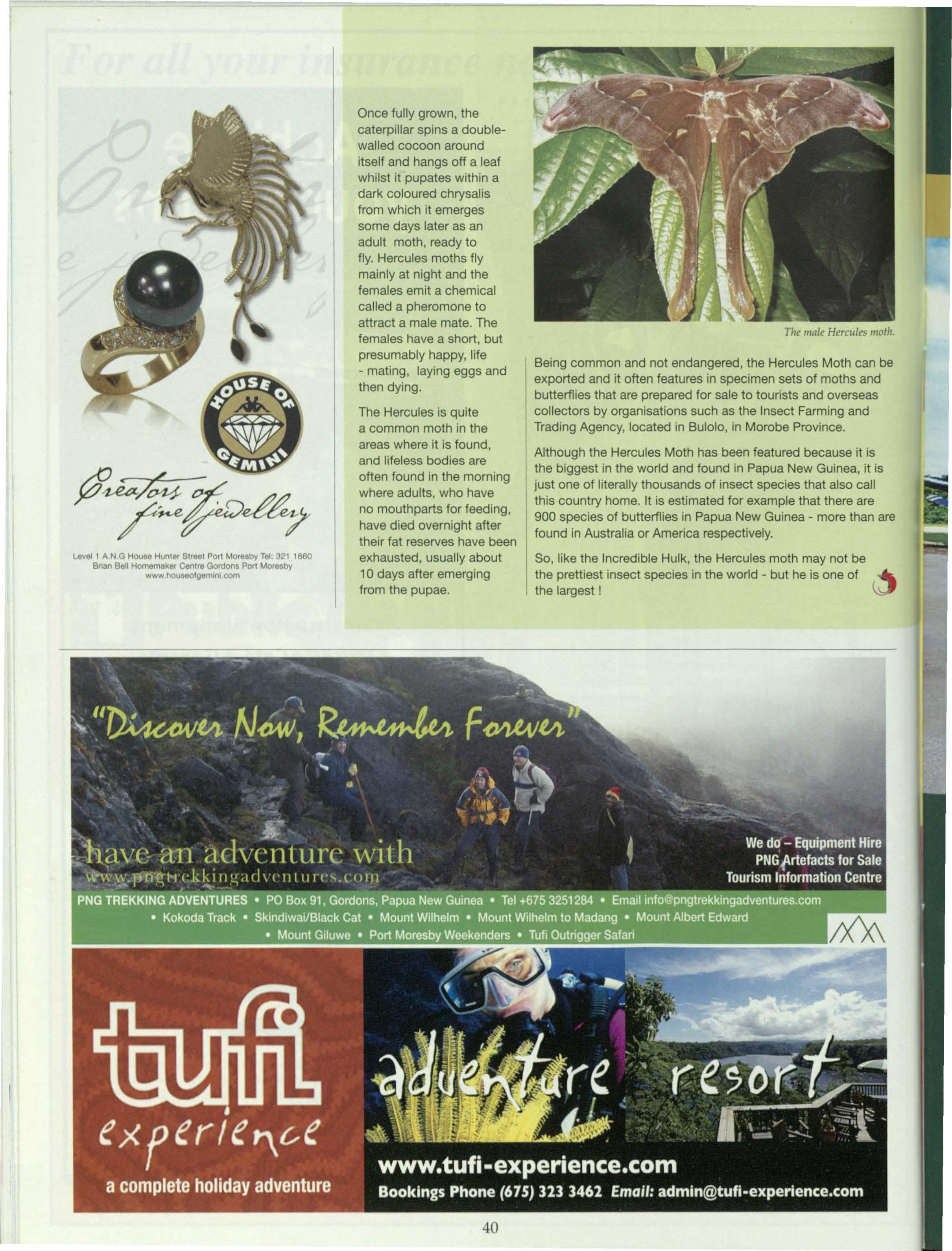
Once fully grown, the caterpillar spins a doublewalled cocoon around itself and hangs off a leaf whilst it pupates within a dark coloured chrysalis from which it emerges some days later as an adult moth, ready to fly. Hercules moths fly mainly at night and the females emit a chemical called a pheromone to attract a male mate. The females have a short, but presumably happy, life - mating, laying eggs and then dying.
The Hercules is quite a common moth in the areas where it is found, and lifeless bodies are often found in the morning where adults, who have no mouthparts for feeding, have died overnight after their fat reserves have been exhausted, usually about 10 days after emerging from the pupae.
Being common and not endangered, the Hercules Moth can be exported and it often features in specimen sets of moths and butterflies that are prepared for sale to tourists and overseas collectors by organisations such as the Insect Farming and Trading Agency, located in Bulolo, in Morobe Province.
Although the Hercules Moth has been featured because it is the biggest in the world and found in Papua New Guinea, it is just one of literally thousands of insect species that also call this country home. It is estimated for example that there are 900 species of butterflies in Papua New Guinea - more than are found in Australia or America respectively.
So, like the Incredible Hulk, the Hercules moth may not be the prettiest insect species in the world - but he is one of the largest !

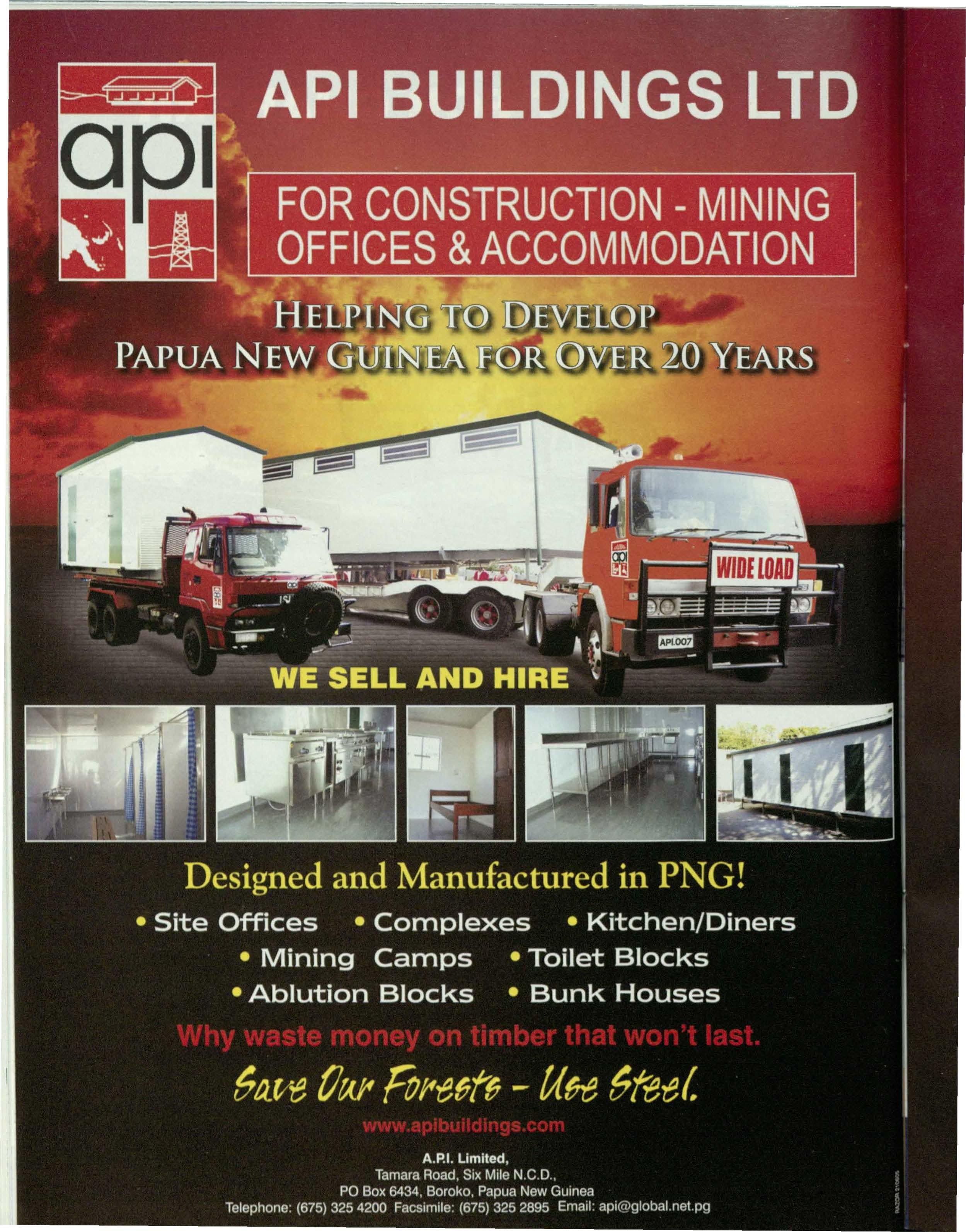

FORCONSTRUCTION - MINING OFFICES & ACCOMMODATION
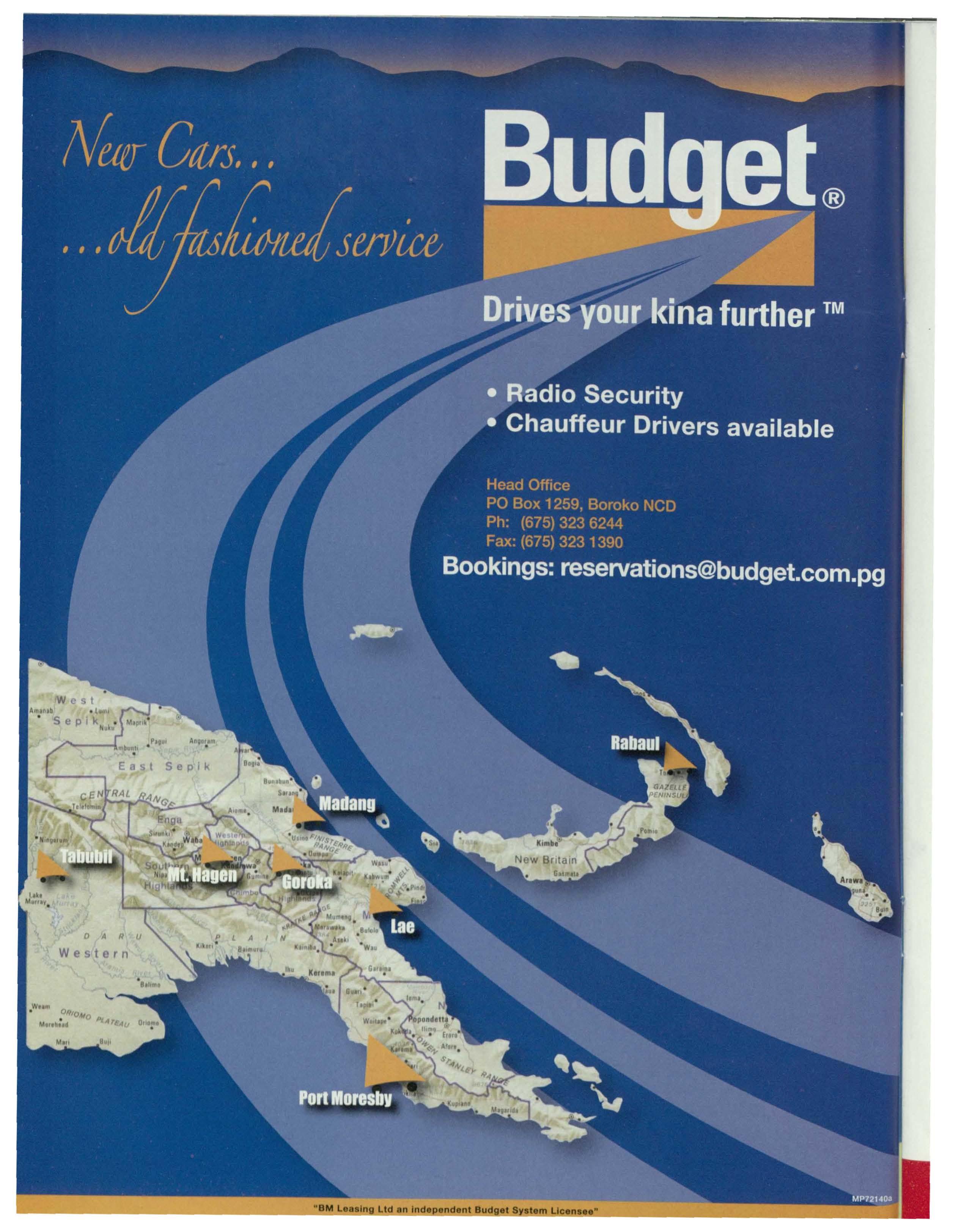
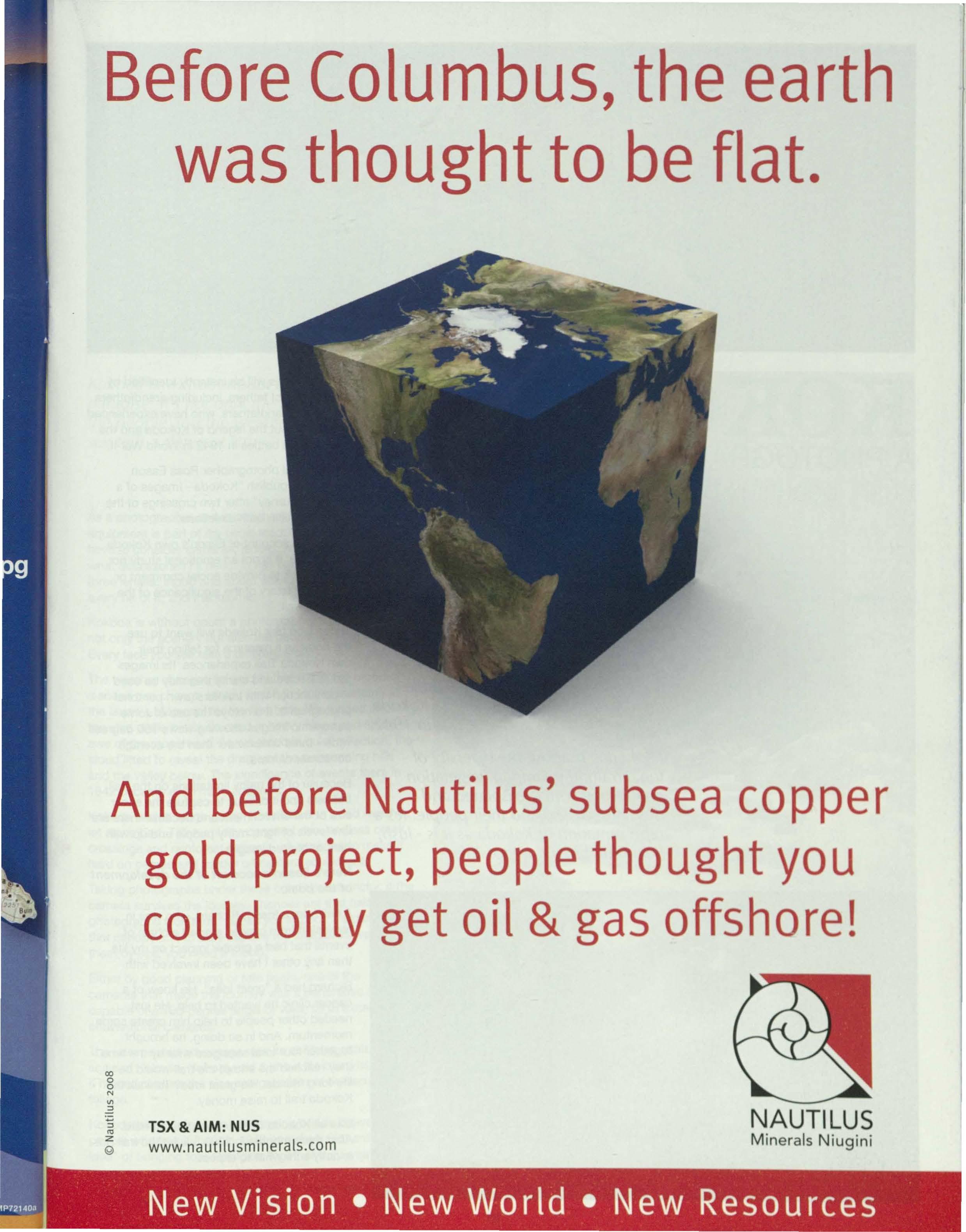
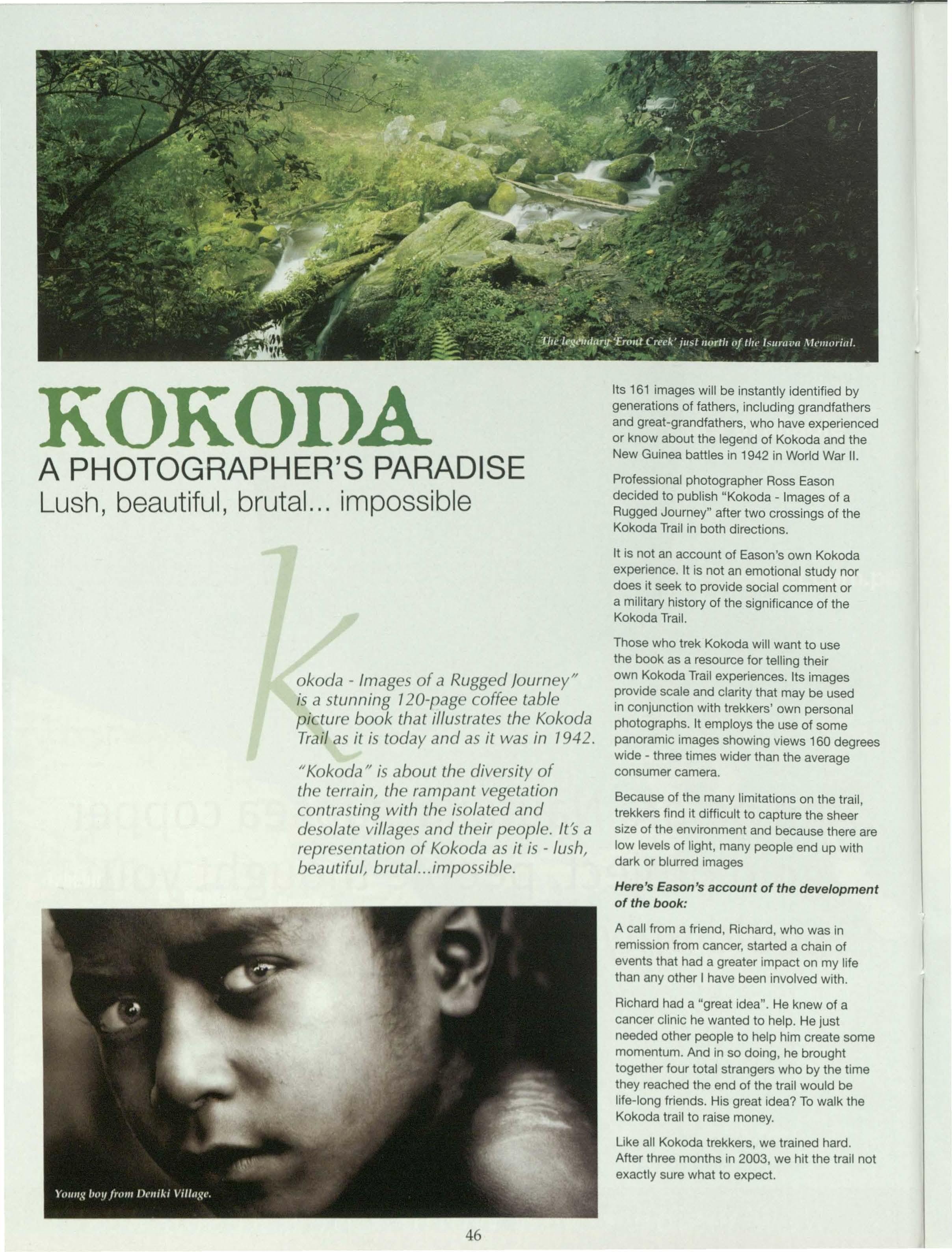
okoda - Images of a Rugged Journey" is a stunning 720-page coffee table pi ture book that illustrates the Kokoda Trail as it is today and as it was in 7942.
"Kokoda" is about the diversity of th terrain, the rampant vegetation contra ting with the i olated and desolate villages and their people. It's a repres ntation of Kokoda as it is - lush, b autiful, brutal .. .impossible.
Its 161 images will be instantly identified by generations of fathers, including grandfathers and great-grandfathers, who have experienced or know about the legend of Kokoda and the New Guinea battles in 1942 in World War II.
Professional photographer Ross Eason decided to publish "Kokoda - Images of a Rugged Journey" after two crossings of the Kokoda Trail in both directions.
It is not an account of Eason's own Kokoda experience. It is not an emotional study nor does it seek to provide social comment or a military history of the significance of the Kokoda Trail.
Those who trek Kokoda will want to use the book as a resource for telling their own Kokoda Trail experiences. Its images provide scale and clarity that may be used in conjunction with trekkers' own personal photographs. It employs the use of some panoramic images showing views 160 degrees wide - three times wider than the average consumer camera.
Because of the many limitations on the trail, trekkers find it difficult to capture the sheer size of the environment and because there are low levels of light, many people end up with dark or blurred images
Here's Eason's account of the development of the book:
A call from a friend, Richard, who was in remission from cancer, started a chain of events that had a greater impact on my life than any other I have been involved with.
Richard had a "great idea". He knew of a cancer clinic he wanted to help. He just needed other people to help him create some momentum. And in so doing, he brought together four total strangers who by the time they reached the end of the trail would be life-long friends. His great idea? To walk the Kokoda trail to raise money.
Like all Kokoda trekkers, we trained hard. After three months in 2003, we hit the trail not exactly sure what to expect.
Kokoda is without doubt a photographer's paradise. It's not only the scenery but also the people and the weather. Every face you see tells a different story.
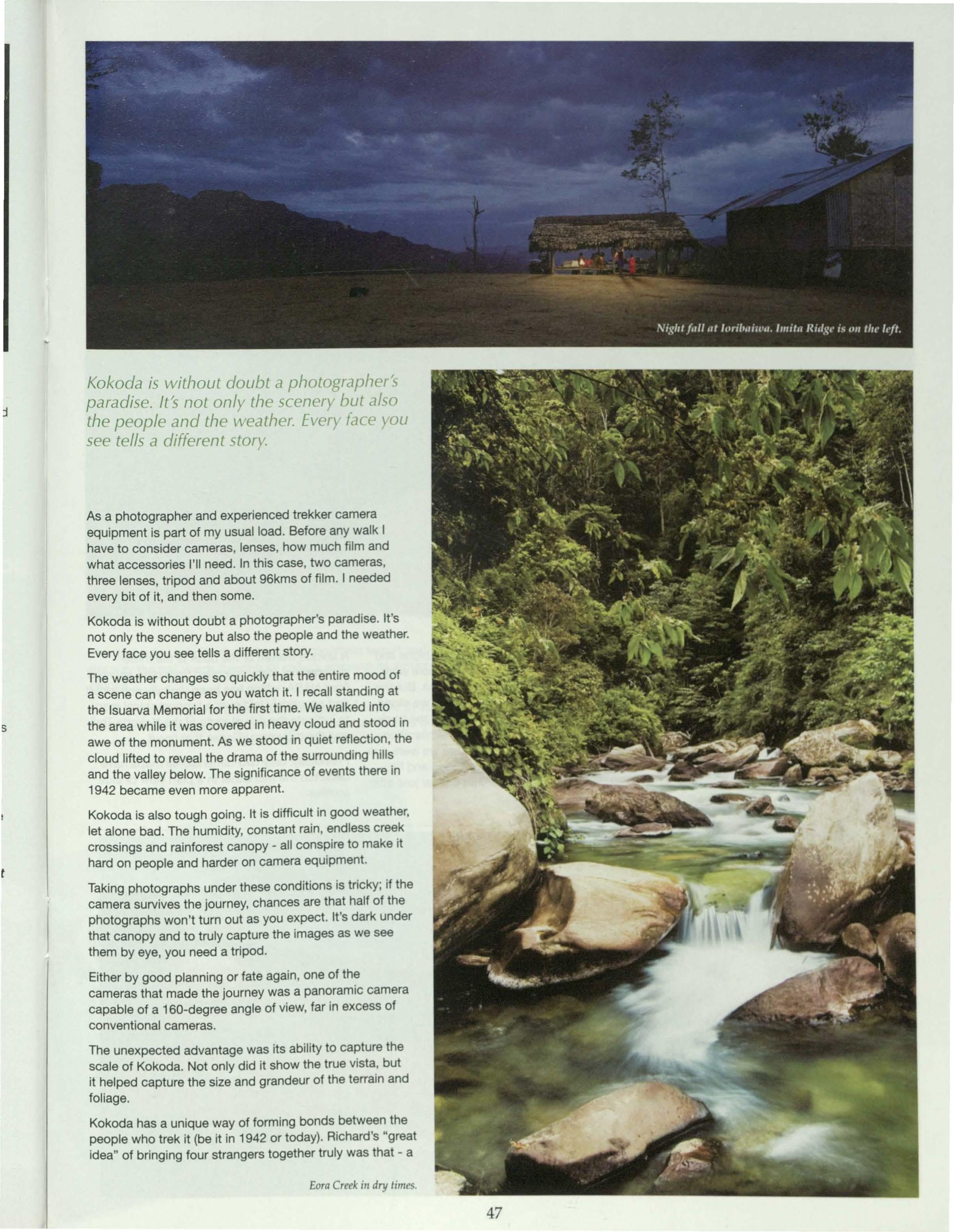
As a photographer and experienced trekker camera equipment is part of my usual load. Before any walk I have to consider cameras, lenses, how much film and what accessories I'll need. In this case, two cameras, three lenses, tripod and about 96kms of film. I needed every bit of it, and then some.
Kokoda is without doubt a photographer's paradise. It's not only the scenery but also the people and the weather. Every face you see tells a different story.
The weather changes so quickly that the entire mood of a scene can change as you watch it. I recall standing at the lsuarva Memorial for the first time. We walked into the area while it was covered in heavy cloud and stood in awe of the monument. As we stood in quiet reflection, the cloud lifted to reveal the drama of the surrounding hills and the valley below. The significance of events there in 1942 became even more apparent.
Kokoda is also tough going. It is difficult in good weather, let alone bad. The humidity, constant rain, endless creek crossings and rainforest canopy - all conspire to make it hard on people and harder on camera equipment.
Taking photographs under these conditions is tricky; if the camera survives the journey, chances are that half of the photographs won't turn out as you expect. It's dark under that canopy and to truly capture the images as we see them by eye, you need a tripod.
Either by good planning or fate again, one of the cameras that made the journey was a panoramic camera capable of a 160-degree angle of view, far in excess of conventional cameras.
The unexpected advantage was its ability to capture the scale of Kokoda. Not only did it show the true vista, but it helped capture the size and grandeur of the terrain and foliage.
Kokoda has a unique way of forming bonds between the people who trek it (be it in 1942 or today). Richard's "great idea" of bringing four strangers together truly was that - a
times.
One oi /lie mn11ywatercoursesbehveenF.ornn11dAloln.
great idea. We raised a little over $100,000 for the cancer clinic and found a friendship and camaraderie that will last forever.
It was at the insistence of these friends that I considered publishing this book. It was also the spur for me returning to Papua New Guinea in 2006 to walk the trail a second time to capture the additional images required to complete the story.
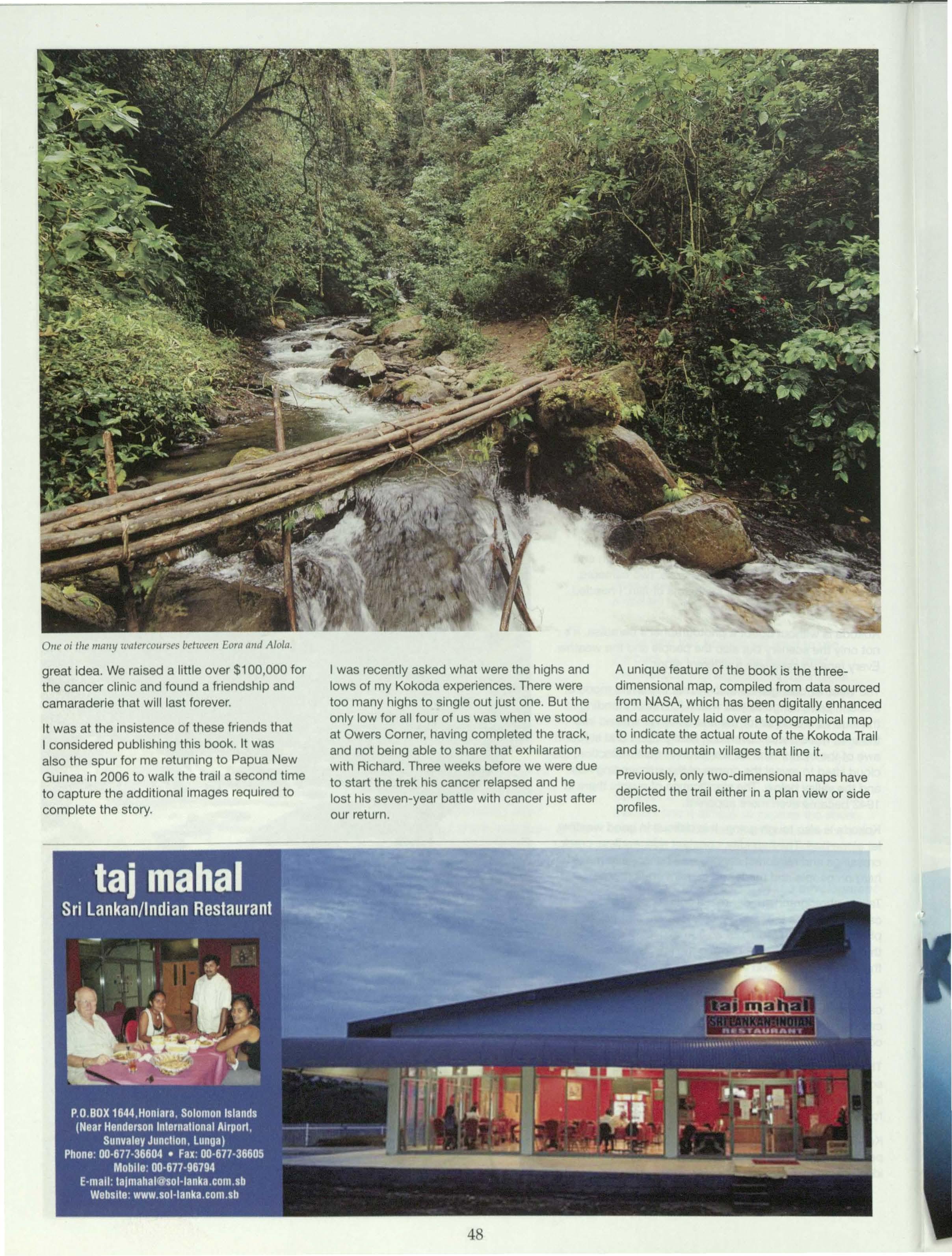
I was recently asked what were the highs and lows of my Kokoda experiences. There were too many highs to single out just one. But the only low for all four of us was when we stood at Owers Corner, having completed the track, and not being able to share that exhilaration with Richard. Three weeks before we were due to start the trek his cancer relapsed and he lost his seven-year battle with cancer just after our return.
A unique feature of the book is the threedimensional map, compiled from data sourced from NASA, which has been digitally enhanced and accurately laid over a topographical map to indicate the actual route of the Kokoda Trail and the mountain villages that line it.
Previously, only two-dimensional maps have depicted the trail either in a plan view or side profiles.

This is the first map to show the actual mountain terrain and the way the trail winds through its valleys and over its mountain ranges.
• 'Kokoda - Images of a Rugged Journey' is published by Eason Creative Photography ($69.95 rrp). For more details. go online to www.trekviews.com or telephone 61 7 5445 6855.
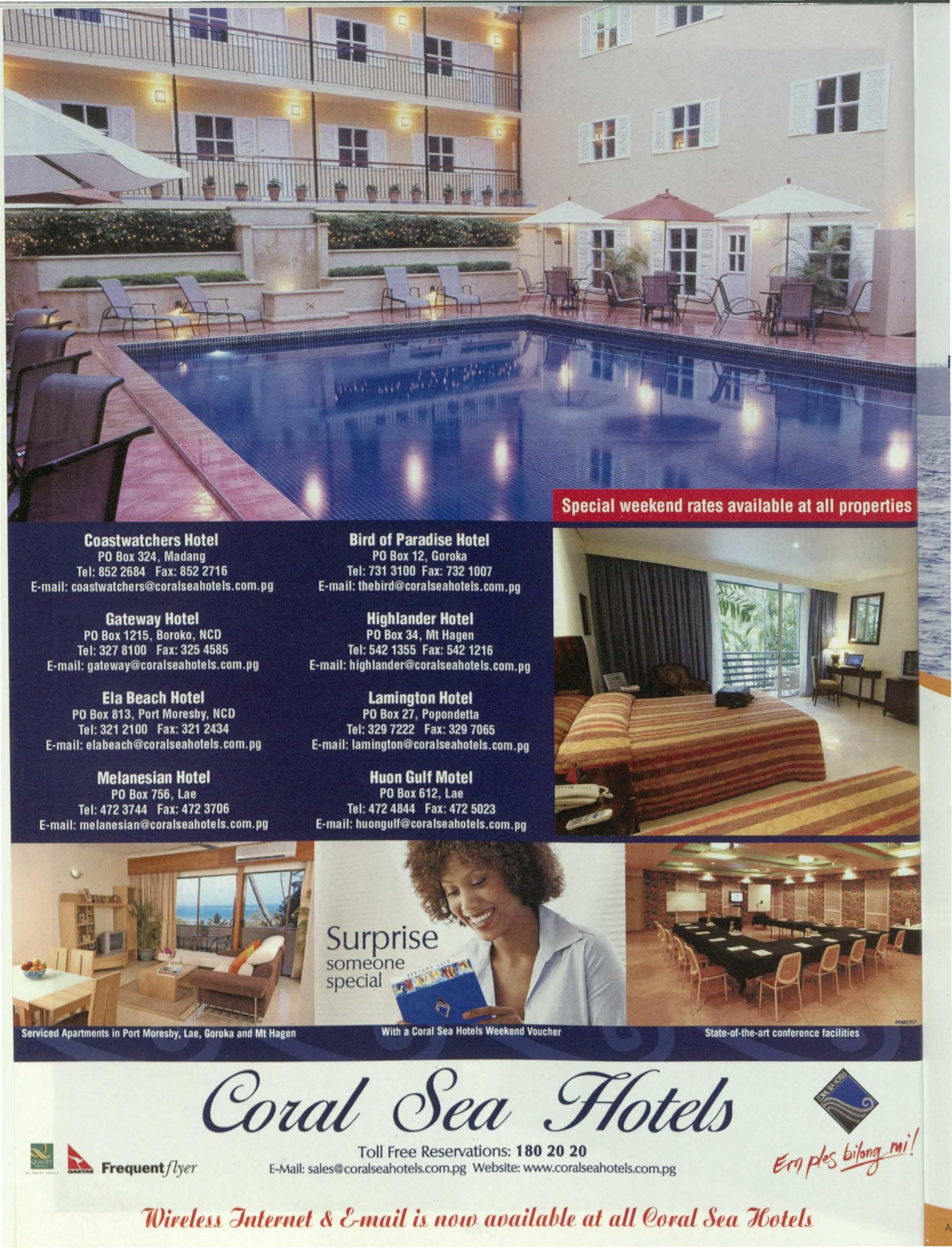
Better links between Asia and Papua New Guinea.
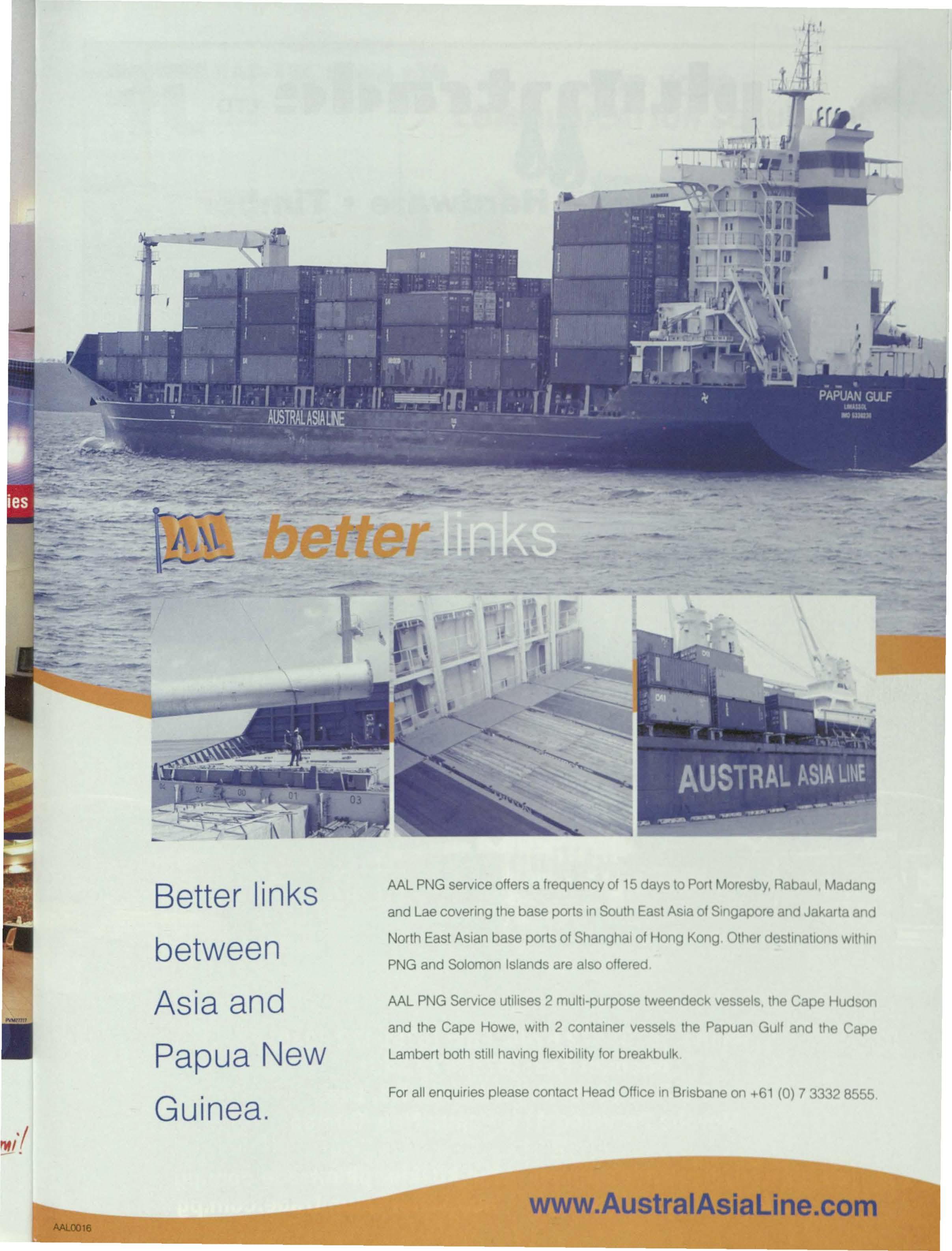
AAL PNG service offers a frequency of 15 days to Port Moresby, Rabaul Madang and Lae covering the base ports In South East Asia of S,ngapore and Jak rta and North East Asian base ports of Shanghai of Hong Kong 0th r dest1nat1onsw1th1n PNG and Solomon Islands are also offered
AAL PNG Service utilises 2 multi-purpose tweendeck vess Is, the Capo Hud on and the Cape Howe, with 2 container vessels the Papuan Gulf and th Cap Lambert both still having flexibility for breakbulk.
For all enquiries please contact Head Office In Brisbane on +61 (0) 7 3332 8555
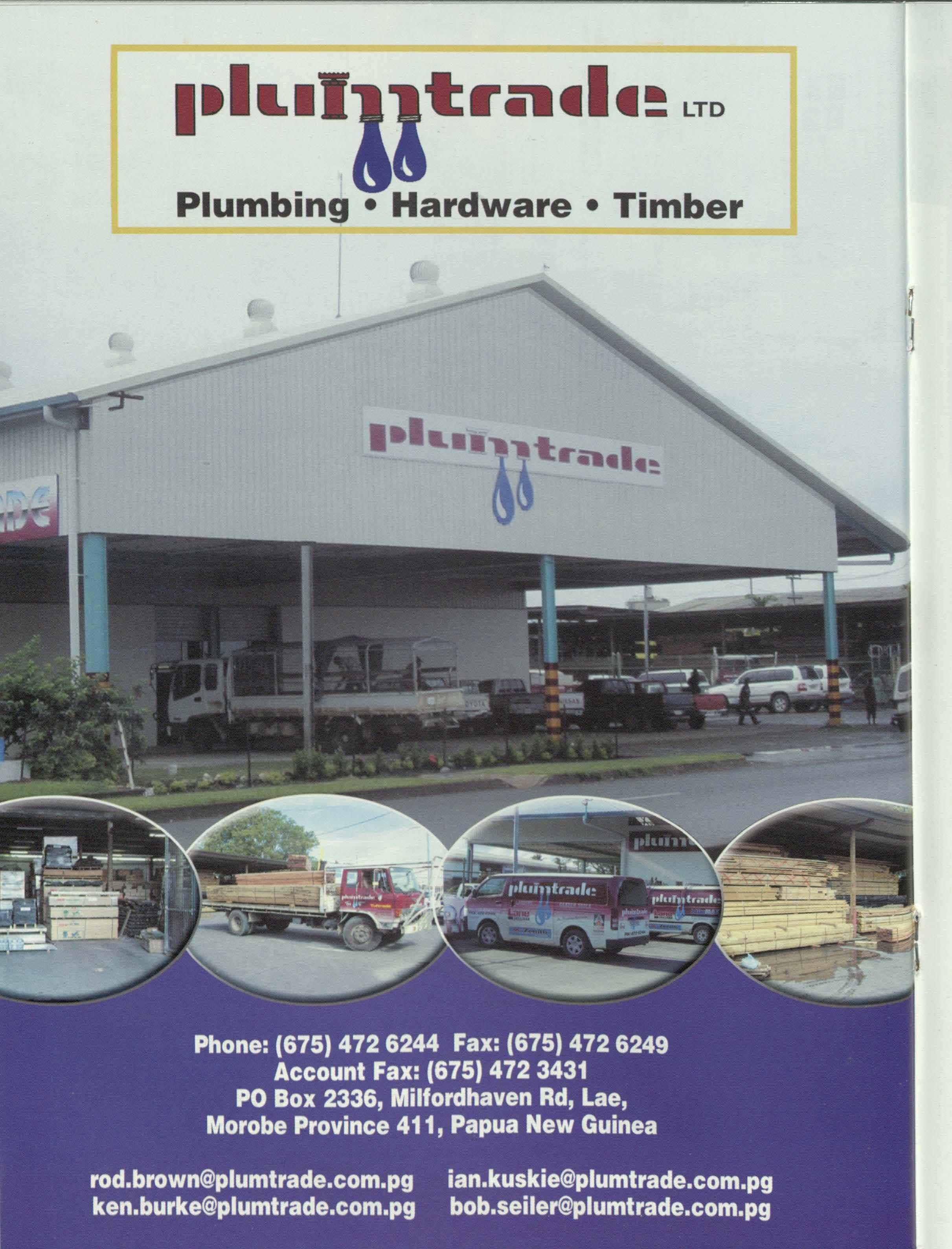
P.O. BOX 43 WAIGANI, NCO
PH: 325 2555(POM} 472 6203(LAE}
FAX:325 0872(POM} 472 7577(LAE}
email: radtel@radtel.com.pg http://www.radtel.com.pg
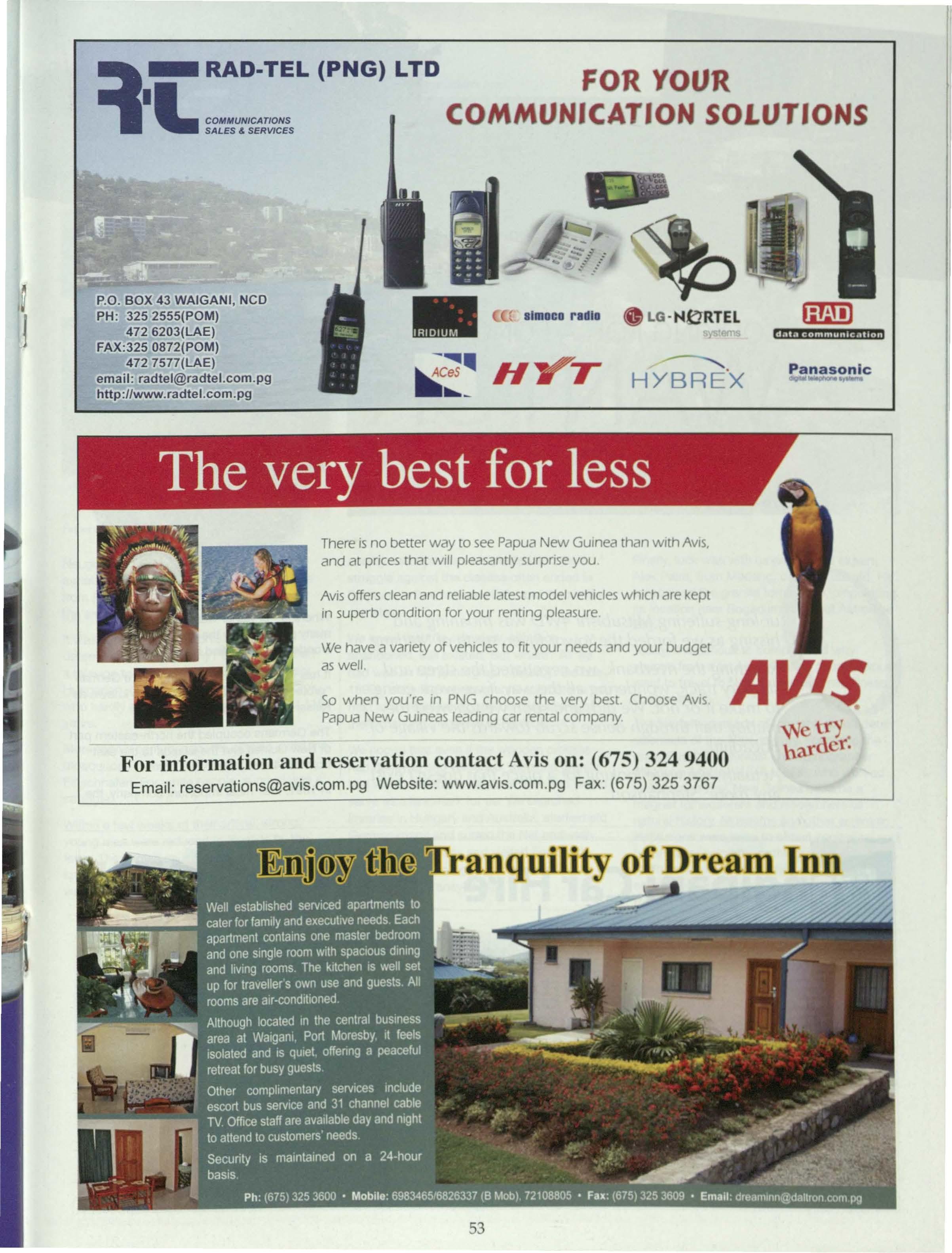
There 1sno better way to see Papua New Guinea than with Avis. and at prices that will pleasantly surprise you
Avis offers clean and reliable latest model vehicles which are kept 1nsuperb condition for your renting pleasure
We have a variety of vehicles to fit your needs and your budget as well.
So when you·re in PNG choose the very best. Choose Avis Papua New Guineas leading car rental company
For information and reservation contact A i on: 675) 324 9400 Email: reservations@avis.com.pg Website: www.avis.com.pg Fax: (675) 325 3767

ur long-suffering Mitsubishi 4WO was moaning and hissing as we forded the Yowor River, south of Madang.
Reaching the riverbank, we negotiated the steep and slippery track, wondering all the way if we were going to make it or not. We did, and soon we followed the muddy trail through dense scrub towards the village of Bogadjim.
Actually, we were looking for a place that doesn't exist any more: Stephansort.
Where is - or rather was - this place? Not many people know the answer and small wonder, you can't find it on the map.
It has faded away, just like the entire German "protectorate" of New Guinea, also known as Kaiser-Wilhelmsland.
The Germans occupied the north-eastern part of New Guinea and the islands to the east from 1884 until 1914.
In 1891, their most important company, the
Paddlingis still thefavoured methodof transportin AstrolabeBay.
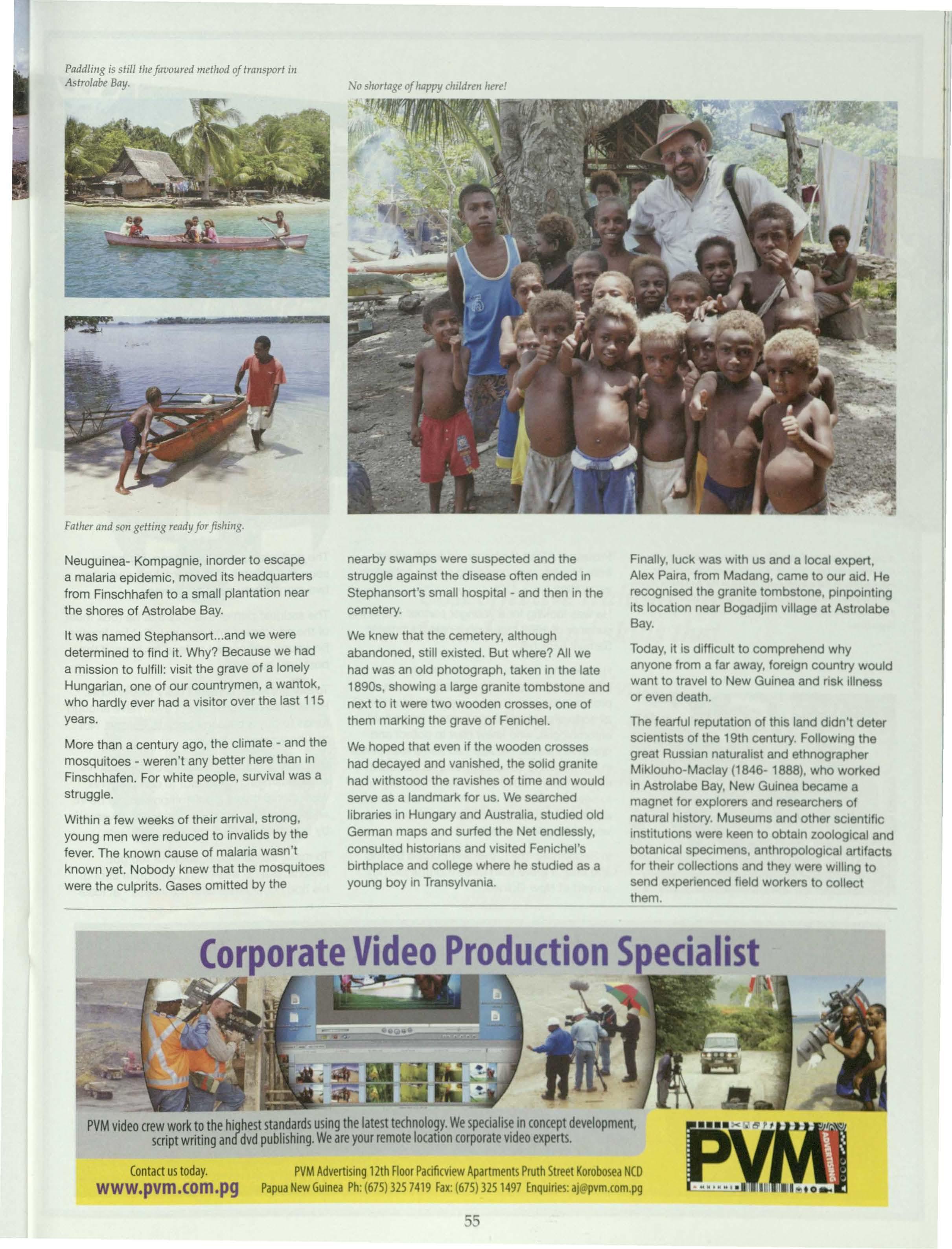
Fatherand so11getti11greadyfor fishing.
Neuguinea- Kompagnie, inorder to escape a malaria epidemic, moved its headquarters from Finschhafen to a small plantation near the shores of Astrolabe Bay.
It was named Stephansort and we were determined to find it. Why? Because we had a mission to fulfill: visit the grave of a lonely Hungarian, one of our countrymen, a wantok, who hardly ever had a visitor over the last 115 years.
More than a century ago, the climate - and the mosquitoes - weren't any better here than in Finschhafen. For white people, survival was a struggle.
Within a few weeks of their arrival, strong, young men were reduced to invalids by the fever. The known cause of malaria wasn't known yet. Nobody knew that the mosquitoes were the culprits. Gases omitted by the
nearby swamps were suspected and the struggle against the disease often ended in Stephansort's small hospital - and then in the cemetery.
We knew that the cemetery, although abandoned, still existed. But where? All we had was an old photograph, taken in the late 1890s, showing a large granite tombstone and next to it were two wooden crosses, one of them marking the grave of Fenichel.
We hoped that even if the wooden crosses had decayed and vanished, the solid granite had withstood the ravishes of time and would serve as a landmark for us. We searched libraries in Hungary and Australia, studied old German maps and surfed the Net endlessly, consulted historians and visited Fenichel's birthplace and college where he studied as a young boy in Transylvania.
Finally, luck was with us and a local expert, Alex Paira, from Madang, came to our aid. He recognised the granite tombstone, pinpointing its location near Bogadjim village at Astrolabe Bay.
Today, it is difficult to comprehend why anyone from a far away, foreign country would want to travel to New Guinea and risk illness or even death.
The fearful reputation of this land didn't deter scientists of the 19th century. Following the great Russian naturalist and ethnographer Miklouho-Maclay (1846- 1888), who worked in Astrolabe Bay, New Guinea became a magnet for explorers and researchers of natural history. Museums and other scientific institutions were keen to obtain zoological and botanical specimens, anthropological art1facts for their collections and they were willing to send experienced field workers to collect them.
A sing-sing was performedby the peopleof Bogadjimlo co111111e111orale the occasio11.K1111dudrums dictated the 111ove111e11ls of the rla11cersa11d111a11y of the Bogadjimpeople participatedi11a spiritedsi11g-sing.Ca11ocsas headoma111e11lssymbolisedthe sea-faringtraditionsof the peopleat Bogadji111.
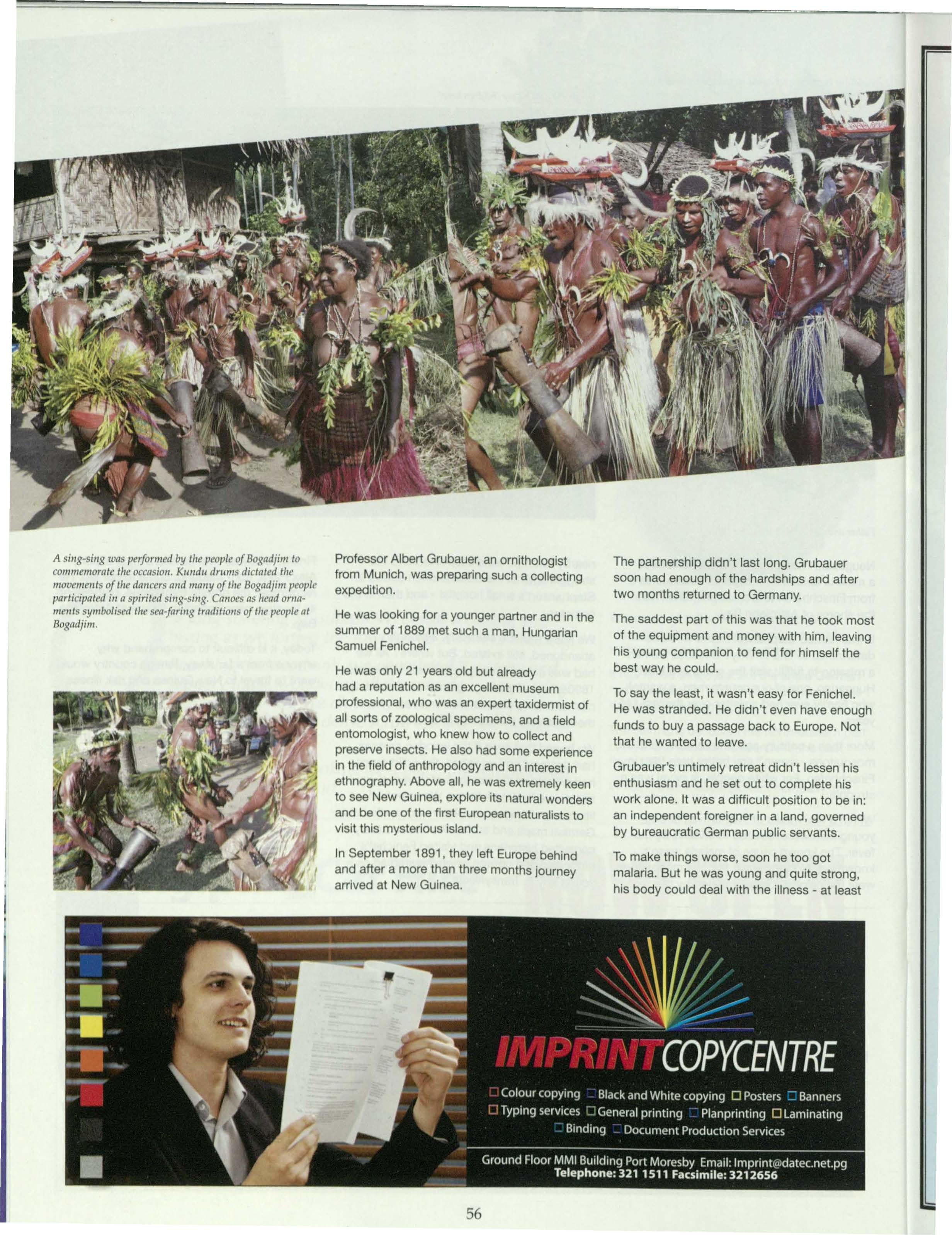
Professor Albert Grubauer, an ornithologist from Munich, was preparing such a collecting expedition.
He was looking for a younger partner and in the summer of 1889 met such a man, Hungarian Samuel Fenichel.
He was only 21 years old but already had a reputation c1san excellent museum professional, who was an expert taxidermist of all sorts of zoological specimens, and a field entomologist, who knew how to collect and preserve insects. He also had some experience in the field of anthropology and an interest in ethnography. Above all, he was extremely keen to see New Guinea, explore its natural wonders and be one of the first European naturalists to visit this mysterious island.
In September 1891, they left Europe behind and after a more than three months journey arrived at New Guinea.
The partnership didn't last long. Grubauer soon had enough of the hardships and after two months returned to Germany.
The saddest part of this was that he took most of the equipment and money with him, leaving his young companion to fend for himself the best way he could.
To say the least, it wasn't easy for Fenichel. He was stranded. He didn't even have enough funds to buy a passage back to Europe. Not that he wanted to leave.
Grubauer's untimely retreat didn't lessen his enthusiasm and he set out to complete his work alone. It was a difficult position to be in: an independent foreigner in a land, governed by bureaucratic German public servants.
To make things worse, soon he too got malaria. But he was young and quite strong, his body could deal with the illness - at least

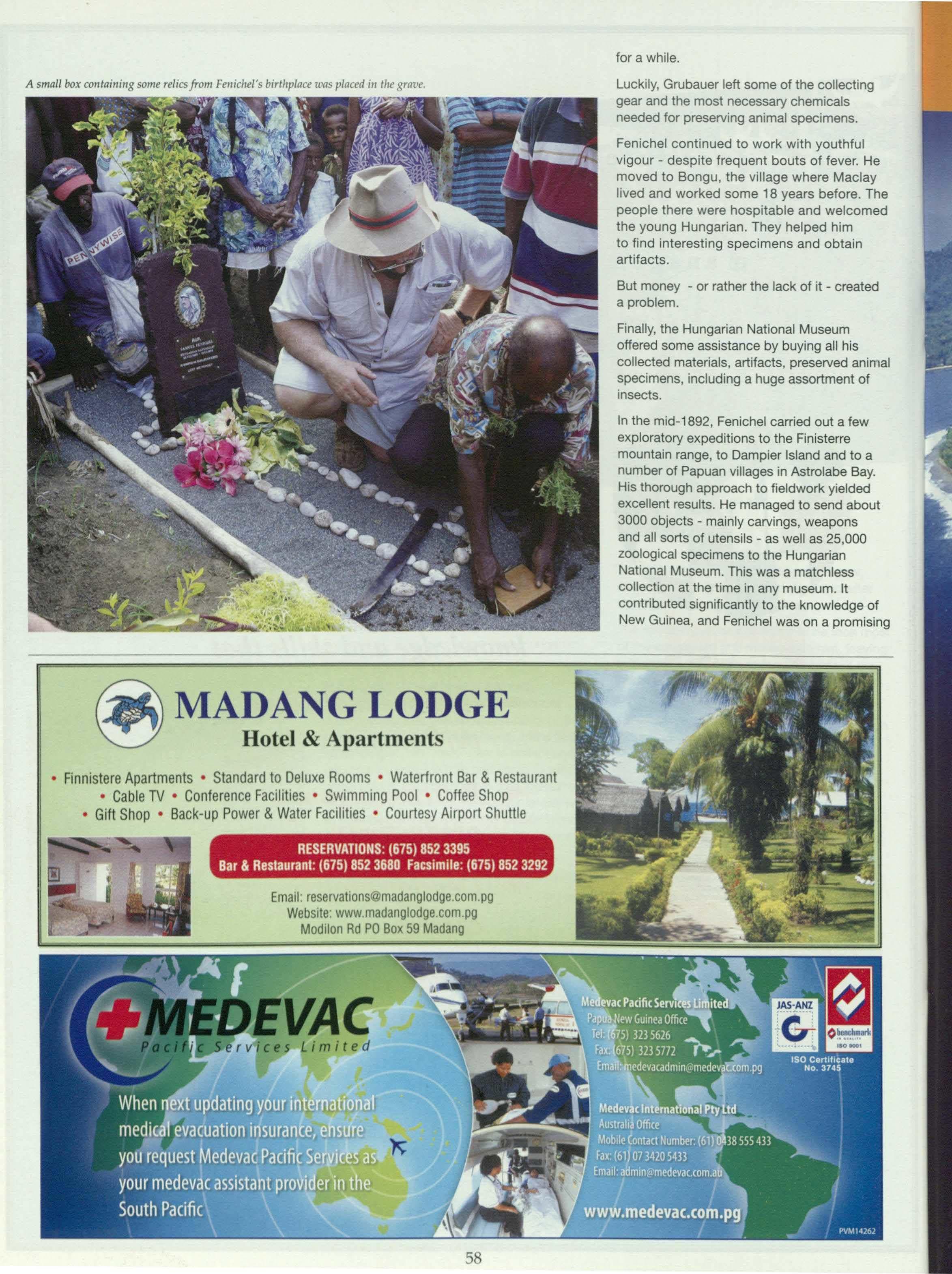
for a while.
Luckily, Grubauer left some of the collecting gear and the most necessary chemicals needed for preserving animal specimens.
Fenichel continued to work with youthful vigour - despite frequent bouts of fever. He moved to Bongu, the village where Maclay lived and worked some 18 years before. The people there were hospitable and welcomed the young Hungarian. They helped him to find interesting specimens and obtain artifacts.
But money - or rather the lack of it - created a problem.
Finally, the Hungarian National Museum offered some assistance by buying all his collected materials, artifacts, preserved animal specimens, including a huge assortment of insects.
In the mid-1892, Fenichel carried out a few exploratory expeditions to the Finisterre mountain range, to Dampier Island and to a number of Papuan villages in Astrolabe Bay. His thorough approach to fieldwork yielded excellent results. He managed to send about 3000 objects - mainly carvings, weapons and all sorts of utensils - as well as 25,000 zoological specimens to the Hungarian National Museum. This was a matchless collection at the time in any museum. It contributed significantly to the knowledge of New Guinea, and Fenichel was on a promising

• Idealenvironmentforcorporatetravellersand consultantsin centrallocations
• Daily,weeklyandmonthlyratesavailablefor 1,2 and 3-bedroomapartments
• Apartmentsserviced6 daysperweek
• State-of-the-artkitchen,in-roomelectronicsafe, laundryservice,bestavailablecableTVwithmovie channels,24hoursecurityandmaintenancewith on-sitemanagement,back-upgensetandwateretc
• Useof all usualhotelfacilitiesincludingroomservice andfreeE-mailaccesseachdaybetween5pmand 10pm fromthe hotel'sBusinessCentre Serviced apartments in: PORTMORESBYo LAE o GOROKA o MT. HAGEN
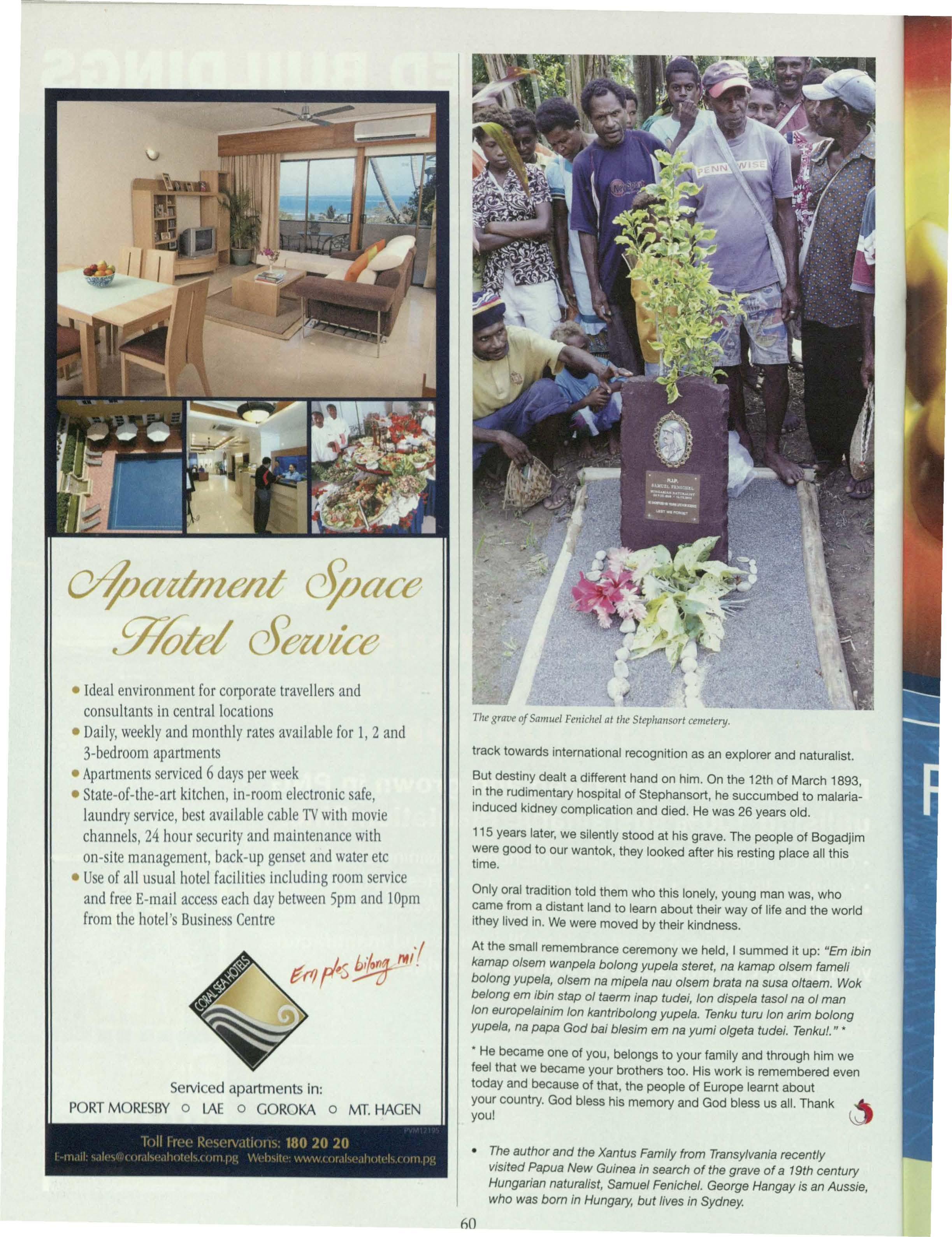
Thegraveaf SamuelFeniche/al the Step/iansartcemetery.
track towards international recognition as an explorer and naturalist.
But destiny dealt a different hand on him. On the 12th of March 1893, in the rudimentary hospital of Stephansort, he succumbed to malariainduced kidney complication and died. He was 26 years old.
115 years later, we silently stood at his grave. The people of Bogadjim were good to our wantok, they looked after his resting place all this time.
Only oral tradition told them who this lonely, young man was, who came from a distant land to learn about their way of life and the world ithey lived in. We were moved by their kindness.
At the small remembrance ceremony we held, I summed it up: "Em ibin kamap olsem wanpela bolong yupe/a steret, na kamap olsem fameli bolong yupela, olsem na mipela nau olsem brata na susa oltaem. Wok belong em ibin stap of taerm /nap tudei, Ion dispe/a tasol na of man Ion europelainim Ion kantribolong yupela. Tenku turu Ion arim bolong yupela, na papa God bai blesim em na yumi olgeta tudel. Tenku/." *
• He became one of you, belongs to your family and through him we feel that we became your brothers too. His work is remembered even today and because of that, the people of Europe learnt about your country. God bless his memory and God bless us all. Thank ._ you!
• The author and the Xantus Family from Transylvania recently
visited Papua New Guinea in search of the grave of a 19th century Hungarian naturalist, Samuel Fenichel. George Hangay is an Aussie, who was born in Hungary, but lives in Sydney.

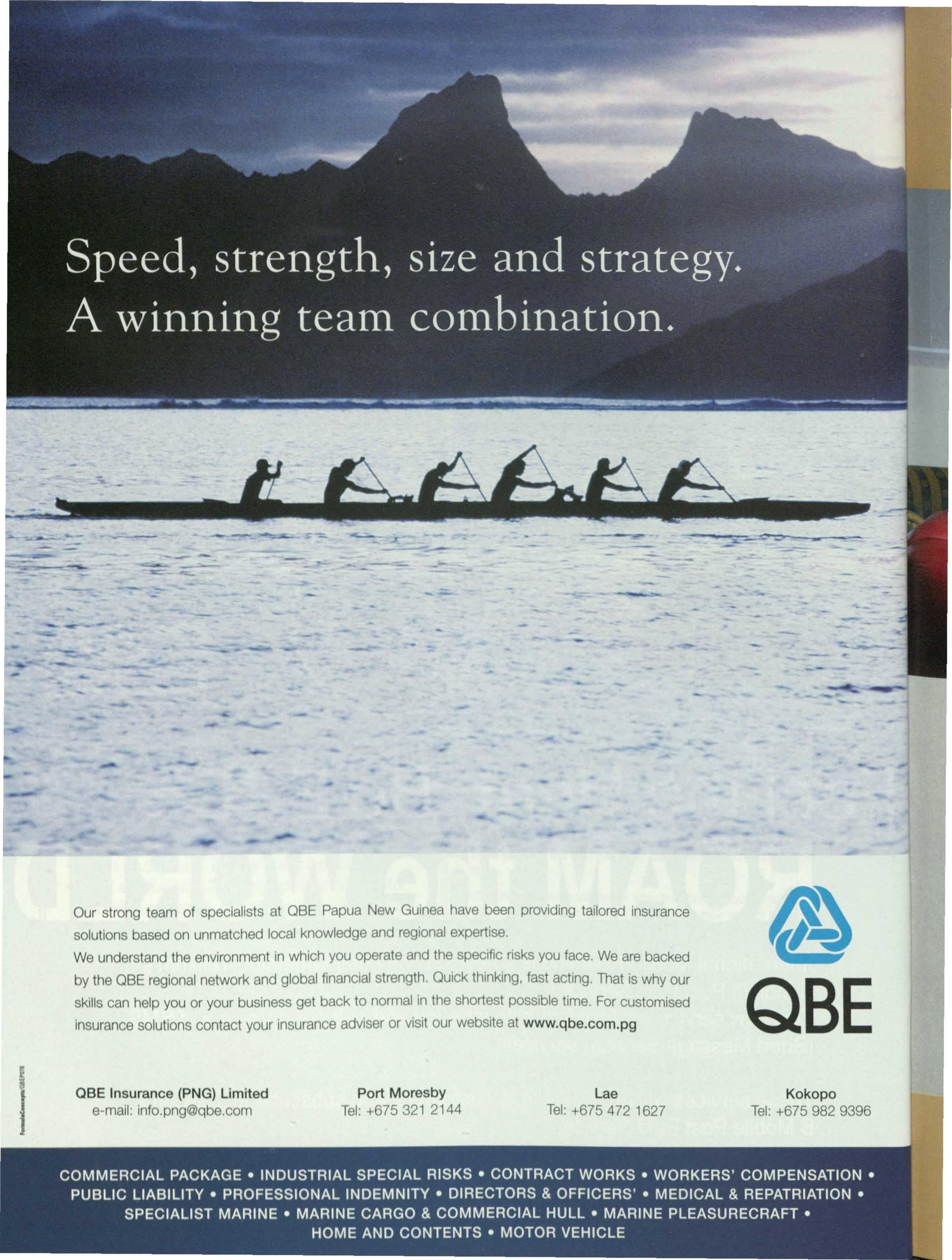
Our strong team of specialists at QBE Papua New Guinea have been providing tailored insurance solutions based on unmatched local knowledge and regional expertise. We understand the environment in which you operate and the specific risks you face. We are backed by the QBE regional network and global financial strength. Quick thinking, fast acting. That is why our skills can help you or your business get back to normal in the shortest possible time. For customised insurance solutions contact your insurance adviser or visit our website at www.qbe.com.pg
Blue Card Membership
• Blue Card Membership K499 pa
Domestic Paradise Lounge Access
Additional Baggage Allowance
Advance Seat Selection
Priority Baggage Handling
Priority Waitlist
Special Meal and Seat Preferences
Priority Reservation Services
Dedicated Check-in Service
Paradise Lounge Check-in
Internet Access
Telikad Phone Access
Guest Vouchers
Discounts on In-Flight Duty Free
Discounts on Air Niugini Retail Merchandise
Special Hotel Rates
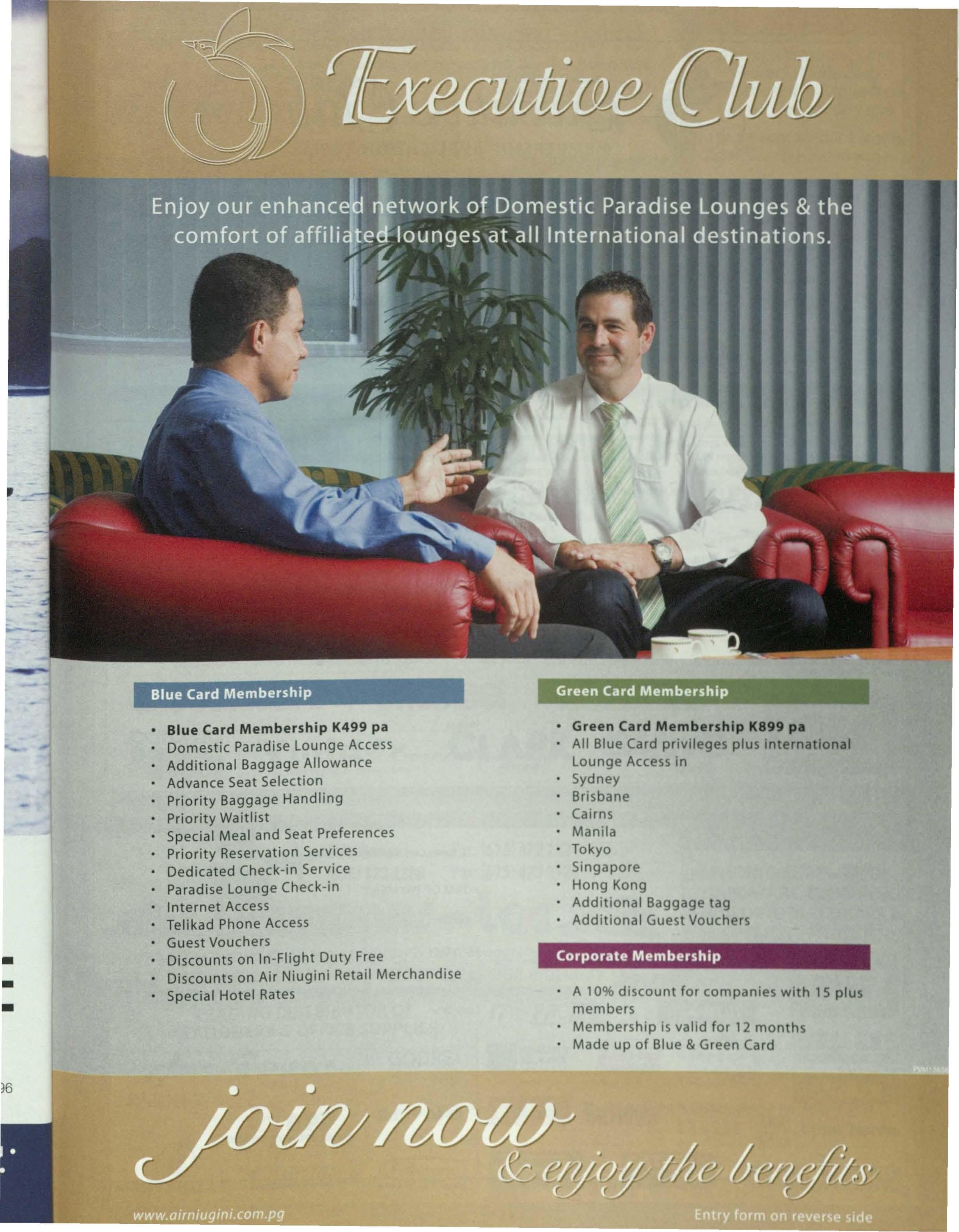
• Green Card Membership K899 pa
All Blue Card privileges plus international Lounge Access in
Sydney
Brisbane
Cairns
Manila
Tokyo
Singapore
Hong Kong
Additional Baggage tag
Additional Guest Vouchers
Corporate Membership
A 10% discount for companies with 1s plus members
Membership is valid for 12 months
Made up of Blue & Green Card
Enjoy our increasing network of domestic Paradise Lounges and the comfort of our international Paradise Lounge in Port Moresby with Blue Card Membership.Alternatively, choose to enjoy the comforts of our Paradise Lounges as well as similar facilities offered in associated international lounges with Green Card Membership when flying internationally with our Bird of Paradise.
Your Membership card identifies you as a valued customer and is your passport to all the privileges available to Executive Club Members travelling on Air Niugini domestic and international services.
Make the most of every journey by taking advantage of the privileges and services offered by Air Niugini Executive Club Membership. ANY PERSONTRAVELLINGON CONCESSIONTICKETIS NOT ELIGIBLETO JOINTHE EXECUTIVECLUB.
All information given on this questionnaire will be treated in confidence.
You can either deliver your form to our office or to the nearest Sales office to you, or fax it to us on Fax: 327 3527
Please make your cheques payable to Air Niugini Ltd.
For further assistance, please contact the Membership Coordinator on Ph: 327 3420 or Email: exec.club@airniugini.com.pg
Pleaseensure the name you provide us is the same as that on your passport and your Qantas FF Program.
MR/MRS/MS/OTHERSurname
First Name Initial Nationality Date of
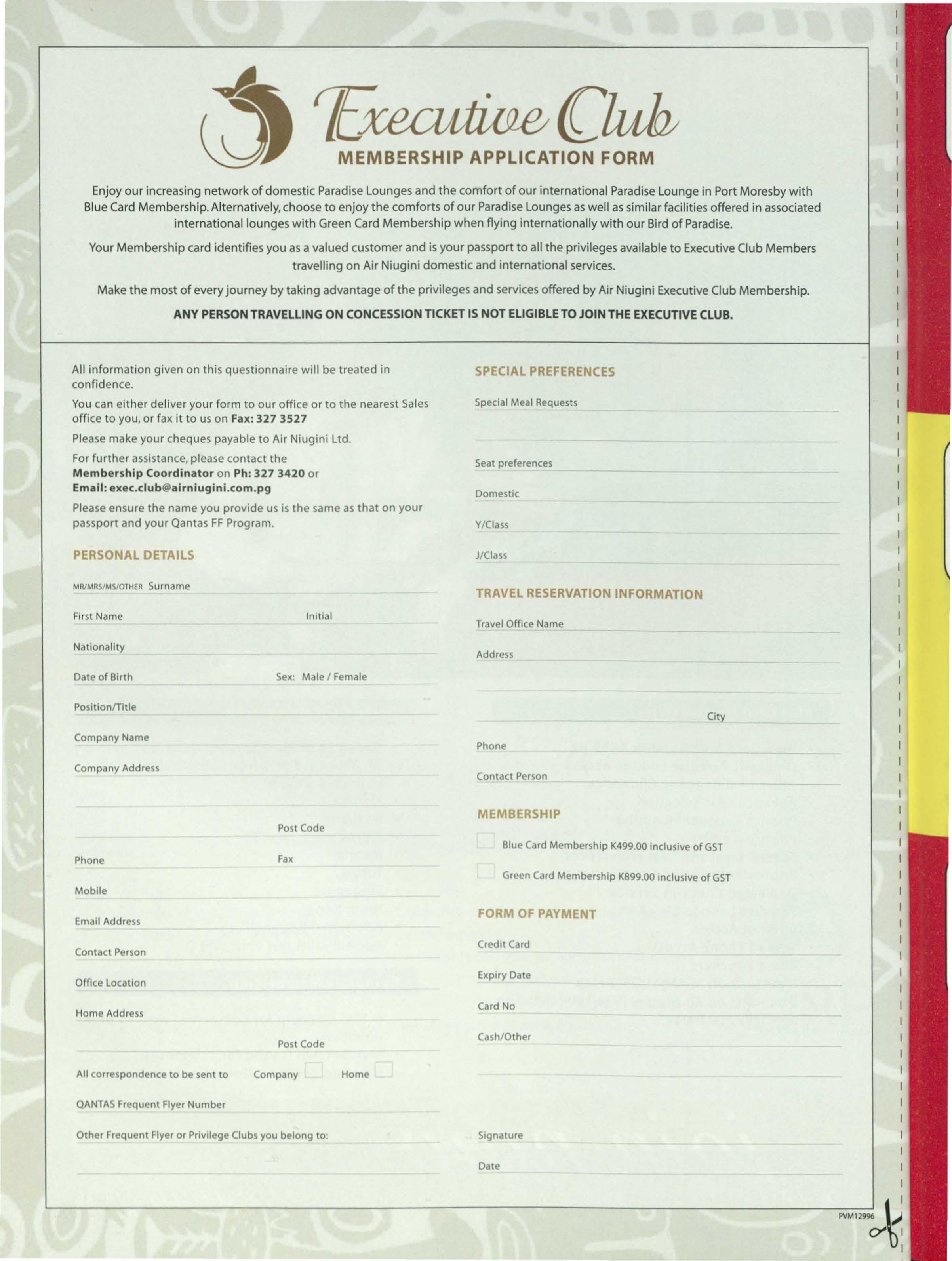
P.O. Box 456, Lae. Morobe P.O. Box 1405, Boroko. NCO.
Papua New Guinea
Phone: (675) 4721111
Fax: (675) 4721335
Email: sklae@seetokui.com.pg
Papua New Guinea
Phone: (675) 325 4700
Fax: (675) 325 4474
Email: skpom@seetokui.com.pg
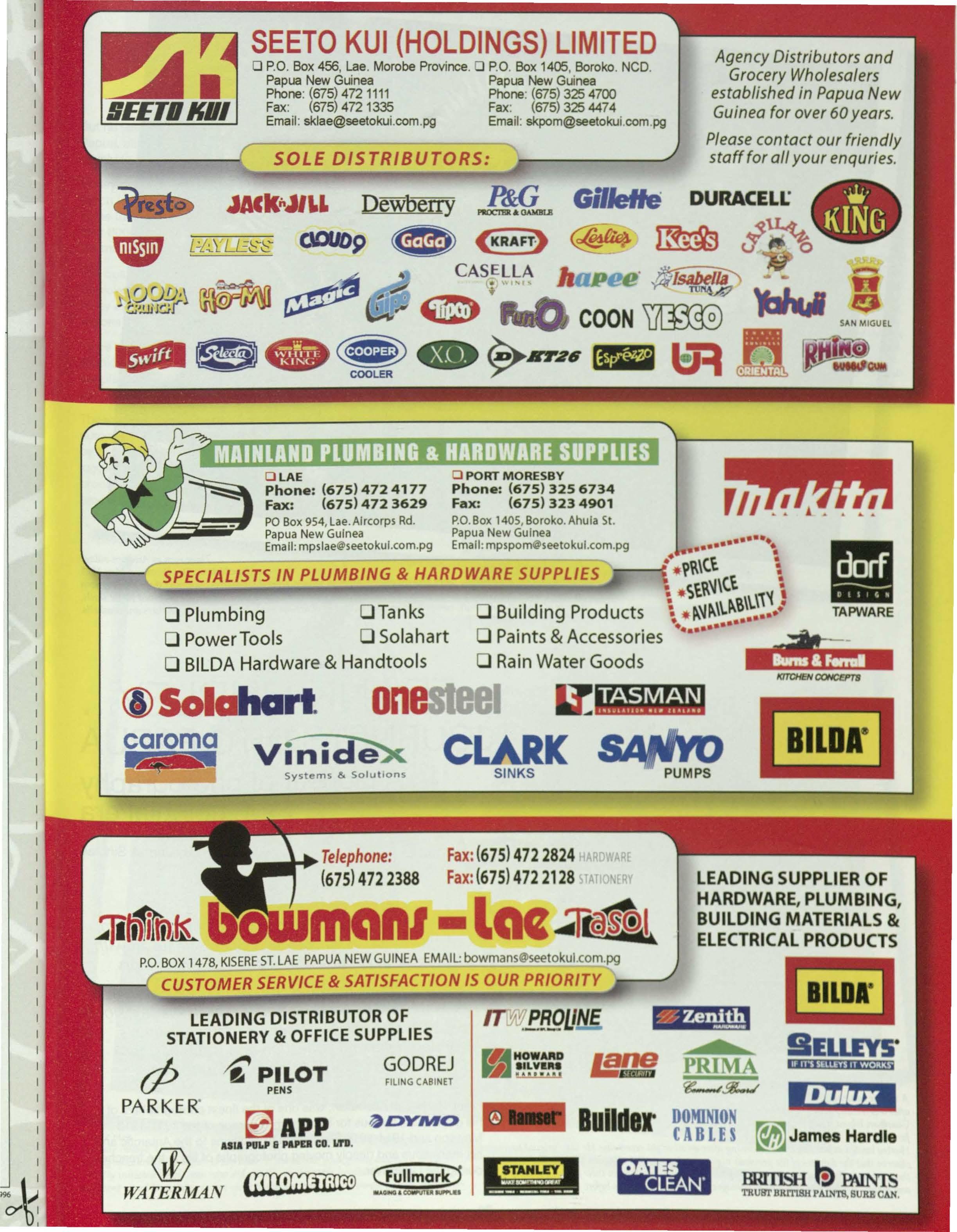
Agency Distributors and Grocery Wholesalers established in Papua New Guinea for over 60 years. Please contact our friendly staff for all your enquries.
Phone: (675) 472 4177
Fax: (675) 472 3629 PO Box 954, Lae.Alrcorps Rd.
Papua New Guinea Email: mpslae@seetokul.com.pg
'Threemer,at Awanen village in CapeNelson, Ora Province, May 1921 A ,.,,;,,, ·~ ,,,_,
•P. rim, from II, A,gum, m;•;o, ,,,,,
By James Sinclair
n exhibition has opened at the Australian Museum, College Street, Sydney, which will fascinate all with an interest in Papua New Guinea and her affairs.
A visitor ret11rni118home after a ceremonyat Kerewa11i//a8e Coaribari fsla11d,C11ffPro11111ce Ja1111ary1923
Hurley la11dedat Kerewa011the morning after an all-night ceremony.I le was 'grtet.lf'dlo observeI/tat llte dancersof llte prev1011s11iglt1were leaving lhe uilfage III their ca11oesfor their vnrio11srircum;acent villages. They ltlf're 111/ensetypictorial in /heir feathery pfome., and paint'. H11rfeywas stiff able lo photographsomeof the Vfolors beforethey departed.
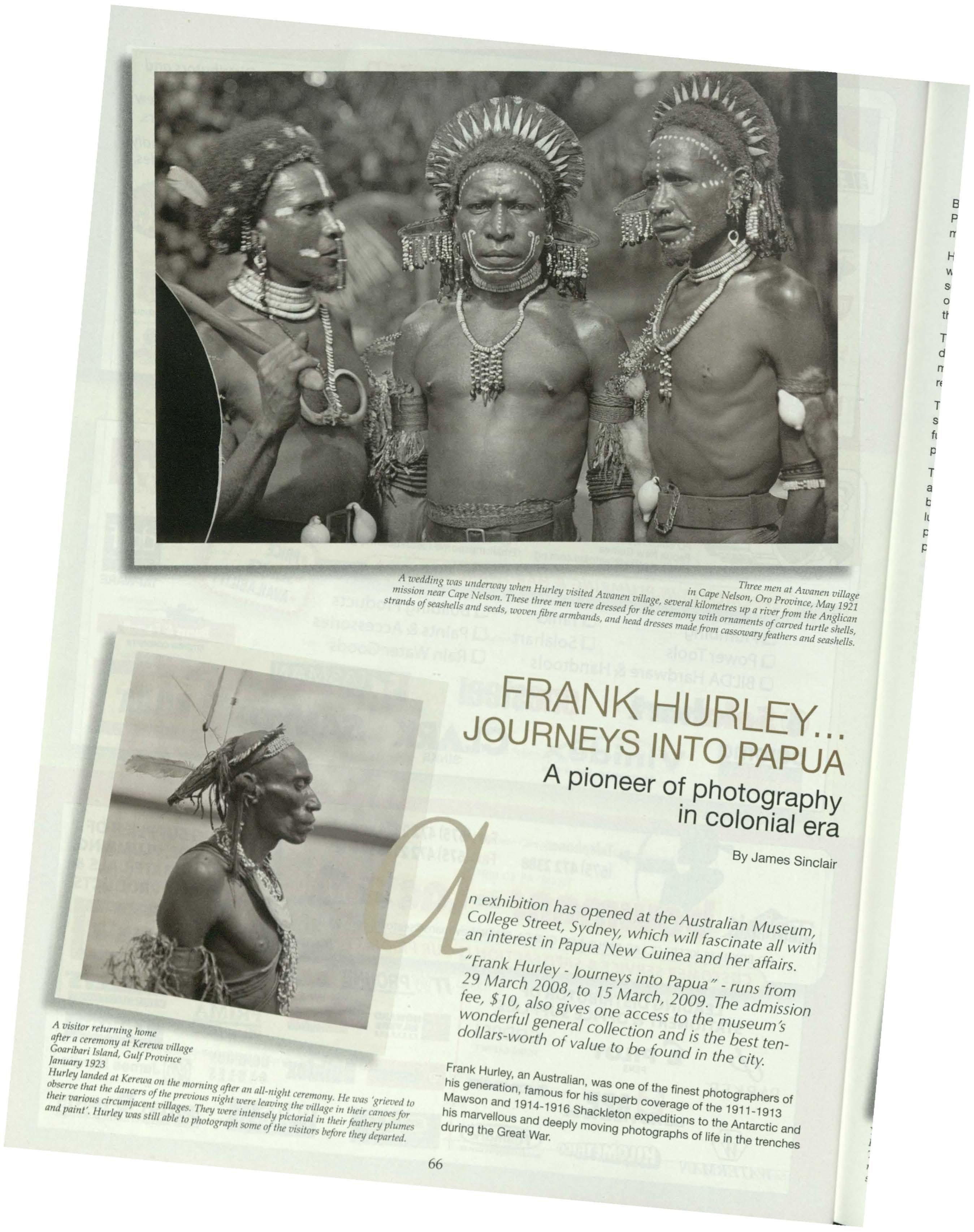
"Frank Hurley· Journeys into Papua" - runs from 29 March 2008, to 75 March, 2009. The admission fee, $ 70, also gives one access to the museums wonderful general collection and is the best tendollars-worth of value to be found in the city.
Frank Hurley, an Australian, was one of the finest photographers of his generation, famous for his superb coverage of the 1911-1913 Mawson and 1914-1916 Shackleton expeditions to the Antarctic and his marvellous and deeply moving photographs of life in the trenches during the Great War.
Those accustomed to the dinky little teathenvC'ight iully-automatic diaital mands oi today will be astounded by the sheer size o( this great camera, which Hurley lugged into ,ome of the least acce,,ible places in Papua
But he was also a pioneer of photography in colonial Papua, although this aspect of his long career is known mainly to specialists.
Hurley made two visits to Papua between 1921 and 1923, which yielded several thousands of glass plate negatives, some thousands of feet of movie film and a collection of over 800 artifacts, most of which are in the possession of the museum.
The quality of the photographs is amazing. Eighty are displayed, enlarged to a considerable size, illustrating many aspects of life among Papuan villagers in remote regions seldom visited by outsiders.
There are many portraits of villagers and some splendid scenic shots. Also on display is the huge, cumbersome full-plate camera with which Hurley made his photographs.
Those accustomed to the dinky little featherweight fullyautomatic digital marvels of today will be astounded by the sheer size of this great camera, which Hurley lugged into some of the least accessible places in Papua, processing his fragile glass plates with river-water, yet producing images of superlative technical quality.
age 921 can ,11s, ,us.

Maskedda,rcersi11front of the men's longliou~ al Tave, village UramnIsland,Gulf Prm. 1inu June 1921 in 1921two ma ked dancersP"formedfor Hurley's camerasoutside Tovei longhouse.He did not mention the ma ks dunng his 1923visit and probablydecided agams/ trying to buy one bttau.seof their larges1u. Hurley's photo andfilm of the da11cersau the 011ly recordsof t/1islargema.k form, wlrichwas u~d to ba11tl1reat111g of coconuts beforea majorceremony.
In the process, Hurley also pioneered the use of aeroplanes in Papua. He had been planning a visit to New Guinea when the Great War intervened.
He resumed his intention after the war. His first trip, in 1921, was fleeting, to prepare the way for his principal expedition in 1922. His plans were bold and ambitious. He intended to employ an auxilliary ketch to establish fuel and storage bases at Yule Island, Kaimare village near the mouth of the Purari River, and at
Childrenwith model sailingcanoes011 Mailu Island Amazon Bay, CentralProvince,June 1921 Racing modelcanoeswas a popularpastimeof Mailu children.Some skilledcraftsmenmademodelsof the tradingca11oes,completewith sailsand riggi11g,a11d carefullymaintainedthem overma11yyears.Othermodels were little more tha11hm piecesof woodjoi11edtogether and wereprobablymadeby cJ1ildren.Thesemodelcanoe raceswere importantwaysfor boys to learnskills that would beesse11tiali11laterlife.
Kikori, from which he would make exploratory flights whilst the ketch proceeded up the Fly River to Lake Murray and then on to the junction of the Alice River with the Fly. He would then attempt to fly from the junction across the Central Range to the Sepik.
Two aeroplanes would be used, both provided by Lebbeus Hordern. The principal machine was an American Curtiss Seagull biplane flying-boat, with a hull constructed of mahogany, fitted with a Curtiss K6 engine of 160 horse-power and with open cockpit accommodation for the pilot and two passengers. As a back-up, a smaller English Short Shrimp biplane float plane, was also fitted with an engine of 160 hp.
The Curtiss Seagull arrived in Port Moresby on 17 August, 1922, on board S.S. Marsina with the pilot, Captain Andrew Lang, ex-Great War fighter pilot and first commander of No. 4 Squadron, Australian Flying Corps.
This was the first flying machine ever seen in Port Moresby and caused vast excitement among the Motu villagers.
Captain Lang made his first flight in the Seagull on 5 September, the event recorded in the local newspaper, Papuan Courier:
"At ten o'clock she left her moorings and after racing across the bay towards Tatana she gracefully rose into the air, flew round the bay and over the town.
Captain Lang remained in the air for just over half an hour. The excitement among the natives was something worth seeing one boy was so excited when Captain Lang waved as he passed over the town that he whipped off his rami and waved like mad, oblivious of the fact that he was standing without any clothes whatsoever "
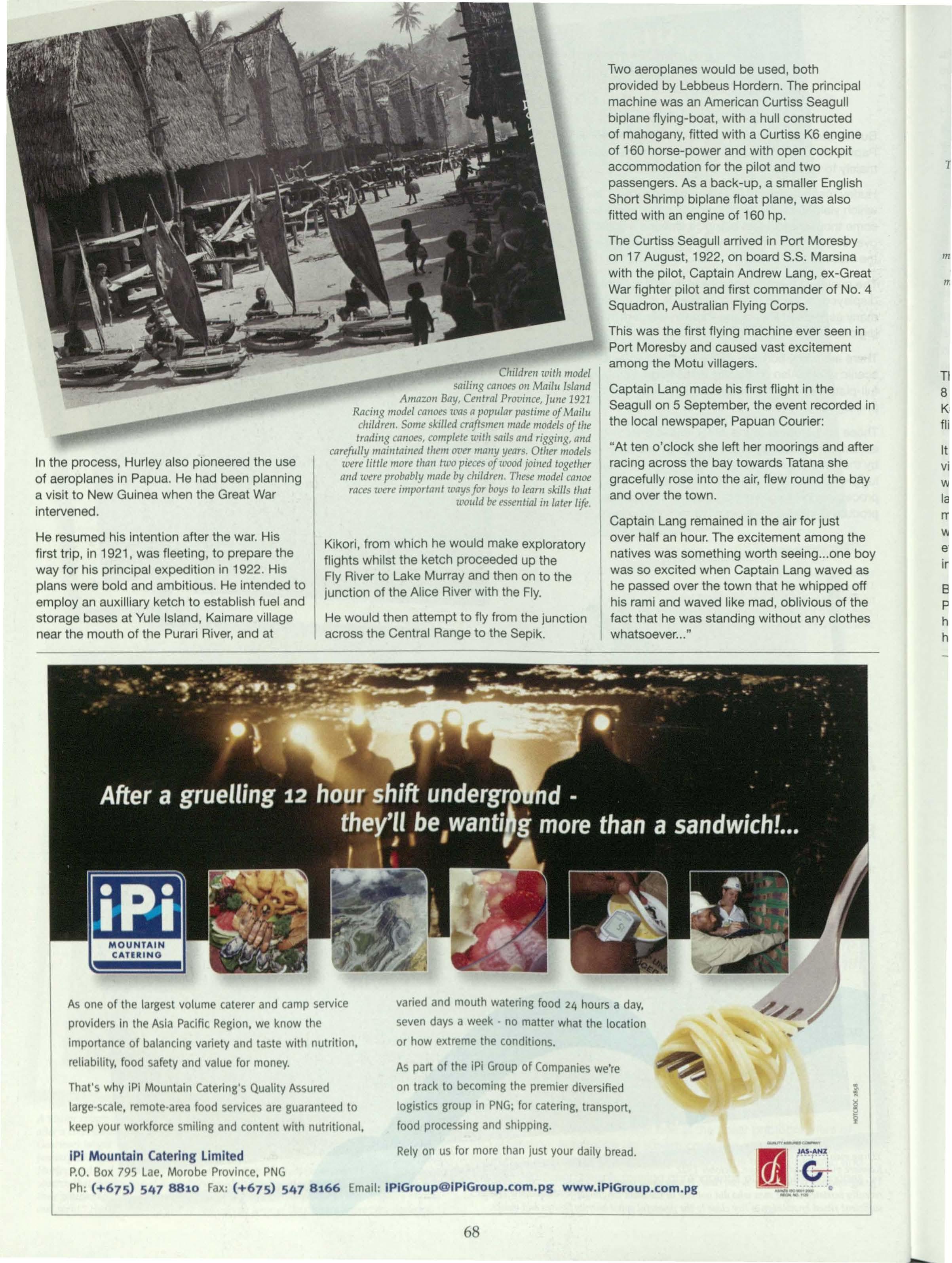
As one of the largest volume caterer and camp service providers In the Asia PacificRegion,we know the importanceof balancingvariety and taste with nutrition, reliability, food safety and value for money.
That's why IPI Mountain catering's Quality Assured large-scale,remote-areafood servicesare guaranteedto ke p your workforce smiling and content with nutritional,
IPI Mountain Catering Limited
P.O.Box 795 Lae, Morobe Province, PNG
Ph: (+675) 547 8810 Fax: (+675) 547 8166
varied and mouth watering food 24 hours a day, seven days a week • no matter what the location or how extremethe conditions.
As part or the iPi Groupof Companieswe're on track to becomingthe premierdiversified logistics group In PNG;for catering,transport, food processingand shipping.
Rely on us for more than just your daily bread.
Email: lPlGroup@IPlGroup.com.pg www.lPiGroup.com.pg
Gogodalaman of Uladu z•illage Aramia River, Western Province December1922
This man wearsthe conical Dibahat that indicates he has been initiated.The unclesof boys who were about to be initiatedmade thesehats. Some men removedthe hat when in mourning, replacingit with a woven string cap. Other mournersretainedthe Diba and, like this man, worea specialstring necklacein placeof the cap.
The Short Shrimp was successfully flown on 8 September. Lang and Hurley then flew to Kaimari in the Seagull, a then highly perilous flight of some 250 miles.
It was their first sight of an aeroplane for the villagers of that long coastline, and both flyers were soaking wet from stinging rain when they landed at Kaimari. Over the following month many flights were made from Kaimari, during which Hurley took the first aerial photographs ever taken in Papua. An excellent print is included in the exhibition.
But the attempt to use an aircraft to explore Papua failed, for the constant rain and humidity took a rapid toll of the fragile wooden hull of the Curtiss. And it was dangerous
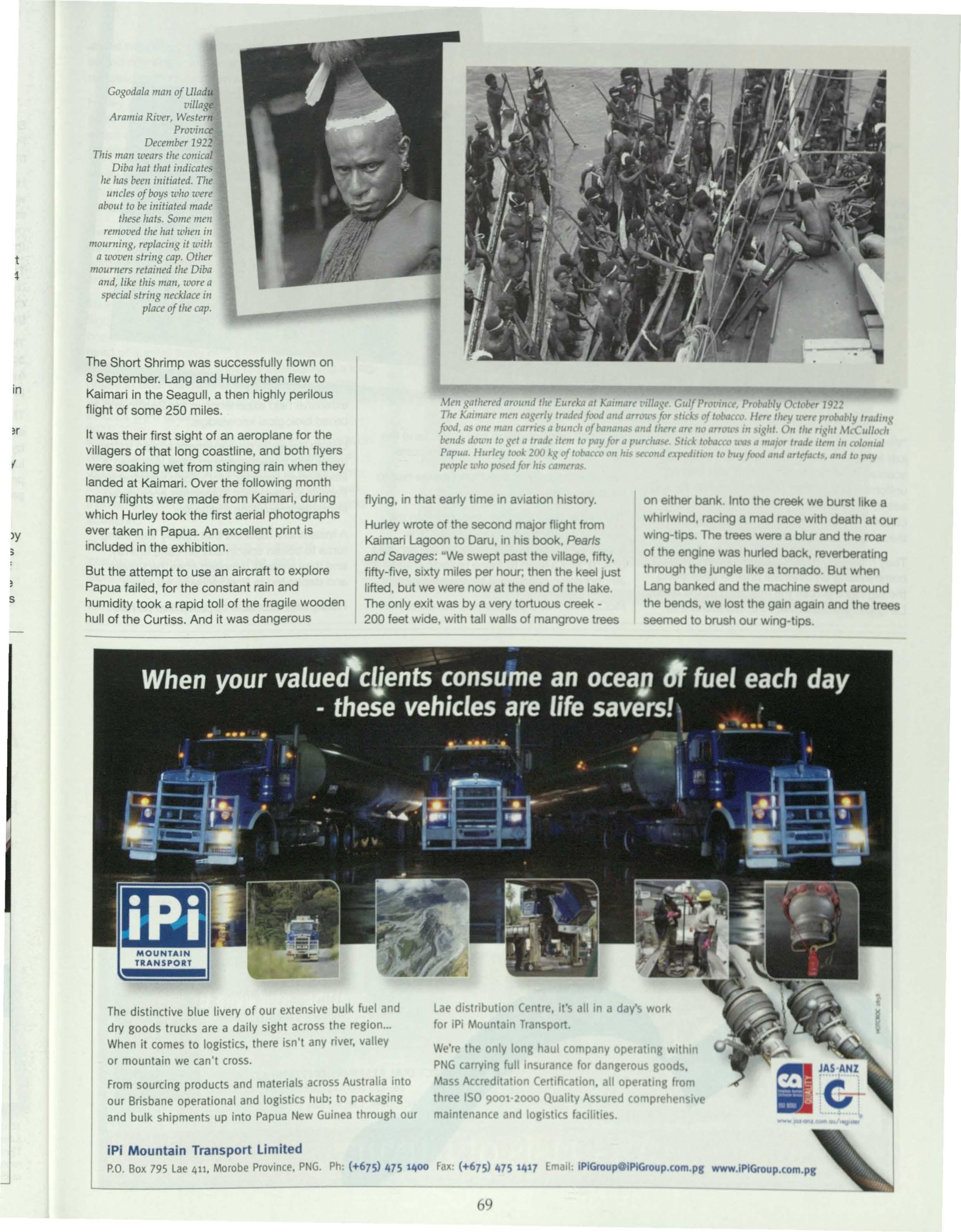
.\1engathm•d arow,d the Eurel.aat unarei,11/a, •t. Gulf ProvrnC't',ProbaNvO tolvr 7922 Tht Kaimnn•mt"IIrog,·rlvtra,/edfood and arr or /le of t,>bncroHert ihty werr J'robaNvtradm food, a, one man ramrs a brmchof baruma arid tlirrt urr no arrowsrn , ht On t~ rrght,\1 ullitcJ, bend, dmm to, •,·ta tradt rt.-mto l"'Yfor a 1•urc/111~Siu A toba co uvs a ma1ortra,/erltm rr, co/on,a/ Paf'ua,Hurl<"!/took200 A, o tobaccoon his kcond r.xprd1t1onto l,uy and artr a t , and to l'"V f""Plt rrhof>OStdfor Ins camera.
flying, 1nthat early time in aviation history.
Hurley wrote of the second major flight from Kaimari Lagoon to Daru, 1nhis book. Pearls and Savages: "We swept past the village, fifty, fifty-five, sixty miles per hour; then the keel just lifted, but we were now at the end of the lake. The only exit was by a very tortuous creek200 feet wide, with tall walls of mangrove trees
on either bank. Into the creek we burst hke a whirlwind, racing a mad race with death at our wing-tips. The trees were a blur and the roar of the engine was hurled back, reverberating through the Jungle like a tornado. But wh n Lang banked and the machine swept around the bends, we lost the gain again and the tr seemed to brush our w1ng-t1ps.
or mountain we can't cross.
From sourcing products and materials across Australia into our Brisbane operational and logistics hub; to packaging and bulk shipments up into Papua New Guinea through our
Lae distribution Centre, it's all In a day's work for iPi Mountain Transpon.
We're the only long haul company operatln w1thrn PNGcarrying full insurance for dangerous good Mass Accreditation Certification, all operating from three ISO 9001-2000 Quality Assur d compreh nsive maintenance and logistics facilities.
Gogodalame11on ti,e Ara111iaRiver Western Provi11ce Dece111ber1922
Hurley regardedti,e canoeas 'the ft11est011 the lagoo11'.Its price wasfour waistclotl,s, a11axe, a large and a small knife, and 20 sticks of tobacco.Hurley 'further a11g111e11ted this abs11rdrequest wit/, empty tins, mirrors, beads, doubled ti,e tobaccoaskedfor, and sundry small prese11ts'.It is now at the A11stralia11Museu111.
Traditio11ally,ca11oeswere racedi11 competitio11sto celebratetl,e e11dof disputes. Today canoeracescelebrate specialoccnsio11slike Pap11aNew Guinea's /11depe11de11ce Day.
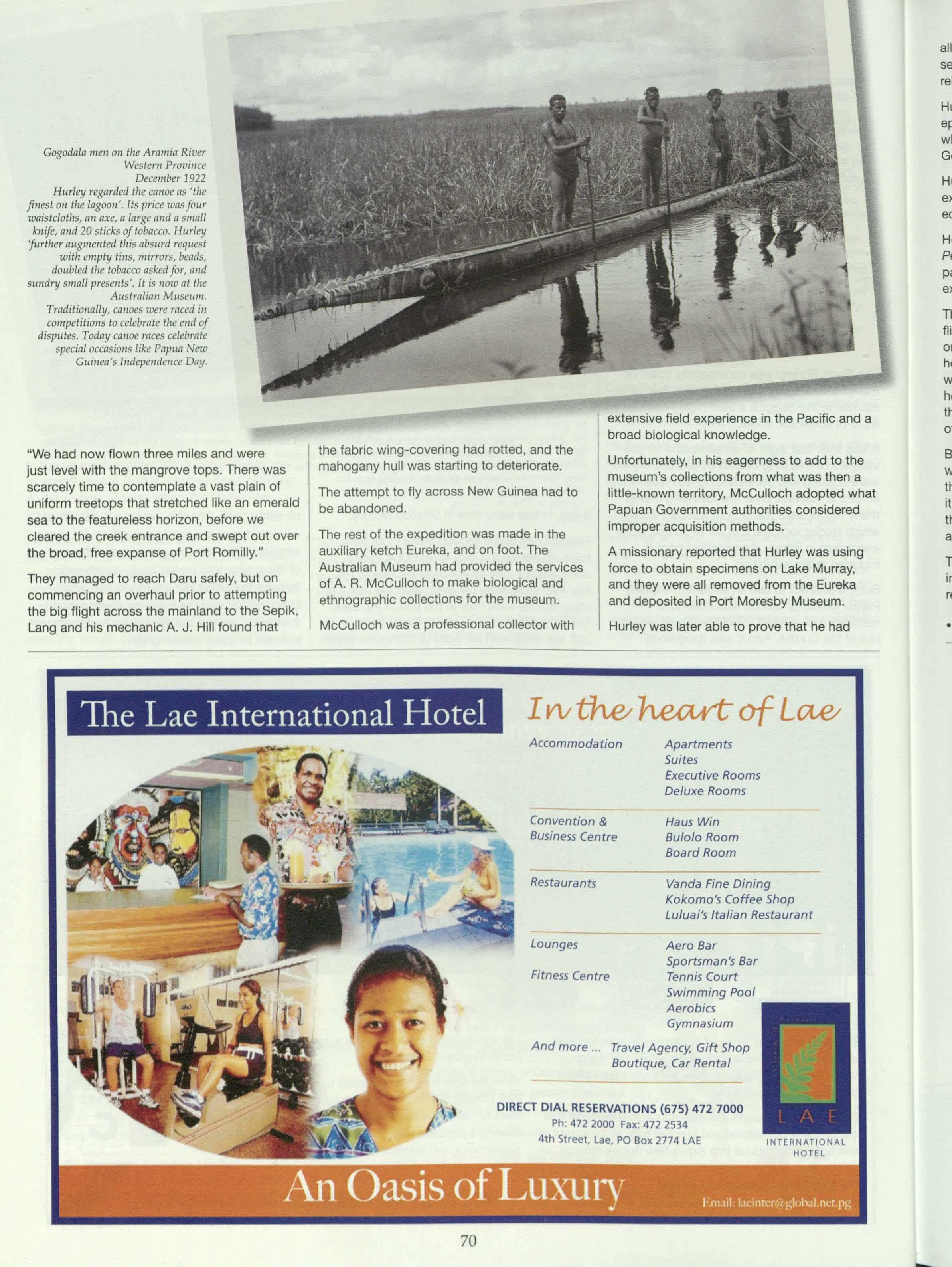
"We had now flown three miles and were just level with the mangrove tops. There was scarcely time to contemplate a vast plain of uniform treetops that stretched like an emerald sea to the featureless horizon, before we cleared the creek entrance and swept out over the broad, free expanse of Port Romilly."
They managed to reach Daru safely, but on commencing an overhaul prior to attempting the big flight across the mainland to the Sepik, Lang and his mechanic A. J. Hill found that
the fabric wing-covering had rotted, and the mahogany hull was starting to deteriorate.
The attempt to fly across New Guinea had to be abandoned.
The rest of the expedition was made in the auxiliary ketch Eureka, and on foot. The Australian Museum had provided the services of A. R. McCulloch to make biological and ethnographic collections for the museum.
McCulloch was a professional collector with
extensive field experience in the Pacific and a broad biological knowledge.
Unfortunately, in his eagerness to add to the museum's collections from what was then a little-known territory, McCulloch adopted what Papuan Government authorities considered improper acquisition methods.
A missionary reported that Hurley was using force to obtain specimens on Lake Murray, and they were all removed from the Eureka and deposited in Port Moresby Museum.
Hurley was later able to prove that he had
Suites
Executive
Deluxe Rooms
Haus Win
Bulolo Room
Board Room
Vanda Fine Dining
Kokomo's Coffee Shop
Lu/uai's Italian Restaurant
Aero Bar
Sportsman's Bar
Tennis Court
Swimming Pool
Aerobics
Gymnasium
And more... Travel Agency, Gift Shop
Boutique, Car Rental
all the necessary collecting permits and had not seized any items, and eventually the collection was released to the Australian Museum.
Hurley later made as much as he could of the episode in letters and articles in The Sun newspaper, which created much ill-feeling between the Papuan Government and the expedition members.
Hurley also shot movie footages, again of exceptional quality, given the primitive nature of the equipment at his disposal.
He later released an hour-long film, also called Pearlsand Savages. Some six minutes of the best parts of the film are on continuous show at the exhibition.
There are beautiful scenes of the two aeroplanes in flight, aerial sequences over coastal villages, and one particular sequence showing McCulloch at the head of a small party of Papuan collectors, all armed with rifles, silently and stealthily approaching a longhouse in what can only be described as a highly threatening manner. No wonder Papua Government officials were upset!
Both the book and the film of the Hurley expedition were received with wide acclaim. Regardless of the controversy over the collection of specimens, it undoubtedly did a great deal to bring what was then an almost completely unknown land to world attention.
The exhibition really is a must for anyone interested in Papua New Guinea, and I recommend it most highly.
• Photos kindly provided by the Australian Museum.
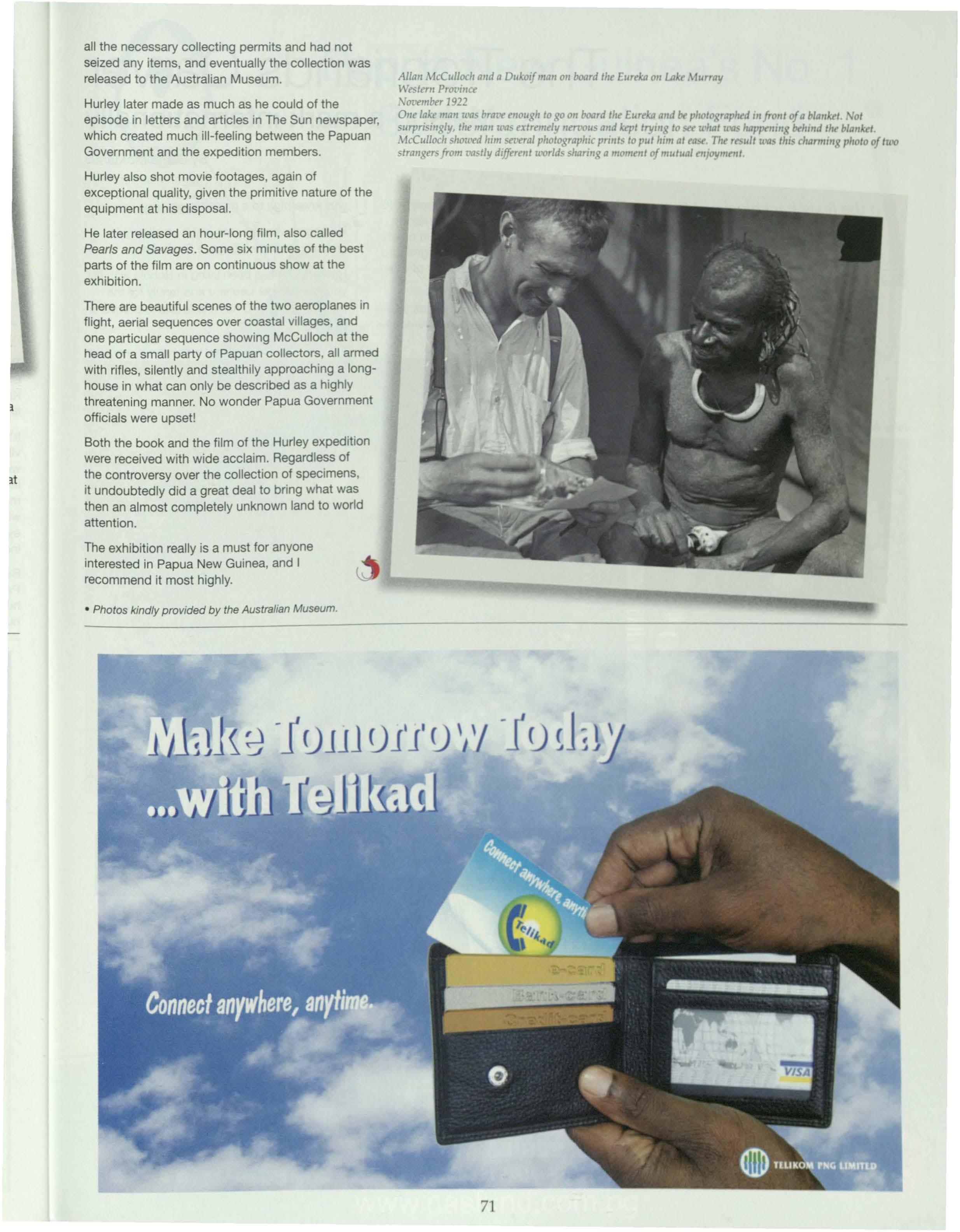
Allan McC11/lochand a D11koifman 011boardthe Eureka011I.AkeMurray WesternProt1ince , ovember1922
One lakeman was brm>eenough lo go on boardthe Eurekaand bephotographed111fro11t of a blanket 'lot surprisingly, the man was extremely nm'Ous and kept trying to stt u•hntwas lrapl'eningbt/11ndt/r, blanket. McC11/loc/1showedhim set•eralphotographicprints to put /rim at ease.Tire result wa this c!rarmmgphoto of two strangersfrom mslly differentu'Orldssharinga moment of mutual en1oymmt.
n the leafy backblocks of Port Moresby's suburb of Hohaia, a backyard woodworking studio hums with activity.
It is here that Lake Moyabona and his "apprentices" carve, sand, laquer, polish and construct highly sought after timber products.
/11/aydetail.
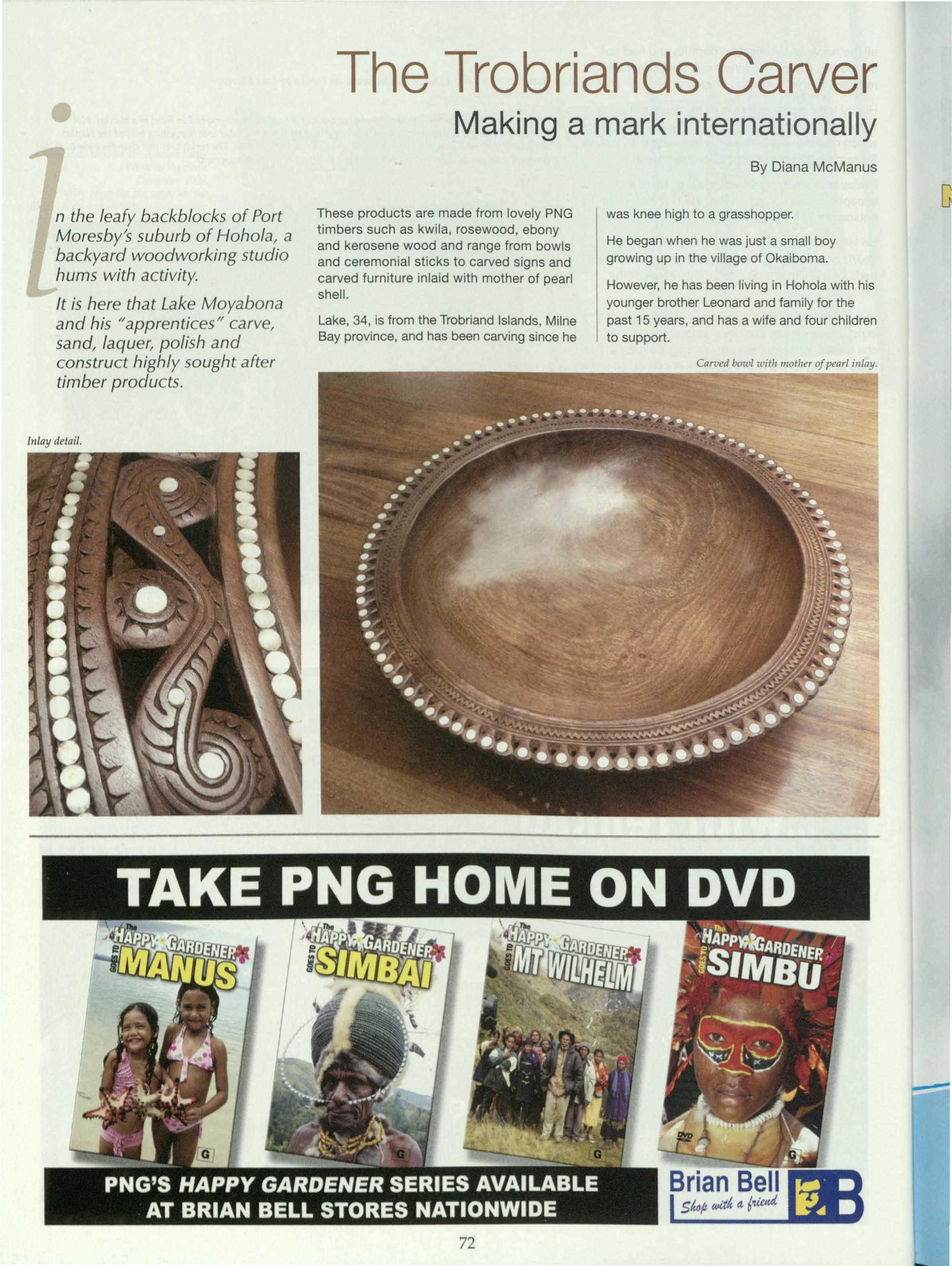
By Diana McManus
These products are made from lovely PNG timbers such as kwila, rosewood, ebony and kerosene wood and range from bowls and ceremonial sticks to carved signs and carved furniture inlaid with mother of pearl shell.
Lake, 34, is from the Trobriand Islands, Milne Bay province, and has been carving since he
was knee high to a grasshopper.
He began when he was just a small boy growing up in the village of Okaiboma.
However, he has been living in Hohola with his younger brother Leonard and family for the past 15 years, and has a wife and four children to support.
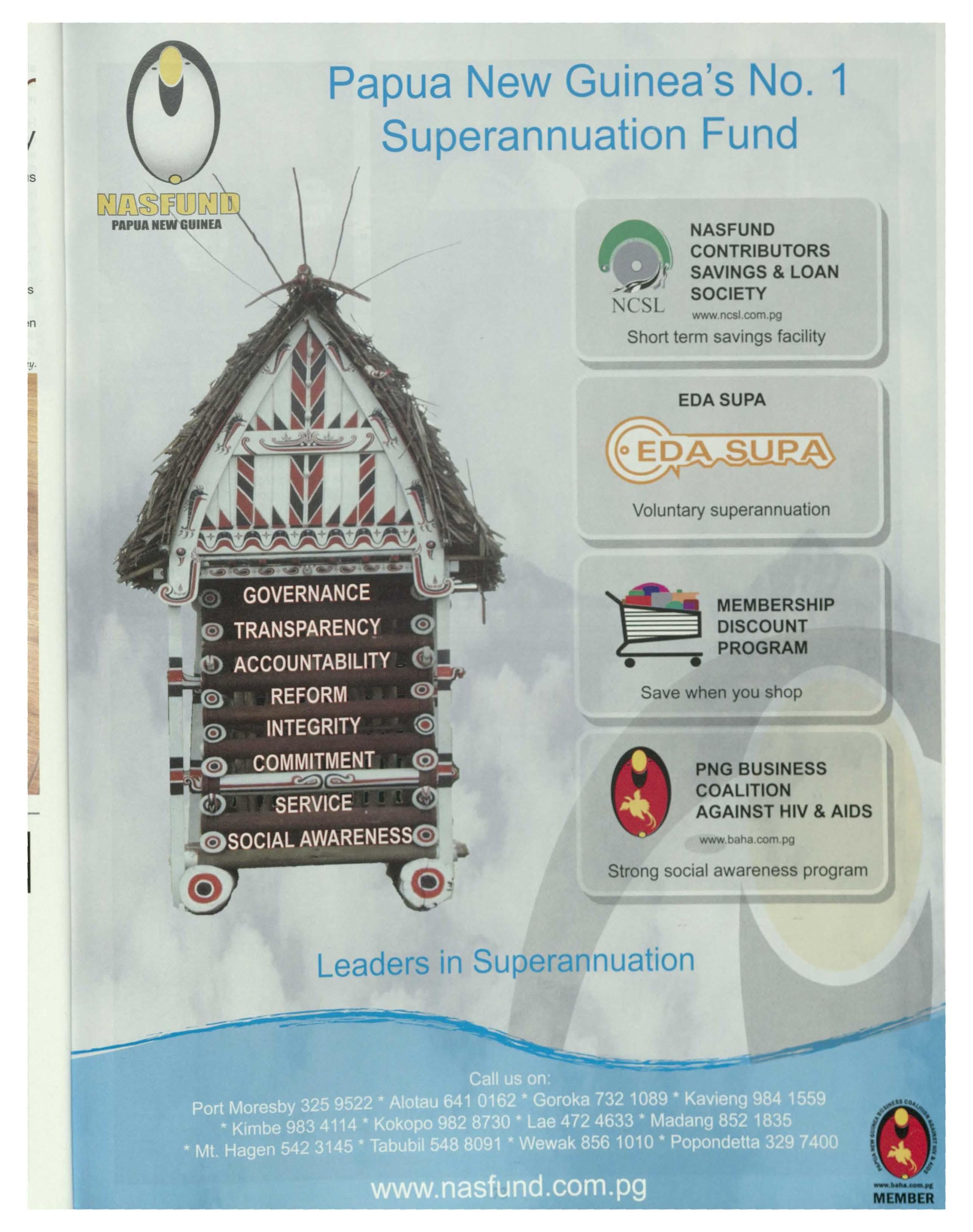
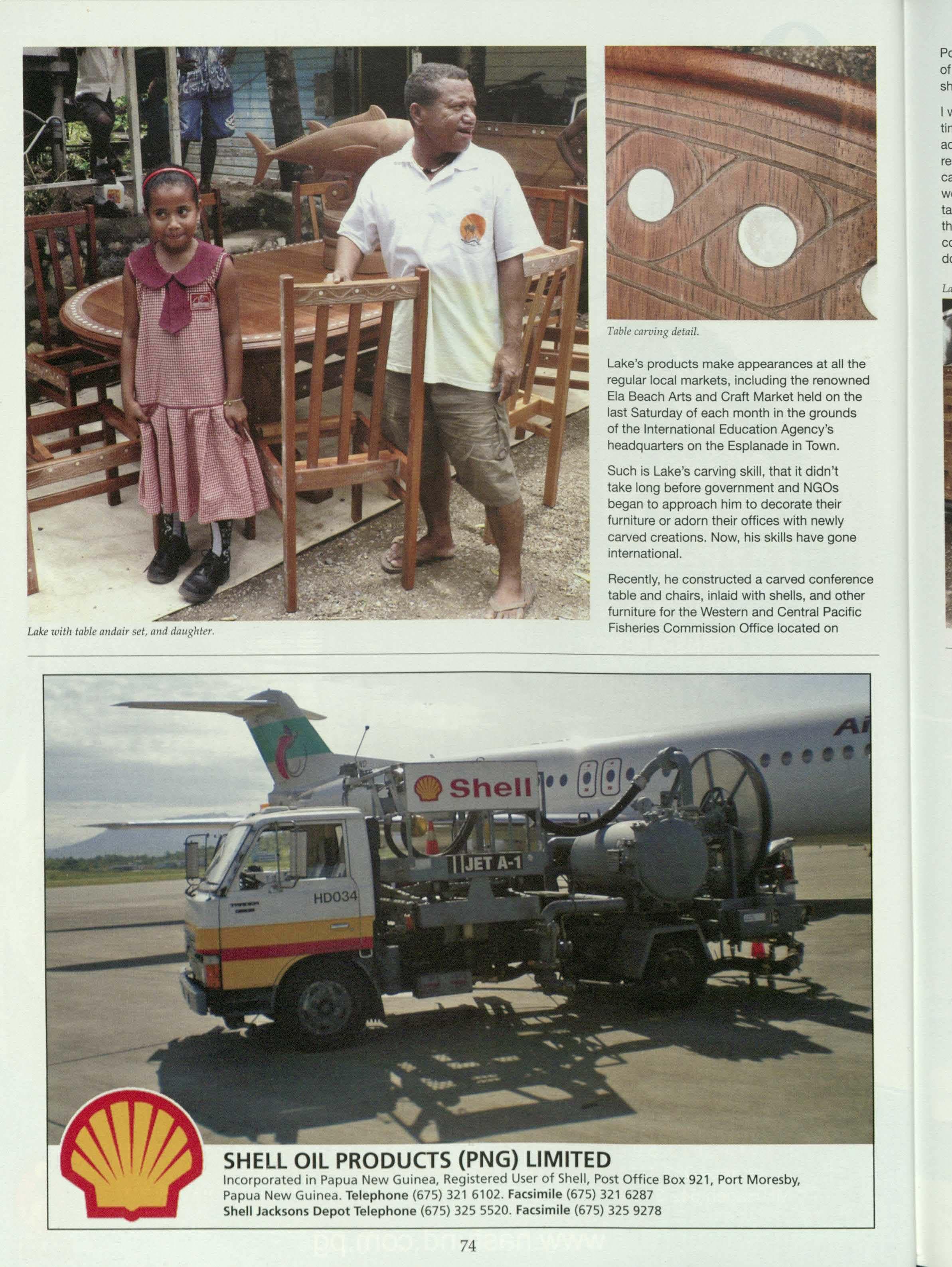
Tablecarving detail.
Lake's products make appearances at all the regular local markets, including the renowned Ela Beach Arts and Craft Market held on the last Saturday of each month in the grounds of the International Education Agency's headquarters on the Esplanade in Town.
Such is Lake's carving skill, that it didn't take long before government and NGOs began to approach him to decorate their furniture or adorn their offices with newly carved creations. Now, his skills have gone international.
Recently, he constructed a carved conference table and chairs, inlaid with shells, and other furniture for the Western and Central Pacific Fisheries Commission Office located on
Pohnpei, capital of the Federated States of Micronesia. The furniture was due to be shipped out in May for arrival in mid-June.
I was pleasantly surprised one lunchtime when Lake and Stanley, a business acquaintance, turned up at my workplace in response to my email and we bundled into a car and drove out to Hohaia to view the 'great works'. Unfortunately, the ornate conference table wasn't yet complete so we couldn't see that, but another table setting, the carved company sign, and a few of the 30 carved door signs were ready for photographing.

Such is Lake's carving skill, that it didn't take long before government and NCOs began to approach him to decorate their furniture or adorn their offices with newly carved creation
Lakeand brotherLeonard.
To top it off, the boys brought out a selection of things which go to the market, including some colourful bead and shell work, carved gourds, and a wonderful carved fish.
Lake is always on the lookout for work which challenges his imagination and skills.
If you're interested in engaging him to carve something for you, he can be reached on his mobile phone 672 0612 and failing that, try his ._ brother Leonard on 691 5605. V Carvingsa111/table.
Le Jliche
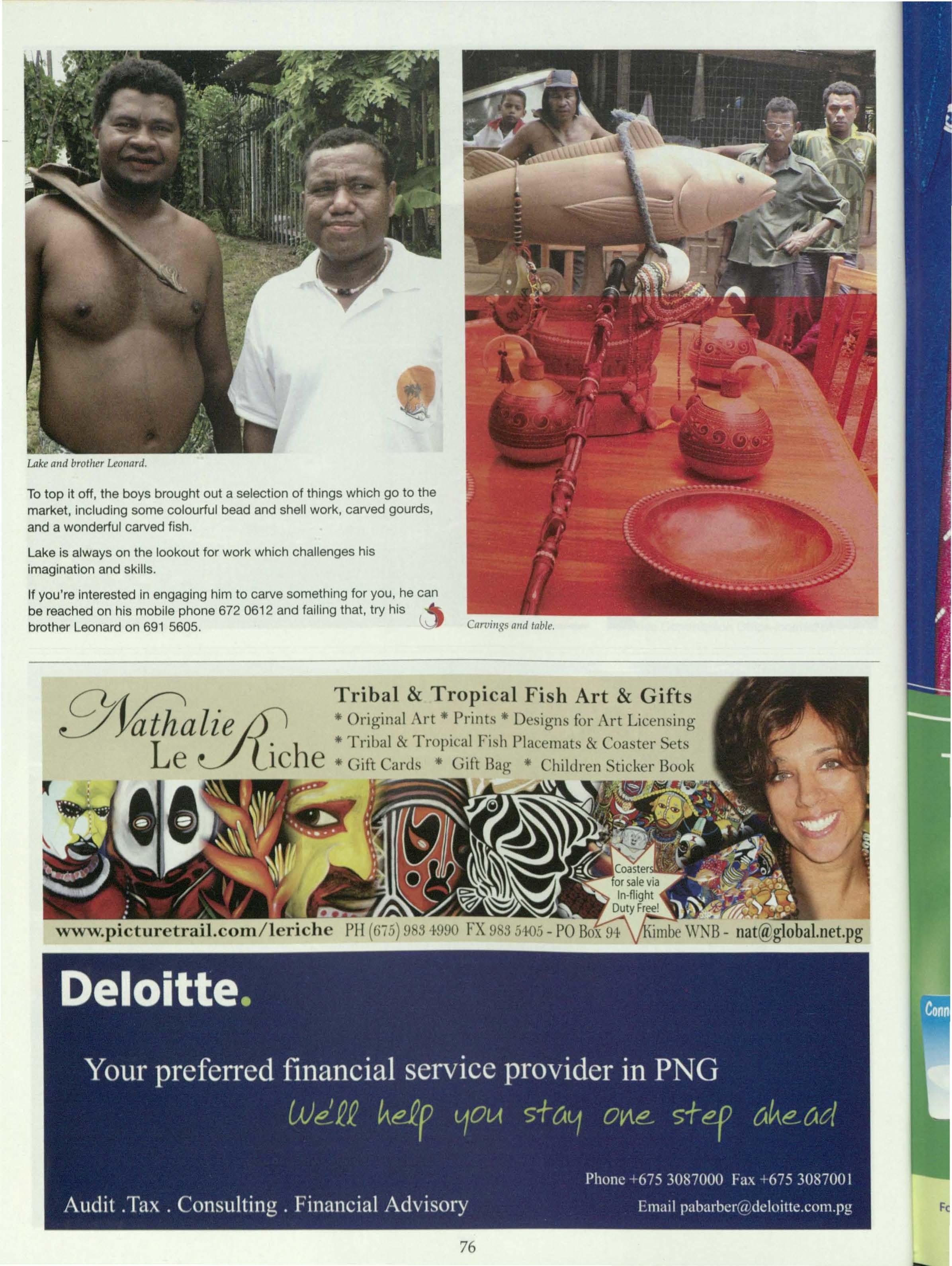
Tribal
* Original rt* Prints * Designs for Art Licensing
* Tribal & Tropical Fish Placemats & Coaster Sets
* Gift Cards * Gift Bag * Children Sticker Book Jii!!fl_~

ecently I, and about 40 of my professional colleagues, visited Kim be, capital of West New Britain, for an important nine-day Writing Workshop. From the moment we circled above the extensive oil palm and coconut plantations and touched down at Hoskins Airport, we knew this visit was going to be more than just work.
By Diana McManus
Kimbe town centre was a mere kilometre away from Liamo Reef Resort where we stayed so naturally it was patronised quite heavily. Nestled at the foot of the fringing hills of Kimbe Bay, the town is a prosperous and popular centre for its people who congregate In droves under the trees which line the highway or shade the town square outside Papindo's supermarket.
A vast, green grassy square divides one block of shops from another and creates a feeling of spaciousness and freedom. Pity about the excessive and obvious betelnut spit in an otherwise impressive township.
Next door to us was the tired but very friendly bay side San Remo Sports Club which consists of a golf course, tennis courts and the game fishing club.
The wide verandah offers great views over the bay, especially in the evenings with the port lights marking out the town and palm trees framing the distant hills.
It's about as close as you can get towards a definition of 'tropical paradise', especially with lobster mornay on the menu at K17 but you have to get In quick before its all snaffled up!
What makes the province so prosperous is its
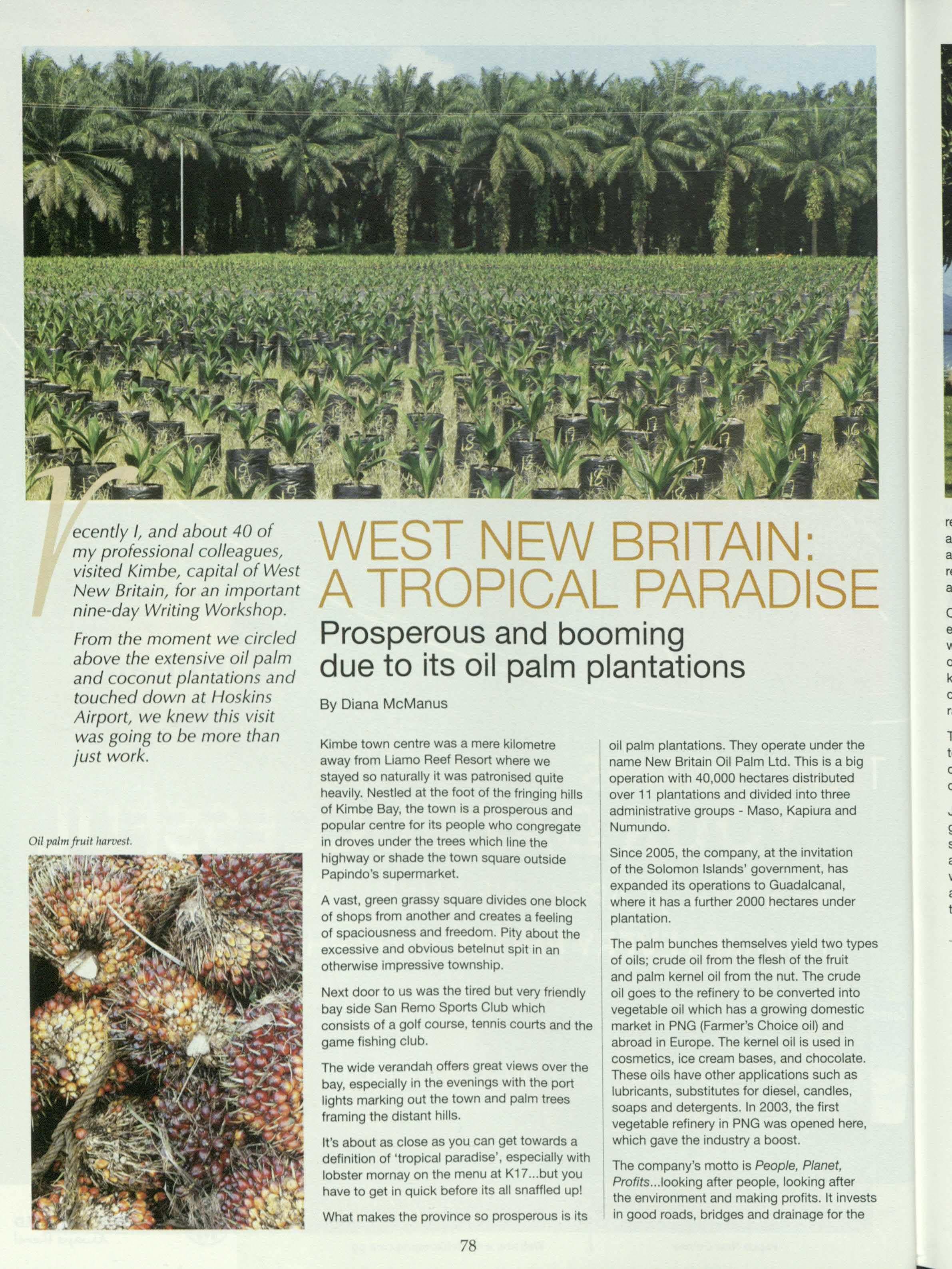
oil palm plantations. They operate under the name New Britain Oil Palm Ltd. This is a big operation with 40,000 hectares distributed over 11 plantations and divided into three administrative groups - Maso, Kapiura and Numundo.
Since 2005, the company, at the invitation of the Solomon Islands' government, has expanded its operations to Guadalcanal, where it has a further 2000 hectares under plantation.
The palm bunches themselves yield two types of oils; crude oil from the flesh of the fruit and palm kernel oil from the nut. The crude oil goes to the refinery to be converted into vegetable oil which has a growing domestic market in PNG (Farmer's Choice oil) and abroad in Europe. The kernel oil is used in cosmetics, ice cream bases, and chocolate. These oils have other applications such as lubricants, substitutes for diesel, candles, soaps and detergents. In 2003, the first vegetable refinery in PNG was opened here, which gave the industry a boost.
The company's motto is People, Planet, Profits looking after people, looking after the environment and making profits. It invests in good roads, bridges and drainage for the
regions, supports local schools, out stations and churches, and offers employment for a vast range of people from highly skilled research chemists and engineers to harvesters and nursery workers.
Our professional group went on a half-a-day excursion to the Mosa and Kumbango mills, where we were shown some of the company's operations. Adjoining Mosa was a wonderfully kept 18-hole golf course with a modern clubhouse, which made us wonder about the ragged look of San Remo's links.
The company's environmental programme is to be much admired and in recent years, the operation has been awarded the !SA 14001 certificate for Environmental Management.
John Komni, Group Manager for the Maso group, said the company aims to become fully sustainable in all areas, so all its by-products are being developed and used. For example, when the fruit is separated from the bunch after threshing, the remainder of the bunch is turned into compost and used on the young
palms and around the grounds of the mills and plantations.
Joseph Gunni, one of the division managers at the Kumbanga Mill, gave us a full run-down on the milling processes before we were taken on a tour to see for ourselves.
Once the oil has been extracted from the fleshy fruit, the fibre is used for burning and likewise, with the shells of the kernels. They are burnt to produce steam, using water processed at the mills, and the steam drives the turbines which power the mills' operations.
After oil has been squeezed from the kernels, the remaining fibre is pressed into a cake called expeller which Is used for stock feed
Maso Mill has a huge, adjoining plantation nursery which we were shown. It uses compost from the by-products of the mills to nurture the seeds to healthy infancy.
The seed nursery has been so successful it now supplies seeds to other plantations throughout Asia and places In South America.
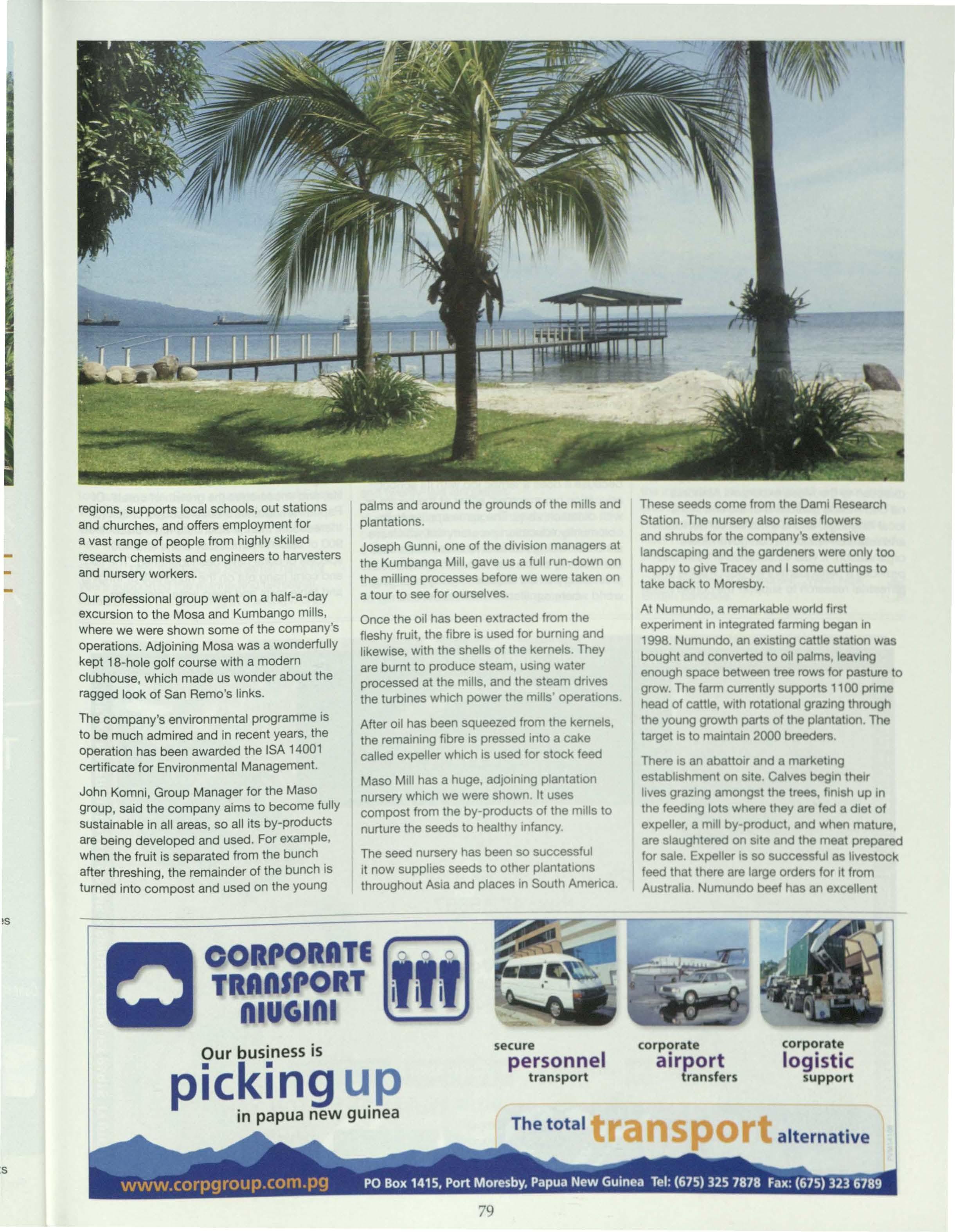
These seeds come from the Dami Research Station. The nursery also raises flowers and shrubs for the company's extensive landscaping and the gardeners were only too happy to give Tracey and I some cuttings to take back to Moresby
At Numundo, a remarkable wortd first expenment in integrated farming began In 1998. Numundo, an existing cattle station was bought and converted to oil palms, leaving enough space between tree rows for pasture to grow. The farm currently supports 1100 prime head of cattle, with rotational grazing through the young growth parts of the plantation. The target is to maintain 2000 breed rs.
There is an abattoir and a marketing establishment on site. Calves begin their lives grazing amongst the trees, finish up in the feeding lots where they are fed a diet of expeller, a mill by-product, and wh n matu~ , are slaughtered on site and th m at prepared for sale. Expeller is so successful as liv stock feed that there are large ord rs for It from Australia. Numundo b f has an xcell nt
reputation for quality in Papua New Guinea. About half the produce is sold to Port Moresby retail outlets whilst the rest is sold locally and to the Highlands provinces.
We saw the cows grazing amongst the trees on our trip to Mahonia na Dari in the opposite direction to the Mosa excursion. Mahonia na Dari means guardians of the sea in the local language, and is a marine conservation and research station, a non government organisation. It was established in 1996 and provides a headquarters for both marine and terrestrial research to support the conservation
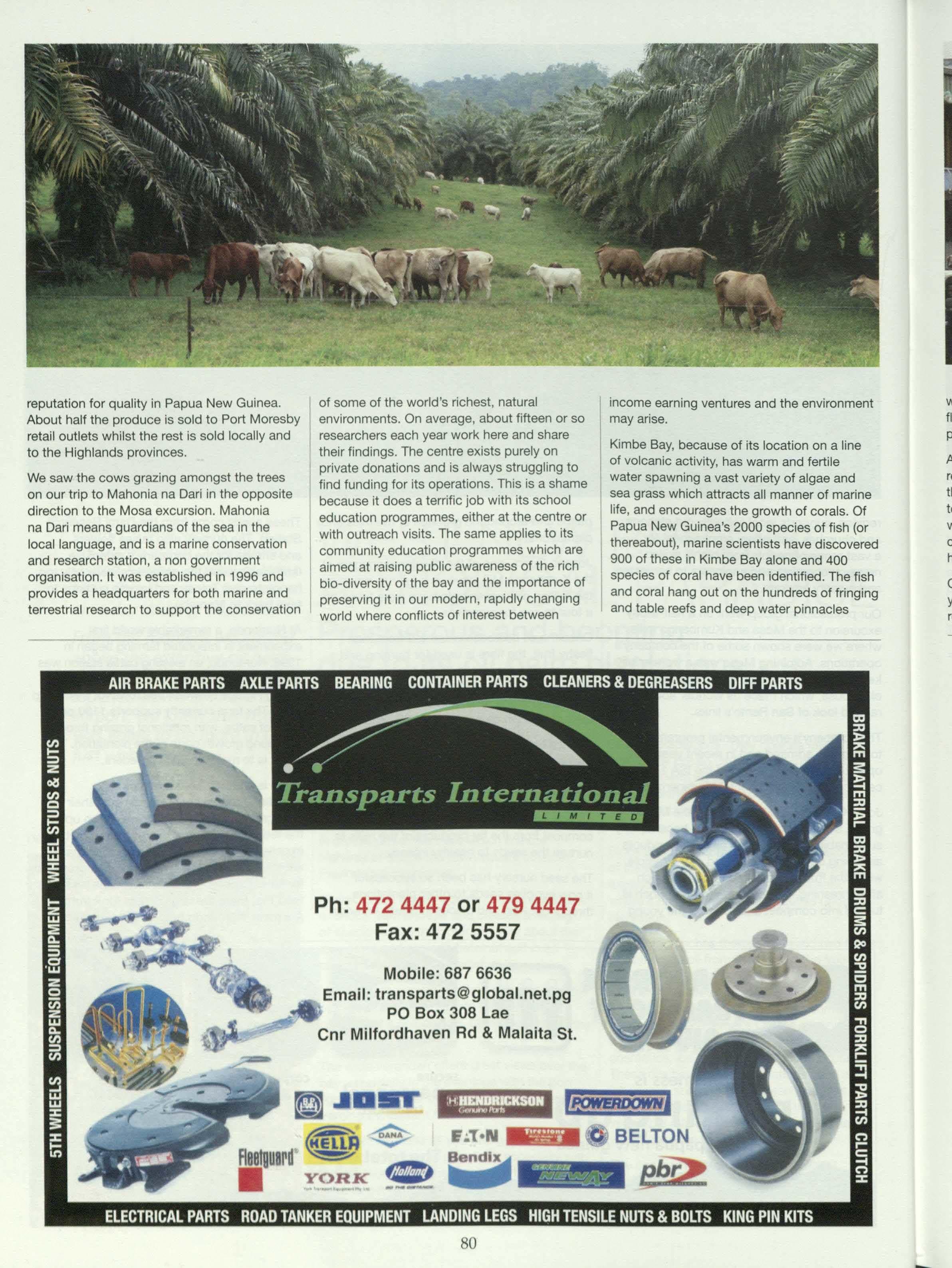
of some of the world's richest, natural environments. On average, about fifteen or so researchers each year work here and share their findings. The centre exists purely on private donations and is always struggling to find funding for its operations. This is a shame because it does a terrific job with its school education programmes, either at the centre or with outreach visits. The same applies to its community education programmes which are aimed at raising public awareness of the rich bio-diversity of the bay and the importance of preserving it in our modern, rapidly changing world where conflicts of interest between
income earning ventures and the environment may arise.
Kimbe Bay, because of its location on a line of volcanic activity, has warm and fertile water spawning a vast variety of algae and sea grass which attracts all manner of marine life, and encourages the growth of corals. Of Papua New Guinea's 2000 species of fish (or thereabout), marine scientists have discovered 900 of these in Kimbe Bay alone and 400 species of coral have been identified. The fish and coral hang out on the hundreds of fringing and table reefs and deep water pinnacles
By PatrickMatbob

empi villagers who live 20 kilometres north of Madang still talk about the time when 'Robinson Crusoe' came to live amongst them.
It was in 1993 when the villagers were privileged to witness and be involved in the production of a world class movie starring Pierce Brosnan as Crusoe. Such was the isolation of the people from the world of movie stars that they had no idea who Pierce Brosnan was before he arrived. But some did remember the classical hero Robinson Crusoe from Daniel Defoe's book and for them Brosnan was Crusoe.
During the days when parts of the movie were shot at Rempi, the whole village came to a standstill. Some villagers got jobs on the set as assistants during the shooting while the rest abandoned all daily activities - even the sacred Sunday worship - to witness this new activity.
Robinson Crusoe was probably the biggest movie ever produced in PNG starring a world renowned movie star. Co-starring as Crusoe's companion, Friday, was PNG's own actor and playwright William Takaku who received positive reviews for his role.
An internationalfilm crewfilming in Madangat variouslocations.
While there is no established movie industry in PNG, filming in the country has had a long history. The first film produced in Papua New Guinea is believed to be Frank Hurley's Pearl and Savage in 1926 about life along the Papuan coast.
Such ethnographic documentaries about the life and culture of the people were the types of educational films produced in PNG for the interest of western audience.
In the 1930s, the Leahy brothers who were exploring for gold in the interior of PNG stumbled onto a million people with no previous contact with outsiders living in the fertile valleys of the Highlands.
The brothers took many pictures, both still

photographs and film, of their first contact with the Highlands' tribes. The footage taken by the Leahys became famous in the 1983 feature length documentary First Contact by Bob Conolly and Robin Anderson.
The movie, which told the story of the Leahy brothers' historic contact with the Highlanders, was the first of The Highlands Trilogy that also featured the films Joe Leahy's Neighbours and Black Harvest.
Joe Leahy's Neighbours is a contemporary story of the legacy of the Leahys' presence in the Highlands. The movie features Joe Leahy, the mixed-race son of Michael Leahy, who is a successful businessman operating a coffee plantation in the Highlands.
He and the Ganiga tribe have a very delicate business relationship in a joint venture coffee plantation at Kaugum, which promised substantial returns.
However, many factions within the tribal community are suspicious of Joe and his longterm business plan. The third sequel Black Harvest continues the story of the joint venture with Kaugum plantation which was confronted by a senseless tribal warfare and a drop in world coffee price.
The situation turns critical forcing Joe Leahy's family to abandon their home and flee for safety. The joint venture and dreams of prosperity for Joe and the Ganiga lie in ruin.
The films won many international awards
A rarepicture of the late Austrnlin11mavie stnr Chips Raffertywith the localsat the Mou11tHagen Show in 1965,eight yenrs after starring i11tiremovie Walk Into Paradise.(Picture take11from Taim Bipo:A selectio11of old photographsfrom PapuaNew Gui11ea1880-1960sby journalist Mike Coutts).
including the Grand Prix at the Festival Cinema du Reel in Paris and the AFI Award for Best Documentary.
The first Oscar for a film shot in PNG was won by Kokoda Front Line! in 1943. The award was given for the best documentary based on footage taken by Australian film hero, Damien Parer.
Parer shot the footage of the Battle of Kokoda
which raged for seven months between the Japanese and the Australian armies on some of the most rugged and inhospitable terrain in the world.
Parer, described as an uncompromising chronicler of armed conflict, was a film-maker with the 2nd Australian Infantry Force and served in the Middle East, then PNG. His film brought the war home to Australia who saw
For a complete range of Wholesale Electrical Supplies
PortMoresby
P.O.Box143,Boroko
Ph:3255300
Fax:3259020
Email:admin@pom.esco.com.pg
Lae
P.O.Box1806,lae
Ph:4721933
Fax:4723043
Rabaul / Kokopo
P.O.Box2153,Rabaul
Ph:9829154
Fax:9829170
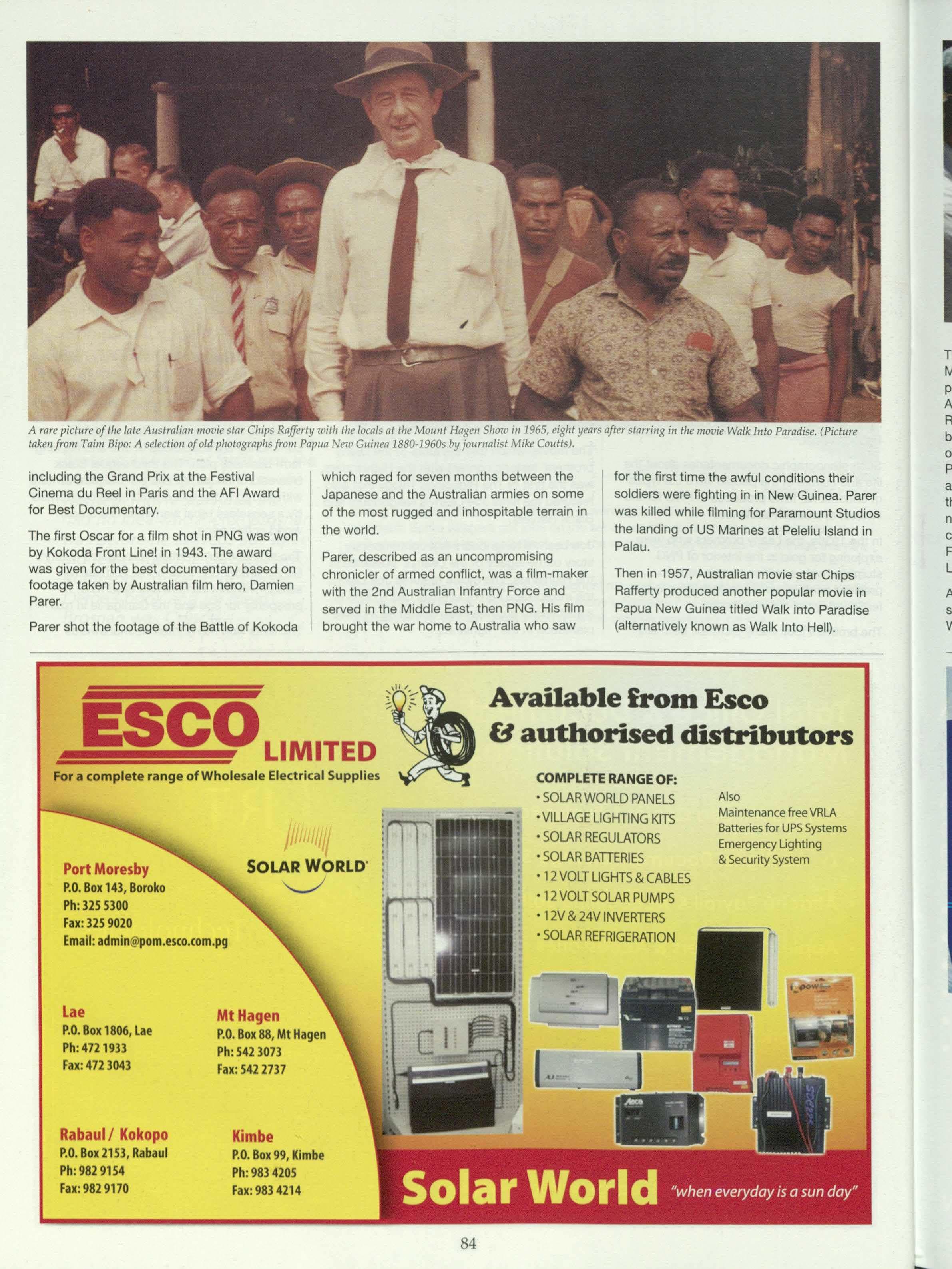
for the first time the awful conditions their soldiers were fighting in in New Guinea. Parer was killed while filming for Paramount Studios the landing of US Marines at Peleliu Island in Palau.
Then in 1957, Australian movie star Chips Rafferty produced another popular movie in Papua New Guinea titled Walk into Paradise (alternatively known as Walk Into Hell).
COMPLETERANGEOF:
• SOLARWORLD PANELS Also
·VILLAGE LIGHTINGKITS
• SOLARREGULATORS
• SOLARBATTERIES
• 12 VOLTLIGHTS& CABLES
• 12 VOLTSOLARPUMPS
• 12V & 24V INVERTERS
• SOLARREFRIGERATION
Maintenancefree VRLA Batteriesfor UPSSystems EmergencyLighting & SecuritySystem
Mt Hagen
P.O.Box88,Mt Hagen
Ph:5423073 Fax:5422737
Kimbe
P.O.Box99, Kimbe
Ph:9834205
Fax:9834214
The movie stars Senior Patrol Officer Steve McAllister (Chips Rafferty) who leads a patrol in the interior of PNG. It portrays the Australian colonial romanticism in which Rafferty bears the white man's burden of bringing civilisation to the primitive people of PNG. The film was shot on location in PNG on the Sepik River and in the Highlands and showed some remarkable footage of the Sepik and the Highlands singsing. A noted feature of the film was that it was co-produced in English and French and the French version released in Paris was titled L'Odyssee du Capitaine Steve.
A number of documentaries were produced since the 70s in PNG which included Wokabaut Bilong Tonten by Film Australia
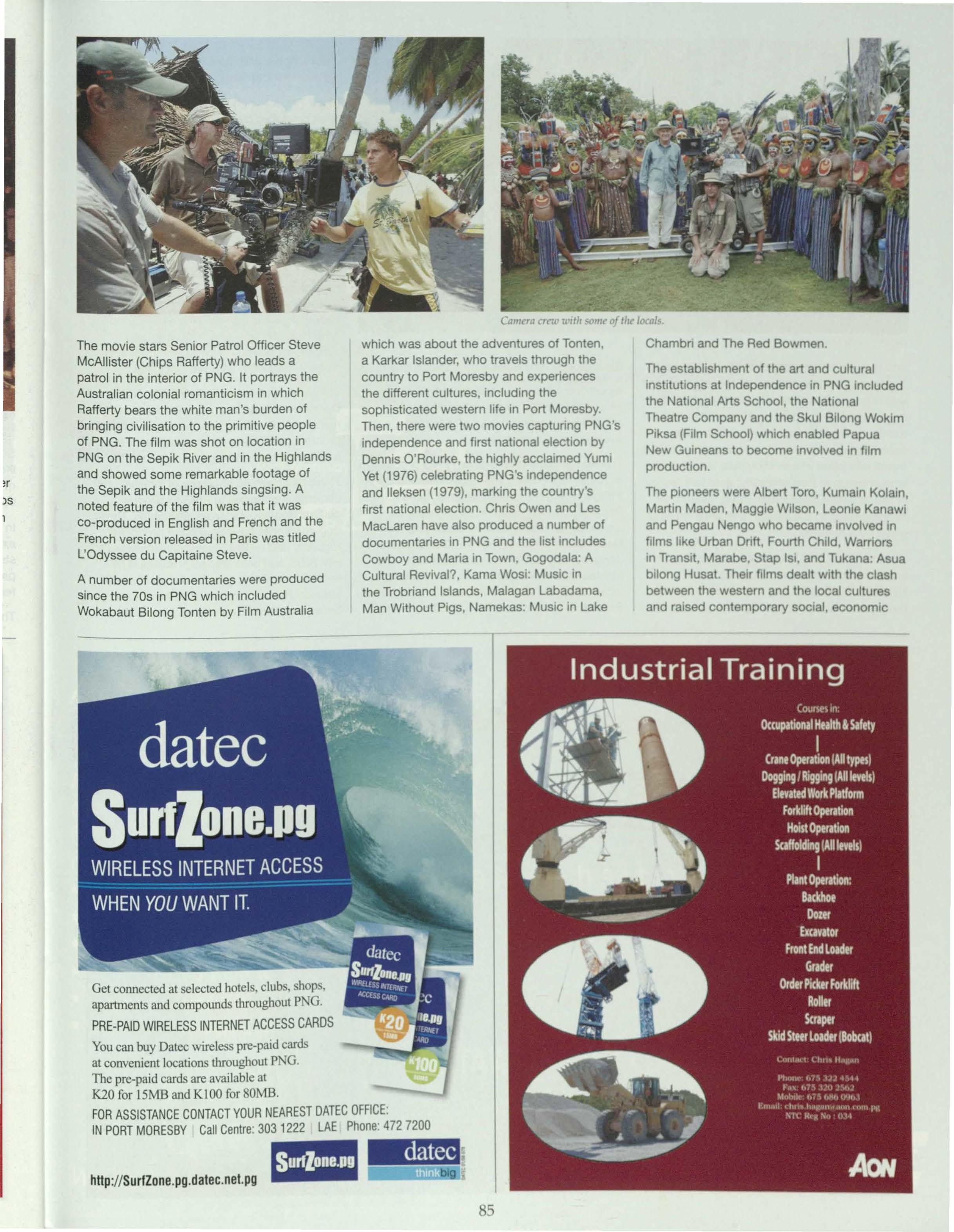
Get connectedat selectedhotels,clubs,shop , apartmentsand compoundsthroughoutP G.
PRE-PAIDWIRELESSINTERNETACCESSCARDS
Youcan buy Datec wirelesspre-paidcards at convenientlocationsthroughoutP G. The pre-paidcards are availableat K20 for 15MBand KI00 for 80MB.
which was about the adventures of Tonten, a Karkar Islander, who travels through the country to Port Moresby and experiences the different cultures, including the sophisticated western life in Port Moresby. Then, there were two movies capturing PNG's independence and first national election by Dennis O'Rourke, the highly acclaimed Yumi Yet (1976) celebrating PNG's independence and lleksen (1979), marking the country's first national election. Chris Owen and Les Maclaren have also produced a number of documentaries in PNG and the list includes Cowboy and Maria in Town. Gogodala: A Cultural Revival?, Kama Wosi: Music in the Trobriand Islands, Malagan Labadama, Man Without Pigs, Namekas: Music in Lake
Chambn and The Red Bowmen.
The establishment of the art and cultural institutions at Independence in PNG included the National Arts School, the National Theatre Company and the Skul Bilong Woklm Piksa (Film School) which enabled Papua New Guineans to become involved in film production.
The pioneers were Albert Toro, Kumain Kolain, Martin Maden, Maggie Wilson, Leonie Kanaw1 and Pengau Nengo who became involved In films like Urban Drift, Fourth Child, Warriors in Transit, Marabe, Slap lsI, and Tukana: Asua bilong Husat. Their films dealt with the clash between the western and the local cultures and raised contemporary social, economic
Getting rendy to shoot a scene.
and political issues that affected Papua New Guineans. Marabe addressed the issue of land and urban drift and tells the story of a village councillor, Marabe, whose sons Hawai and Kerebe leave for a 'better life' in the urban centres of Goroka and Port Moresby. Kerebe is eventually killed in a land dispute and Hawaii, who ends up in Port Moresby, gets tangled up in all the social ills of urban living, eventually heading back to the village to resettle on land given by a relative.
The movie's sound track featured music written and performed by music students of the National Arts School and a favourite track was the Marabe farewell featuring Aaron Murray on
the flute and Tony Subam on classical guitar. Albert Toro who wrote the script for Tukana also starred in the lead role together with actress Francisca Semoso who is now a politician on Bougainville.
The first genuine home-grown PNG production is Tinpis Run (1990). The movie directed by Pengau Nengo is about the adventures of Papa who owns a PMV which he uses as a taxi. Other main characters are his driver Naaki and his fiercely independent daughter Johanna. The adventures take him from the highlands to the coast of Lae and Madang where they get involved in politics. Later, when Papa gets word of a brewing tribal fight, he
returns home and dons his battle gear to lead his warriors into war.
Since Tinpis Run, no other major films have been produced by Papua New Guinean producers and this is attributed to the high costs of film making in the country. Lack of copyright laws has also been seen as a major hurdle in assisting the growth of a film industry.
Chris Owen, an Australian residing permanently in PNG, is also one of PNG's leading filmmakers, who amongst a number of films produced the award winning Bride wealth for a Goddess (1999). The film is about Highlands' 'Big Man' Ru Kundil who tells his own story in film. Kundil has a dream about a beautiful young woman - the Spirit Goddess Amb Kor - and involves his family and supporters in a cult in which the men seek to make a 'marriage' with the Goddess.
Through elaborate rituals, the Goddess grants the men purification and protection from the menstrual powers of their human wives, the procreation of many sons, and the blessing of fertility to crops and pigs.
There has been no shortage of international film-makers coming to PNG to film the cultural and geographical attractions. News documentaries have also been produced regularly and recent topics have included HIV/AIDS and environmental issues. The establishment and growth of a local movie industry has remained elusive however, because of lack of money and support.
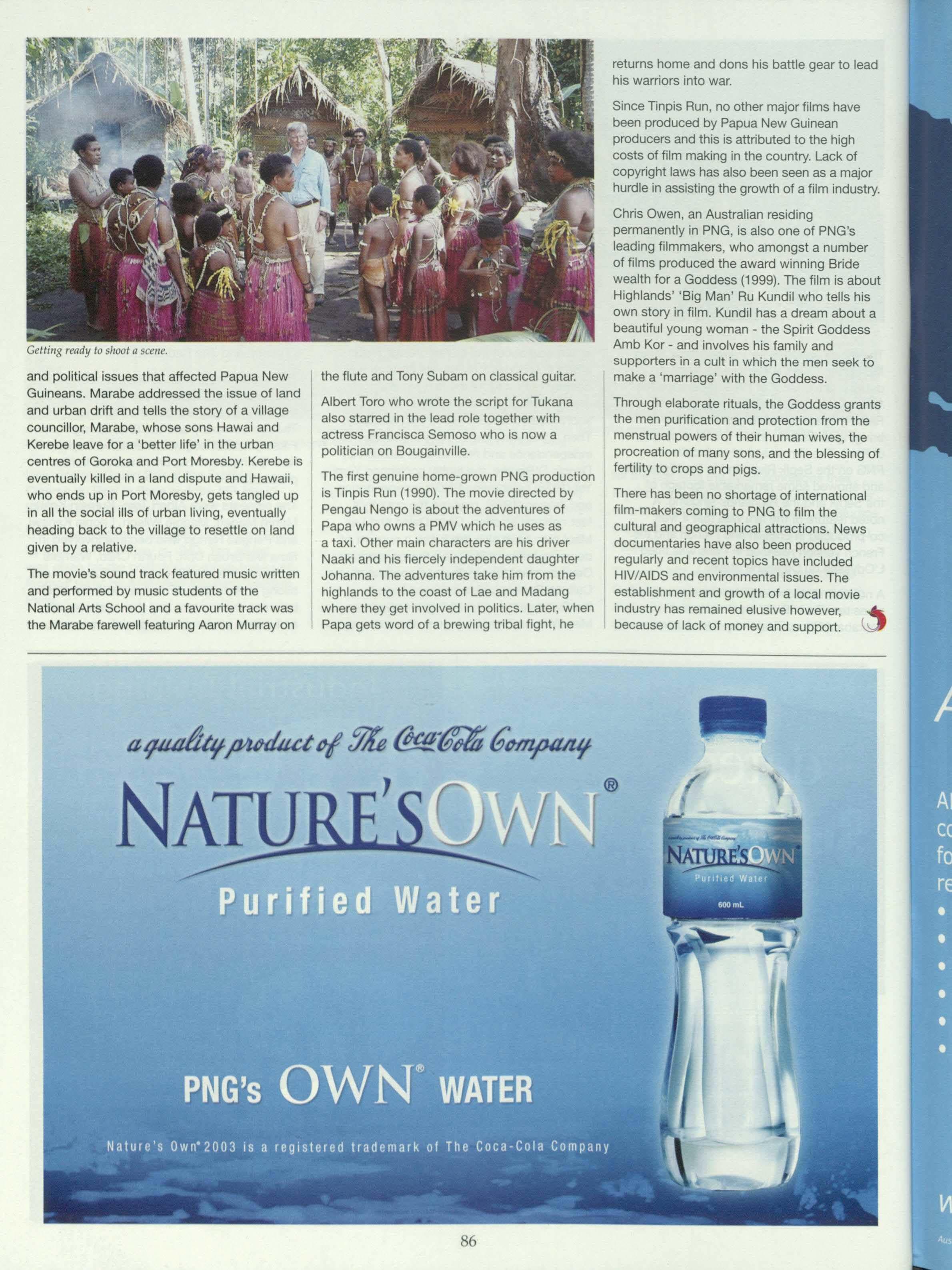
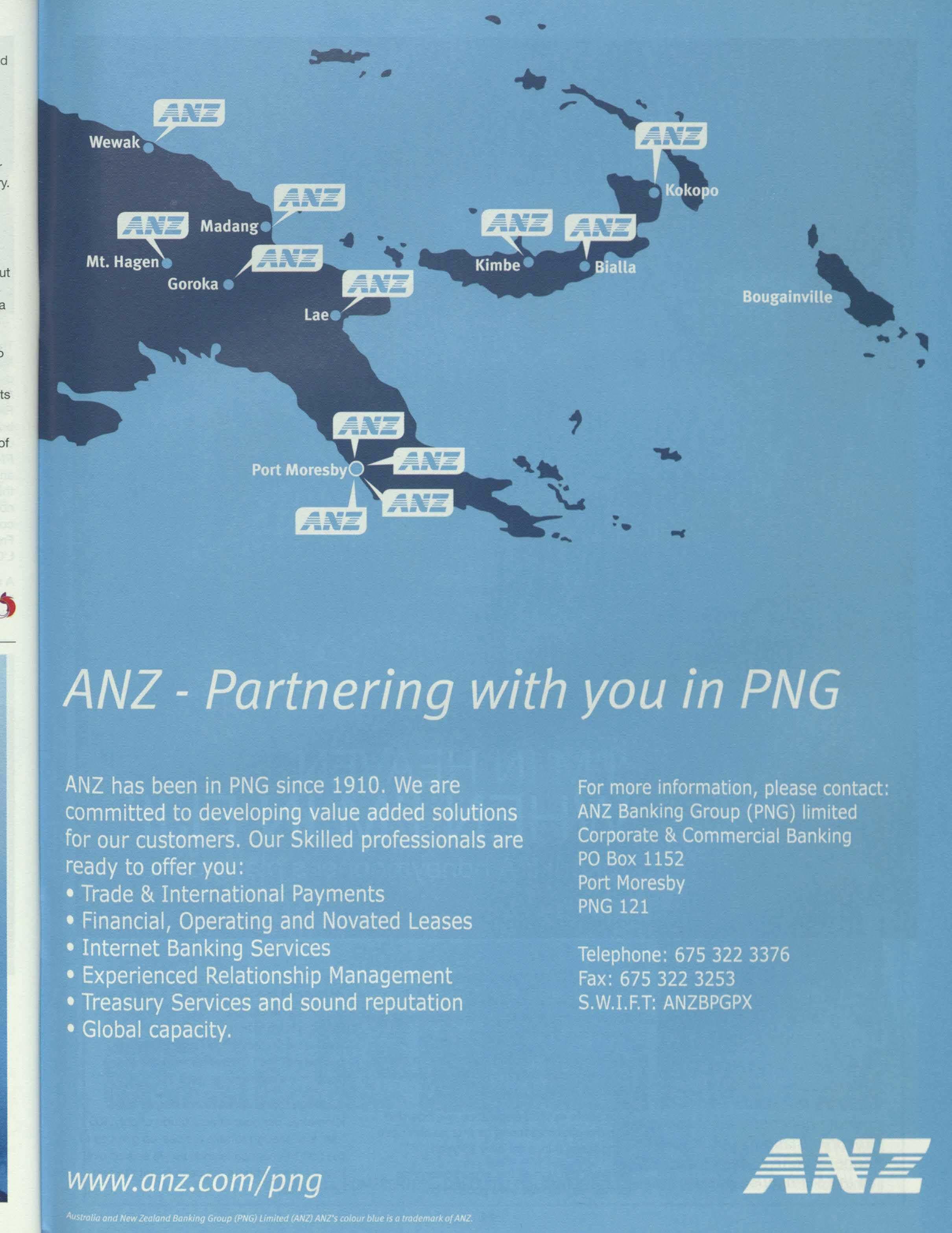
t was 5am, the alarm had just gone off; I knew this was going to be one of those days I would never forget!
We had to be at Nadi International Airport at 6.30am to catch a 10minute heli apter flight to Tokoriki Island Resort, a honeymooners' playground in the Mamanuca Island .
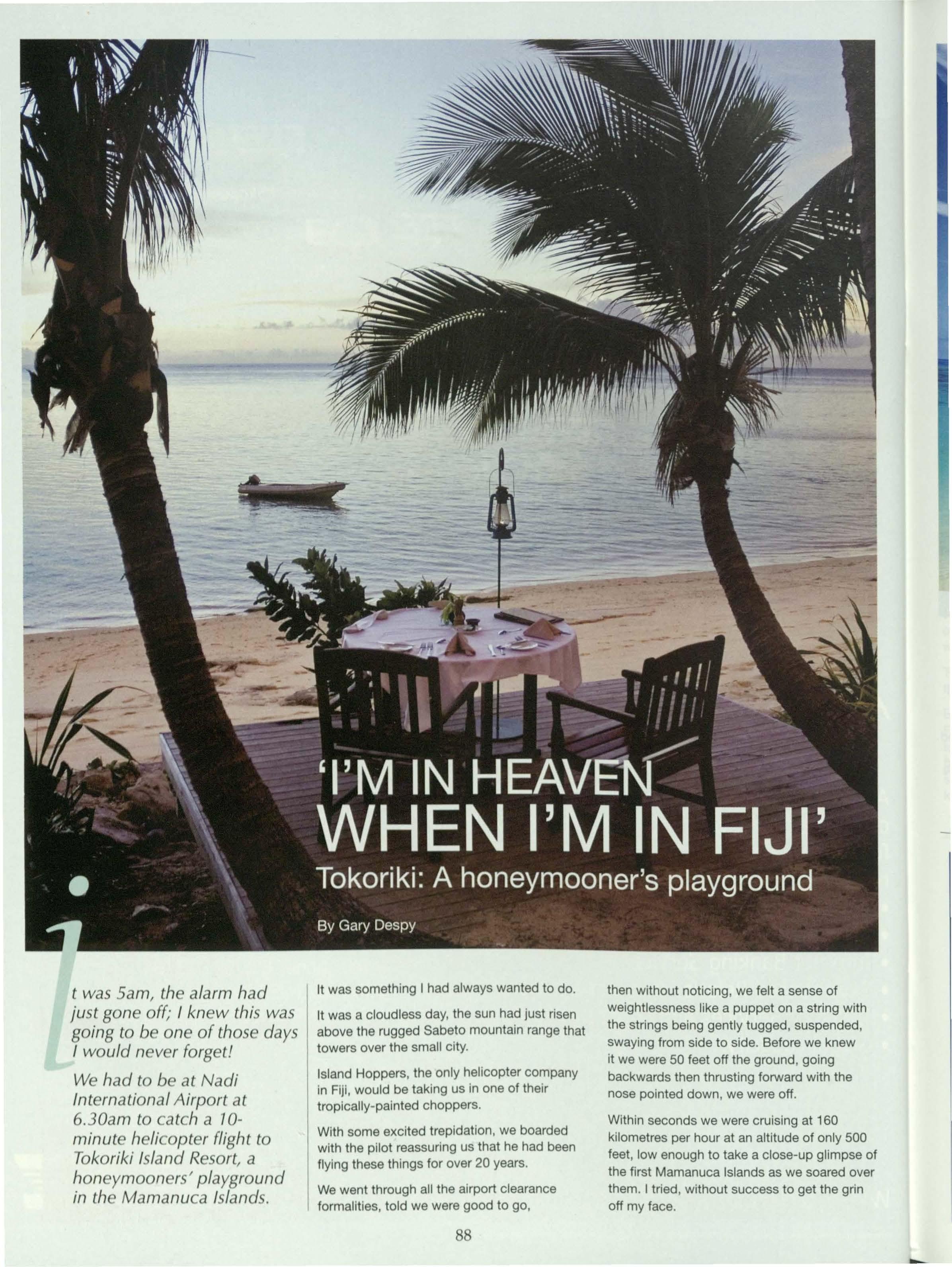
It was something I had always wanted to do.
It was a cloudless day, the sun had just risen above the rugged Sabeto mountain range that towers over the small city.
Island Hoppers, the only helicopter company in Fiji, would be taking us in one of their tropically-painted choppers.
With some excited trepidation, we boarded with the pilot reassuring us that he had been flying these things for over 20 years.
We went through all the airport clearance formalities, told we were good to go,
then without noticing, we felt a sense of weightlessness like a puppet on a string with the strings being gently tugged, suspended, swaying from side to side. Before we knew it we were 50 feet off the ground, going backwards then thrusting forward with the nose pointed down, we were off.
Within seconds we were cruising at 160 kilometres per hour at an altitude of only 500 feet, low enough to take a close-up glimpse of the first Mamanuca Islands as we soared over them. I tried, without success to get the grin off my face.
Not knov.,ng ¾hue He \H'rP JJOmgto land v.,p froze in our seats cl!> we almo~t hru hed the tops of tin palm trc e
All too quickly, we had Tokorki in our sight, the coral reef clearly visible through the stunning turquoise sea forming a barrier to protect the island.
Our pilot chose to come in from the back of the island, making a steep left hander, following the coast until we started to descend. Not knowing where we were going to land we froze in our seats as we almost brushed the tops of the palm trees.
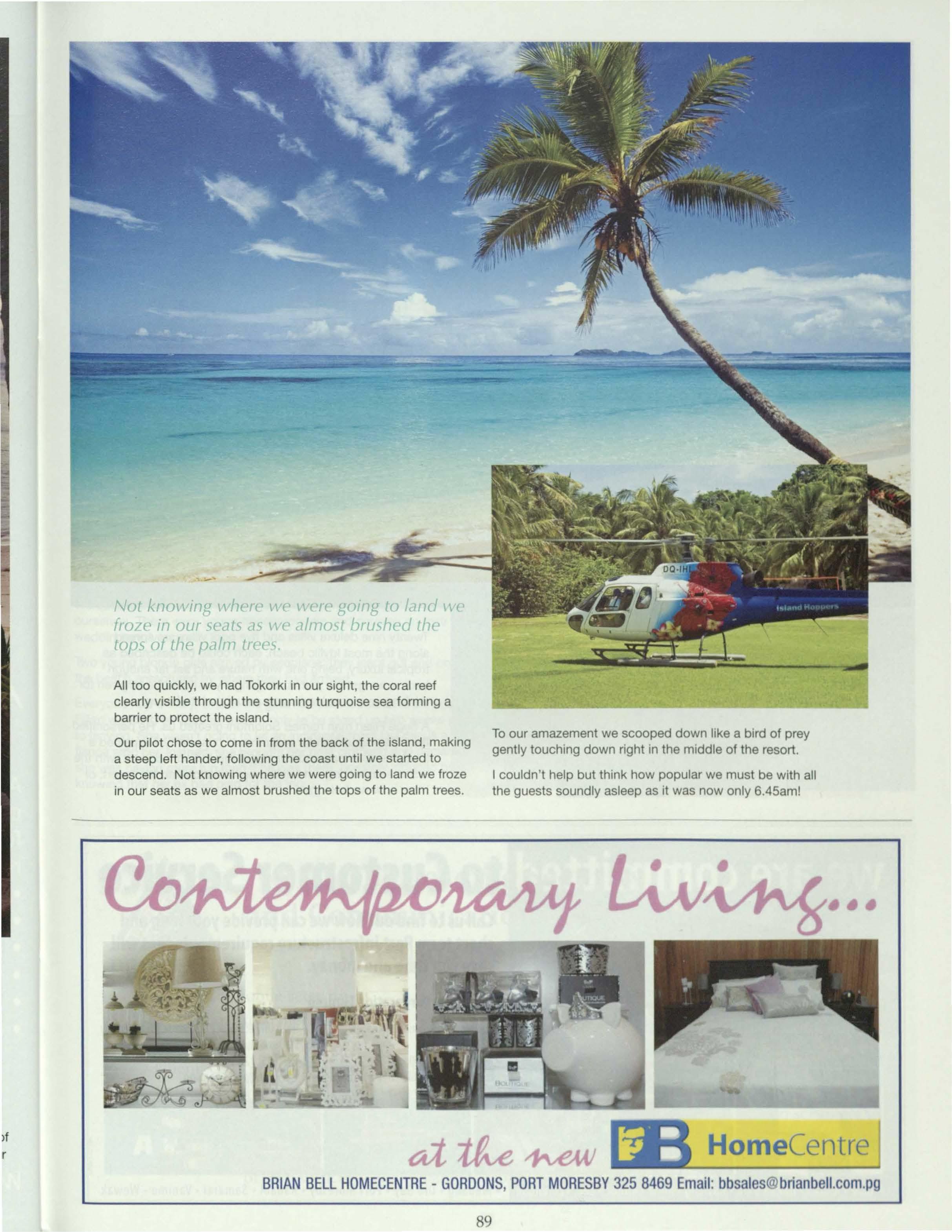
To our amazement we scooped down like a bird of prey gently touching down right in the middle of the resort.
I couldn't help but think how popular we must be with all the guests soundly asleep as it was now only 6.45am!
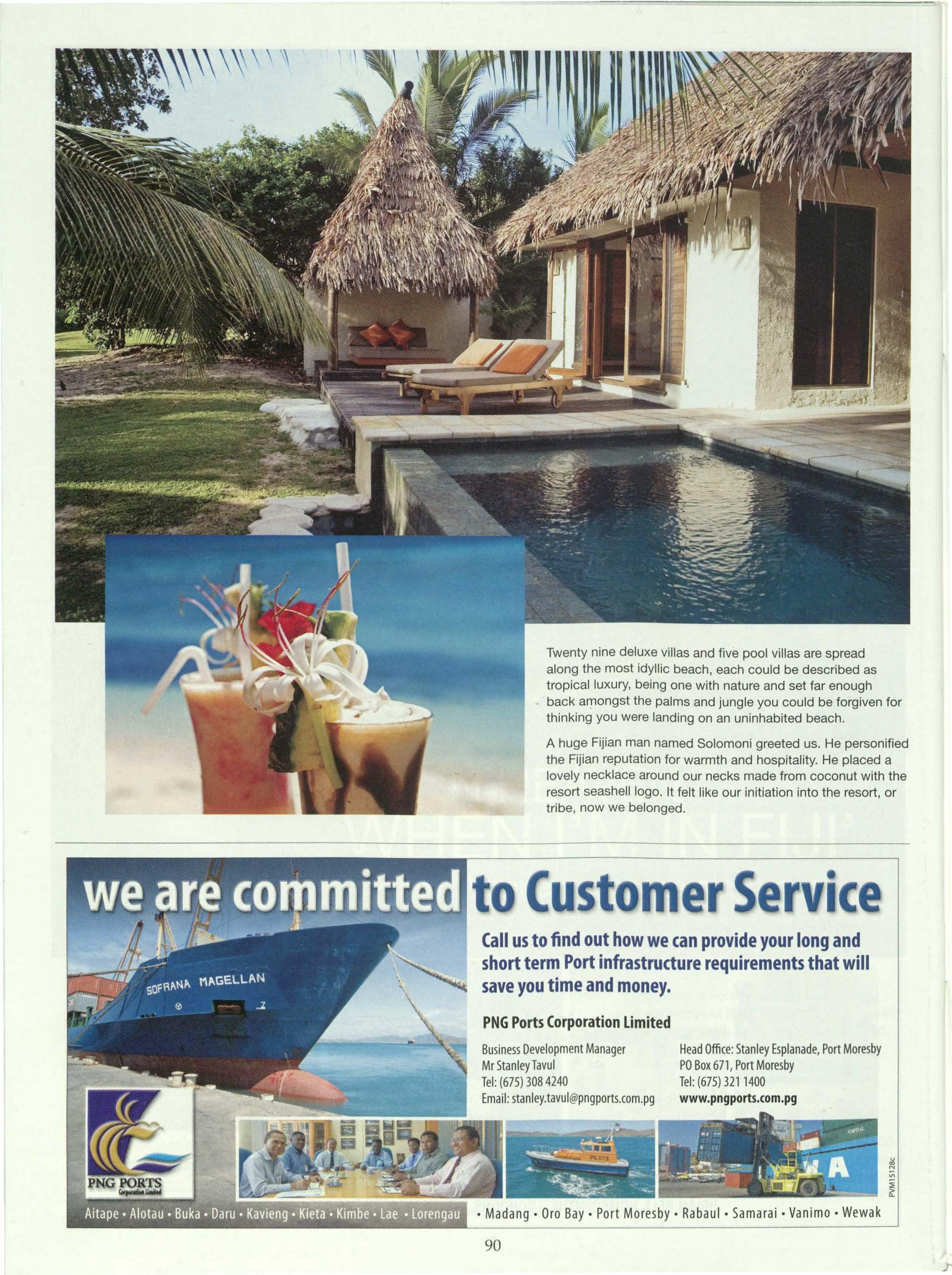
Twenty nine deluxe villas and five pool villas are spread along the most idyllic beach, each could be described as tropical luxury, being one with nature and set far enough back amongst the palms and jungle you could be forgiven for thinking you were landing on an uninhabited beach.
A huge Fijian man named Solomoni greeted us. He personified the Fijian reputation for warmth and hospitality. He placed a lovely necklace around our necks made from coconut with the resort seashell logo. It felt like our initiation into the resort, or tribe, now we belonged.
People came from all over the world, mostly Kiwis and Australians, to indulge in the unique experience that few resorts in the Pacific seem to have perfected.
We quickly became part of the tribe's family - sharing stories amongst ourselves. There were young honeymooners and couples on their 20th wedding anniversary.
Two young blonde girls arrived by seaplane; they leapt out and on to the beach enraptured by where they had arrived.
Everyone had a story. One of the girls had planned to have an exotic Fijian wedding on Tokoriki beach, only to be stood up two weeks prior to leaving. She wasn't going to let an incidental thing like minus a fiance stop her. Instead, she brought her best girlfriend and declared she was having more fun than if he was there, possibly induced by knowing that her ex had paid for the trip.
- Static and mobile security
- Armed and unarmed escorts
- Attack dog security teams
- Client radio network support and monitoring
- Extensive UHF and VHF radio network
- 24 hour monitoring control room
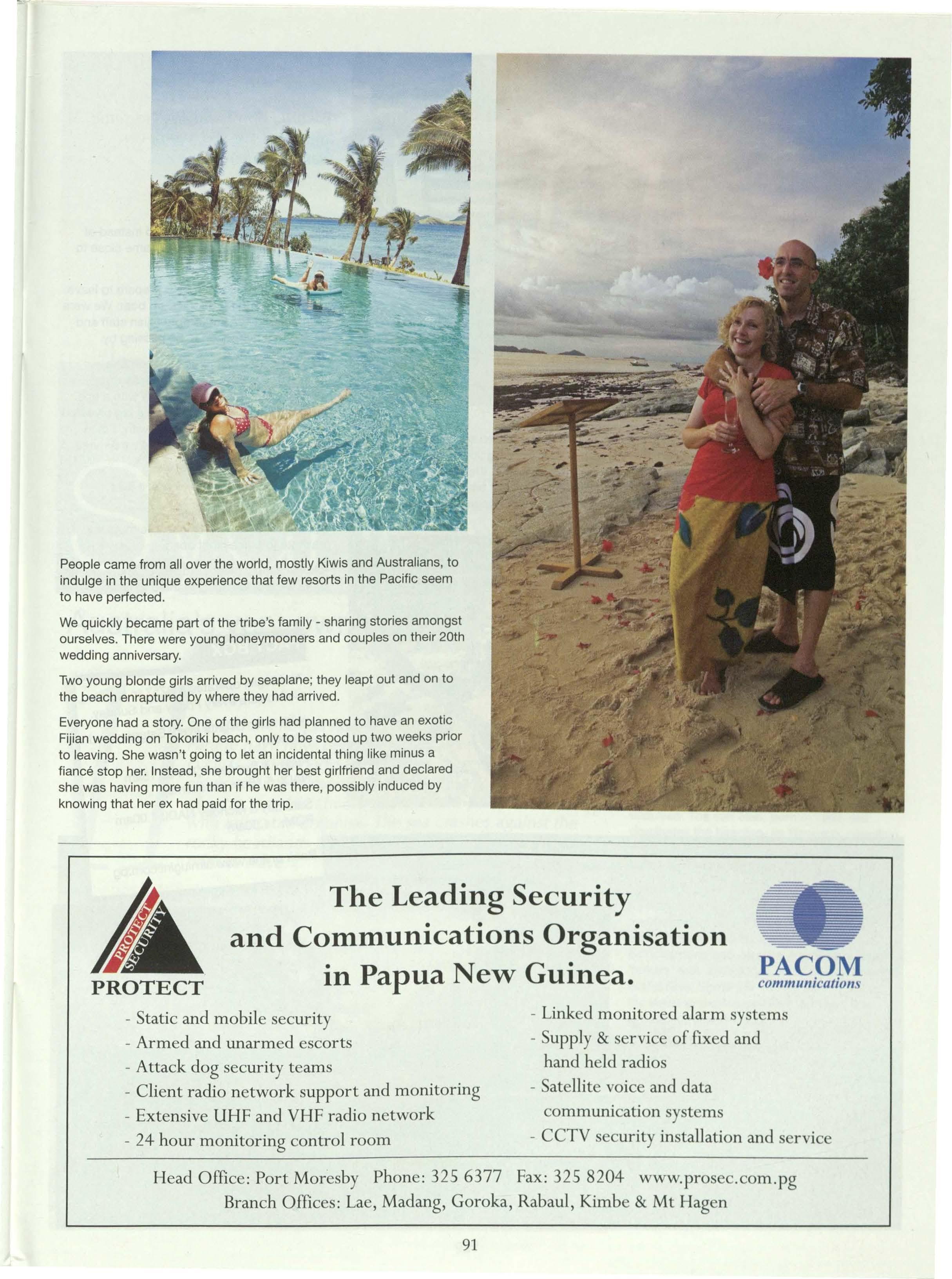
- Linked monitored alarm sy tern
- Supply & service of fix d and hand held radio
- Satellite voice and data communication systems
- CCTV security installation and service
Head Office: Port Moresby Phone: 325 6377 Fax: 325 8204 www.prosec.com.pg
Branch Offices: Lae, Madang, Goroka, Rabaul, Kimbe & Mt Hagen
In the end, everything turned out for the best and the would-be bride decided to still get married on Valentine's Day on the beach but not as a bride but groom as the whole bride thing wasn't working for her.
Another couple, married seven years, decided to renew their wedding vows. Having three children in succession they had never had a holiday together, nor time to talk. Now in paradise and time to open up for the first time,
Toknriki simply meanc; "to s1:.'ttle" .md settle 1H did, we ne1,,er wanti->dto /eJ1,,e
they found they didn't get on, so instead of renewing their wedding vows, came close to having a beach divorce!
Before we knew it, we had to prepare to leave, relaxing, waiting for our pick-up boat. We were surrounded by an impromptu Fijian staff and anyone that happened to be passing by.
One was armed with a guitar, another a ukulele; a few moments later in mid song another appeared spontaneously with a one string base primitively built from a big plywood box. We were being serenaded with "I'm in heaven when I'm in Fiji" and finally their very own Tokoriki farewell song.
We were moved beyond words, it was unforgettable!
The more the world changes, the more we gravitate to places that don't.
Tokoriki simply means "to settle" and settle we did, we never wanted to leave. V
P4i•=t•t\
~; ~~u;;~~ao:v:ryat~s_ad8757 to Nadi n ay and Sunday With return flights • Monday. every Saturday and
Friday & Sunday POM· NADI· 5 • 09.1Sam • •1Spm (local time)
Saturday & Monda POM: 11.00am y NADI: 7.00am
Book on1,·ne www.a,rniug· • In1.com.pg -
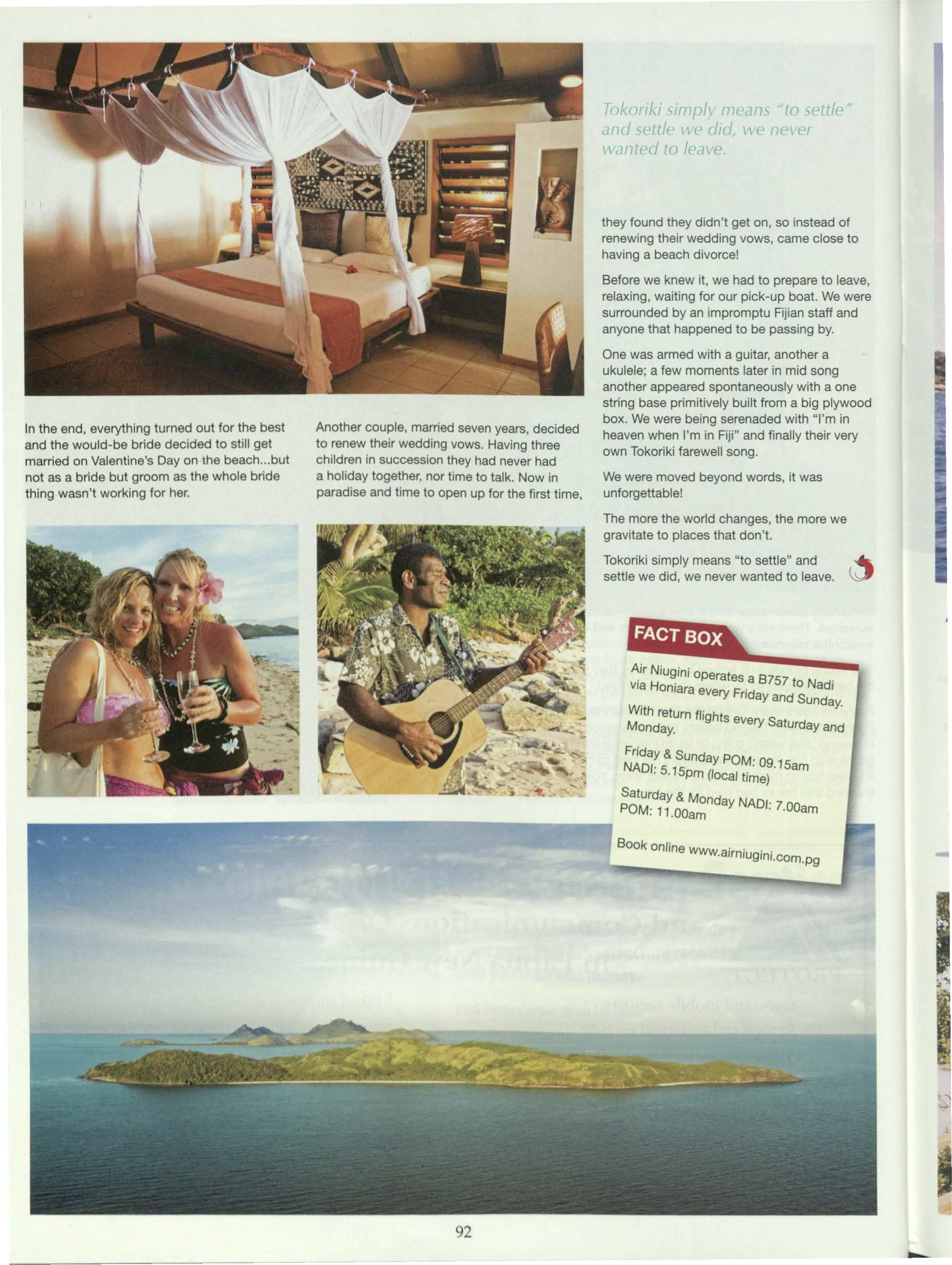
am and the fitness fanatics ambling around Marine Parade have now been joined by energetic dog walkers, cyclists and the odd rollerblader, all seeking that first electric buzz of morning. Below them, young children play on sun-drenched beaches, their parents wrestling with inflatable dolphins. The sea crashes against the rocky headlands and surfers wait patiently for that perfect wave.

Mid-day and as the rest of the world descends on Manly's bustling Corso, the church bells ring in time to the tills of coffee shops.
Despite the influx of new visitors the character of this beautiful coastal suburb remains largely unsullied. The surf club, born in 1902, still dominates the beaches, its lifesavers patrolling them diligently whilst age-old pine trees defend the promenade.
Likewise, the ferry terminal itself retains its personal charm even as It expands to meet the increasing demand. And If there's a better way of seeing Sydney Harbour, I'd be richly surprised. May be, this Is how New Yorkers' feel, travelling to work on the Staten Island ferry. Somehow I doubt It as I soak up the views of expensive real estate and the oncoming rush of the city.
Sydney Harbour Bridge waits proudly to greet us. The Opera House blinks in the sun. Innumerable yachts lean Into the wind like balloons caught on a breeze, their colourful sails billowing under blue skies. No, this Isn't New York though some things do feel familiar.
2pm - In the Botanical Gardens, young office lovers make their way back to work as I slurp on Crab 'n' Corn soup. With a population of some four million, Sydney Is Australia's chief commercial, financial and Industrial centre

JOA is an internationallyrecognisedrecruitmentconsultancy.We providea comprehensiveand innovativerangeof humanresources managementservicesto the mining, constructionand resources sectors. Foundedin 1990, JOA has successfullyimplemented recruitmentcampaignsfor miningand constructionprojectsaround the globe. We currentlyemploy over 100 staff, and developand maintainquality relationshipswith the world's leadingresources companies.Withofficesin severalcountriesincludingAustralia,Papua NewGuinea,Indonesia,NewCaledoniaandChina,wearewellplacedto providesuperiorrecruitmentsolutionsnowandintothefuture.
Knowledgebase:
Ourdatabasehasaccessto morethan79,000candidatesin Australia, 33,000in PapuaNewGuinea,andover47,000in ChinaandIndonesia, bothexpatriateandnational,unrivalledin the recruitmentindustry.
Clientpartnership:
We go the extramile and treat our clientsas businesspartners.To ensurea successfulbusinesspartnershipand to achievethe kinds of positiveoutcomesour clientsexpect,we work alongsidethemto achieveresults.
Industryexpertise:
Our highly-qualifiedaccountmanagersand consultantsknow our clients'businessthroughfirst-handindustryexperience.
Proactiveapproach:
Weare knownfor our abilityto locatedifficult-to-findpeoplebecause of our proactivesearchtechniques.
Wearefirstbychoice:
Ouraccountmanagersandconsultantscomefrom technical,tradeor industrialbackgroundsso theyunderstandyour business.Theirfocus is on supplyingyouwith reliable,highqualitypersonnel.Tosustainour highstandardswevalueandencourageyourfeedback.
Ourservices:
• PermanentRecruitmentof PNGcitizen/Expatriatepersonnel
• Contractrecruitment - Supplyof PNG citizen labourhire personnel
• Payrollbureauservice
• Provisionofvisas,shorttermworkpermits,andlongtermwork permits
• Establishment of NTCThreeYearTrainingPlans
• ExecutiveSearch
• Psychometricassessment
• Travel& Logistics
• Salary& RemunerationSurveys
Recruitmentand/orsourcingcontractorsfor theclientwill bemanaged by theWokmanPortMoresbyoffice.
All PNGcitizentradescontractorsourcingwill be managedby GordonKevan - TeamLeaderContracting.
All PNGcitizenrecruitmenVsourcingwill befacilitatedby StephenMead- SeniorRecruitmentConsultant.
All Non-PNGCitizenrecruitmenVsourcingwill befacilitatedby PeterGarnseyandPaulMason - BusinessDevelopmentManagers.
PORTMORESBY - 6th FloorPacificPlace, CornerMusgraveRoad& ChampionParade. POBox2530,Boroko,NCD,PNG
Ph:(675)3210800• Fax:(675)3210806• Email:info@wokman.com.pg Brisbane+617 31200900• A3/5GrevllliaPlace,EagleFarm,OLD,4009
as well as a mecca for tourists. Including representatives from China, Greece, Italy, former Yugoslavia and Thailand, almost a quarter of its citizens were born overseas, and with only a fraction of its residents indigenous Aborigines, it is still their most popular home.
Between such landmarks as the Archibald Memorial Fountain and Chifley Plaza, the sun is blocked out and Victorian architecture wrestles with huge circular pillars, skyscrapers heavy in glass and stone. The people share a sense of style and fashion that would not be lost on the streets of New York or London and the buildings themselves boast such continent straddling names as Nestle, IBM, Ernst & Young.
Perhaps as a consequence of the city's financial buoyancy, Sydney's traditional tourist attractions seem somewhat outshone today. Even the Opera House, so long seen as Sydney's cultural heart, is dwarfed by the nearby Quayside. Still, the spirit remains and below us live jazz floats from a sidewalk cafe. I follow it on foot, past stone statues that move (rather like drama students) and along the Writer's Walk, across the water and towards The Rocks.

4pm - A curious mix of the old and the new, the Rocks, Sydney's first non-Aboriginal settlement, was once famous for its more squalid enterprises and raucous behaviour. Now the area has been converted into pleasant tea-rooms and quaintly fronted gift shops, often using the original colonial structures. I sip a cappuccino outside a French Patisserie, trying to resist the fruit tartlets and chocolate truffles inside, backed by cobbled streets and an art gallery. A fine example of tourism dollars well spent, this is the perfect place to break for refreshments before spending some dollars of my own.
Figuring my credit card doesn't stretch as far as the opulent boutiques of The Strand on George Street, I try the suburb of Newtown. Here, the traffic becomes that little bit heavier, the pavement noticeably dirty and the colours much more vivid. But what begins as a selection of museumlike second-hand shops soon explodes into a riot of fashion places, bookshops, record stores and oriental restaurants. By Sydney standards, it's possibly tatty and disordered but for a moment it's a welcome departure.
WokmanLimited is the leader in sourcing skilled technicaland professionalstaff and contractorsto all sectorsin PNG.Renownedfor havingoneof the most uniqueandpowerfuldatabasesin theindustry,wepride ourselveson the relationshipswe havedevelopedwith manyof PapuaNewGuinea'sleadingresource,private andpublicsectorcompanies.
Due to an unprecedenteddemandfrom all sectors of businessin PNG and Internationaldemandfor experiencedstaff we now seekto expandour existing data base and are inviting interestedexperienced suitablyqualifiedindividualsto sendtheir resumesto us:
• MiningEngineers
• StructuralEngineers
• MineSurveyors
• ProcessingSupervisors
• LaboratoryChemists
• Electricians
• Carpenters
• Plumbers
• HeavyEquipFitters
• Mechanics
• DiamondDrillers
• RCDrillers
• Boilermakers
• Welders
• MedicalProfessionals
• Hospitality
• CommunityAffairs
• CraneOperators
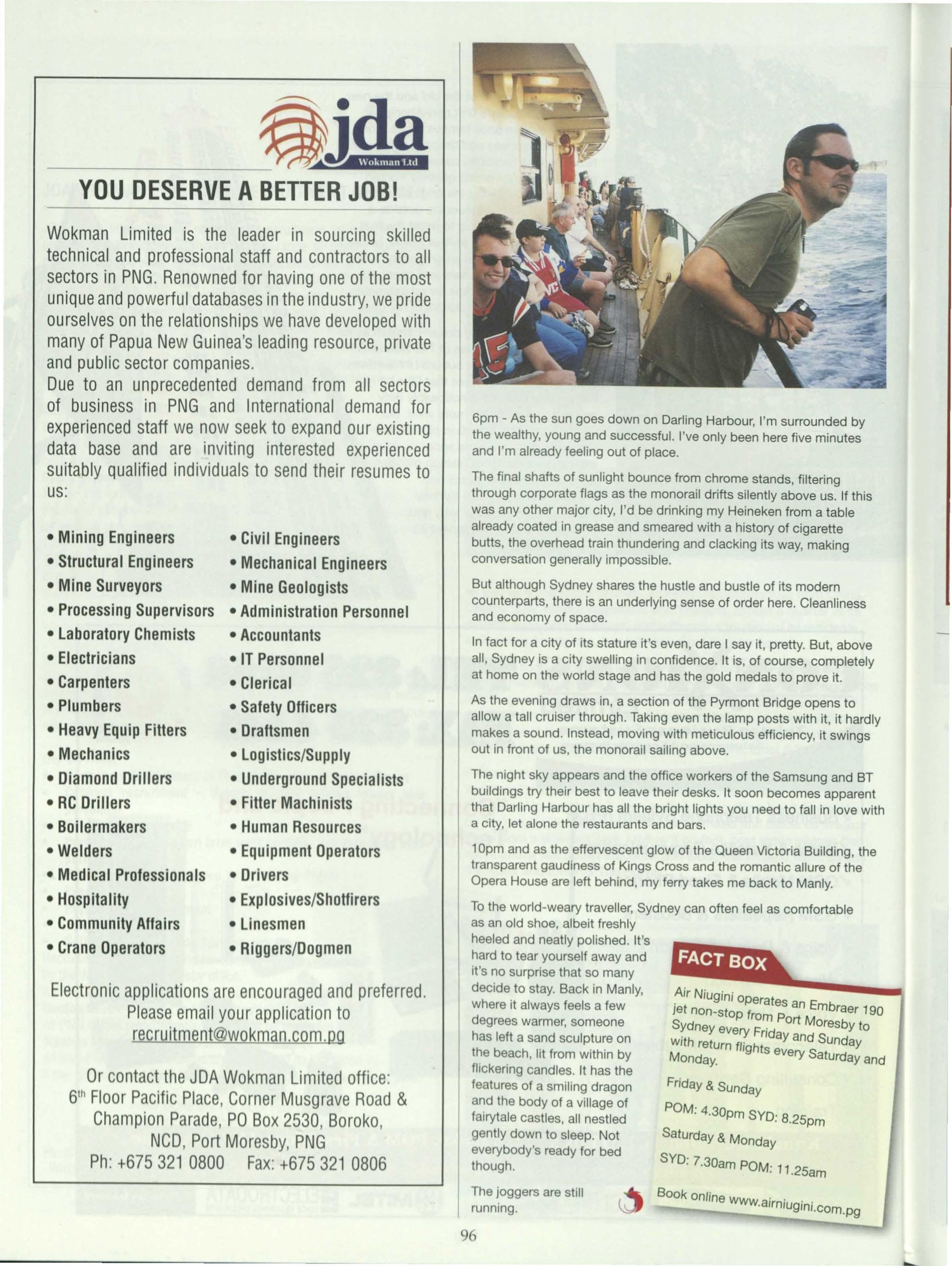
• CivilEngineers
• MechanicalEngineers
• MineGeologists
• AdministrationPersonnel
• Accountants
• IT Personnel
• Clerical
• SafetyOfficers
• Draftsmen
• Logistics/Supply
• UndergroundSpecialists
• FitterMachinists
• HumanResources
• EquipmentOperators
• Drivers
• Explosives/Shotfirers
• Linesmen
• Riggers/Dogmen
Electronicapplicationsareencouragedandpreferred. Pleaseemailyourapplicationto recruitment@wokman.com.pg
Orcontactthe JOAWokmanLimitedoffice: 6th FloorPacificPlace,CornerMusgraveRoad& ChampionParade,POBox2530,Boroko, NCO,PortMoresby,PNG Ph:+6753210800 Fax:+6753210806
6pm - As the sun goes down on Darling Harbour, I'm surrounded by the wealthy, young and successful. I've only been here five minutes and I'm already feeling out of place.
The final shafts of sunlight bounce from chrome stands, filtering through corporate flags as the monorail drifts silently above us. If this was any other major city, I'd be drinking my Heineken from a table already coated in grease and smeared with a history of cigarette butts, the overhead train thundering and clacking its way, making conversation generally impossible.
But although Sydney shares the hustle and bustle of its modern counterparts, there is an underlying sense of order here. Cleanliness and economy of space.
In fact for a city of its stature it's even, dare I say it, pretty. But, above all, Sydney is a city swelling in confidence. It is, of course, completely at home on the world stage and has the gold medals to prove it.
As the evening draws in, a section of the Pyrmont Bridge opens to allow a tall cruiser through. Taking even the lamp posts with it, it hardly makes a sound. Instead, moving with meticulous efficiency, it swings out in front of us, the monorail sailing above.
The night sky appears and the office workers of the Samsung and BT buildings try their best to leave their desks. It soon becomes apparent that Darling Harbour has all the bright lights you need to fall in love with a city, let alone the restaurants and bars.
10pm and as the effervescent glow of the Queen Victoria Building, the transparent gaudiness of Kings Cross and the romantic allure of the Opera House are left behind, my ferry takes me back to Manly.
To the world-weary traveller, Sydney can often feel as comfortable as an old shoe, albeit freshly heeled and neatly polished. It's hard to tear yourself away and it's no surprise that so many decide to stay. Back in Manly, where it always feels a few degrees warmer, someone has left a sand sculpture on the beach, lit from within by flickering candles. It has the features of a smiling dragon and the body of a village of fairytale castles, all nestled gently down to sleep. Not everybody's ready for bed though.
The joggers are still running.
Air Niugini operat jet non-stop from e;an Embraer 190 Sydney every Fr1·d ort Moresby to • ay and Su d with return flights n ay Monday. every Saturday and Friday & Sunday
POM· 4 30 • • Pm SYD· 8 25pm Saturday & Monday
SYD: 7.30am POM: 11.25am

INVESTMENT PROMOTION AUTHORITY
Your one-stop business information centre
P.O.Bo5053,Boroko,NCO111,PapuaNewGuinea Level3, CreditHouse,CuthbertsonSt, Port Moresby Telephone:(675)3084444,(675)3217311
Fax:(675)320 2237,(675)3212819 • Email: biepd@ipa.gov.pg/ipa@ipa.gov.pg
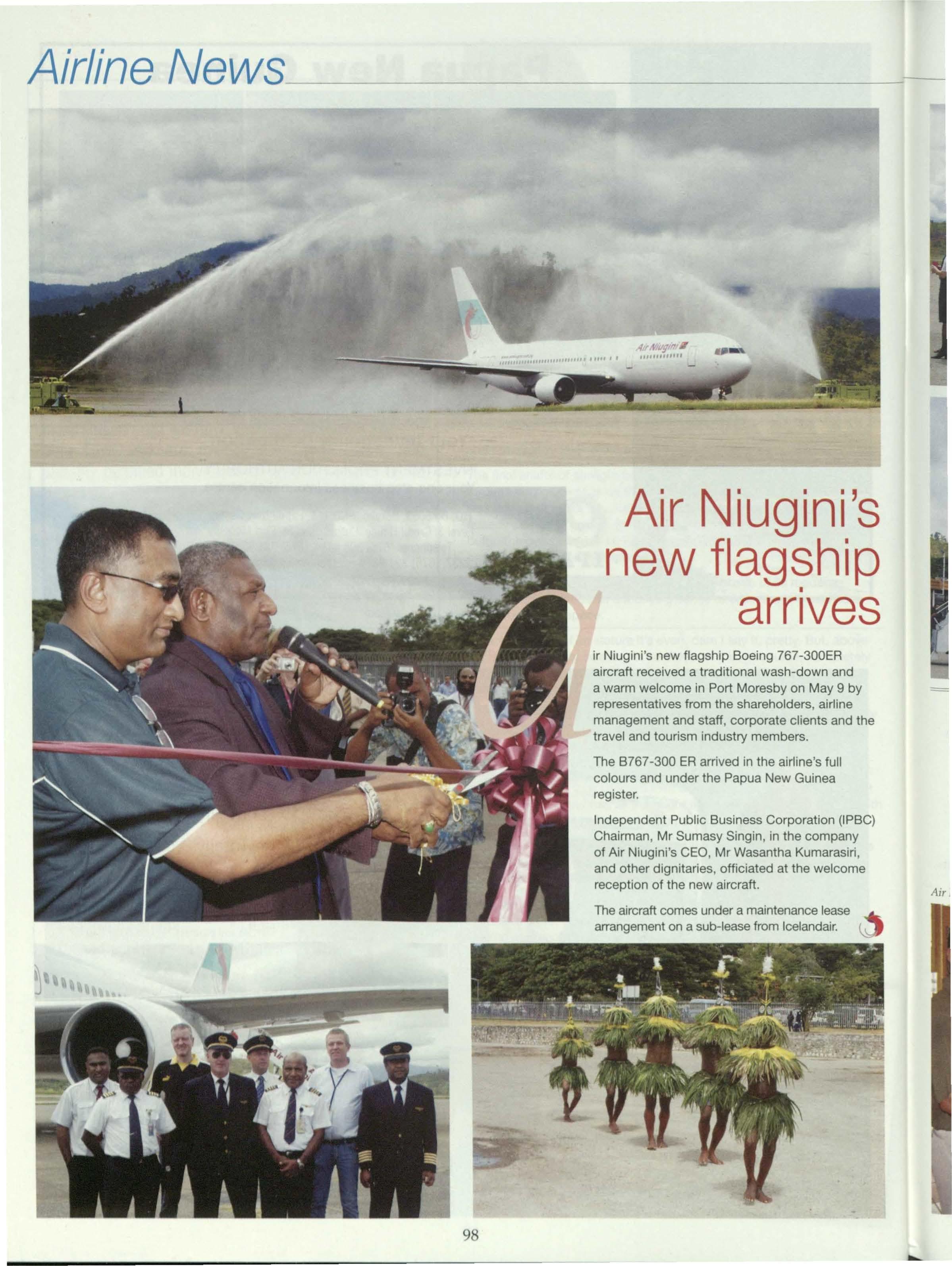
ir Niugini's new flagship Boeing 767-300ER aircraft received a traditional wash-down and a warm welcome in Port Moresby on May 9 by representatives from the shareholders, airline management and staff, corporate clients and the travel and tourism industry members.
The B767-300 ER arrived in the airline's full colours and under the Papua New Guinea register.
Independent Public Business Corporation (IPBC) Chairman, Mr Sumasy Singin, in the company of Air Niugini's CEO, Mr Wasantha Kumarasiri, and other dignitaries, officiated at the welcome reception of the new aircraft.
The aircraft comes under a maintenance lease arrangement on a sub-lease from lcelandair.
ir Niugini has joined 30 airline customers for the long-range, hightech jetliner B787.
Minister for Public Enterprise, Hon. Arthur Somare said the national airline has placed a firm order for the superefficient Boeing 787 Dreamliner jet.
The order, which was placed directly with the manufacturer, Boeing Commercial Alrplanes, is expected to be delivered in 2016. It is in line with the shareholders' plan to see Air Niugini equipped with a modernised fleet to meet the airline's future expansion and growth as a regional carrier.
Air Niugi11istnff(in red) tending to interestedcustomersnt the Mndnng Expo. l
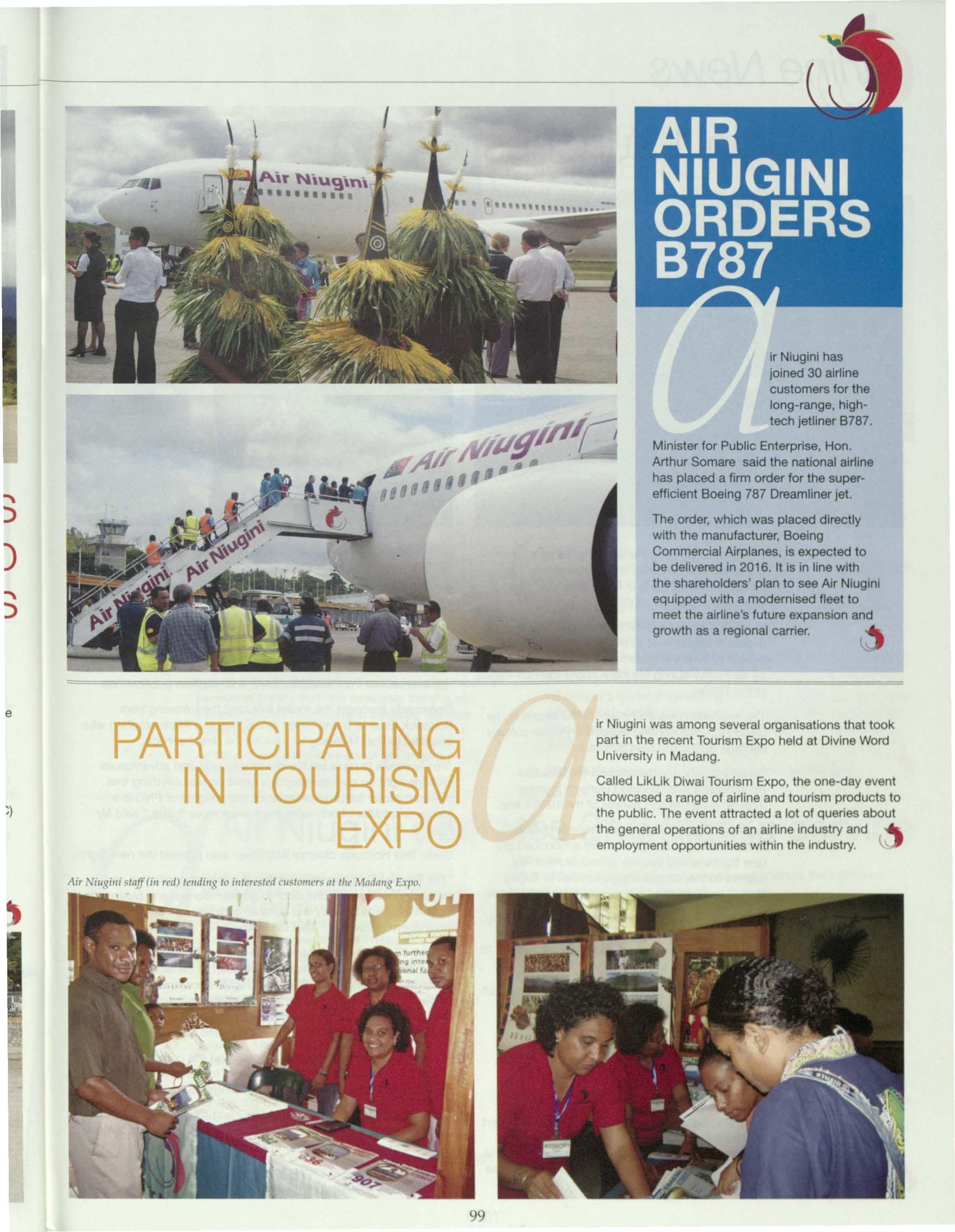
ir Niugini was among several organisations that took part in the recent Tourism Expo held at Divine Word University in Madang.
Called Liklik Diwai Tourism Expo, the one-day event showcased a range of airline and tourism products to the public. The event attracted a lot of queries about the general operations of an airline industry and employment opportunities within the industry.
Air Ni11gi11i'sSyrl11eystnff(from left): Amy, Rose,C/rnrlesMorley (Mn11ngerA11strnlin),Hele11 n11rlTris/r Ayoub (Syrl11eySalesSupervisor).

ir Niugini celebrated the launch of its new direct flights between Sydney and Port Moresby with a stylish cocktail party in Sydney's Australian Museum on May 19, 2008.
The Frank Hurley Exhibition located in the historic museum played host to the event and enabled guests to view the showcased photographs taken by Mr Hurley during his expeditions through Papua in the 1920s.
The exhibition provided a wonderful backdrop for the launch, highlighting the country's rich cultural heritage during the past 80 years.
Travel industry guests admired the beautiful photographs that depicted Hurley's journey through a culture and people of the 1920's era.
Air Niugini General Manager Marketing, Colin Lyttle welcomed the guests and announced the new flights would provide schedule reliability, explore further tourism opportunities to Papua New Guinea and make the route financially viable.
"The direct Sydney service will bring Port Moresby and Sydney closer together and to celebrate, Air Niugini is offering a promotional launch fare of $275 return plus taxes and surcharges," Mr Lyttle said.
The direct service is using an Embraer 190 aircraft operated by Brisbane-based SkyAirWorld.
"It is Important to reflect that this is the first Introduction of a brand new aircraft to operate non-stop to Sydney and provide a superior product to this growing tourist and adventure travel market," Mr Lyttle said.
In recent years, Papua New Guinea has continued to attract a consistent stream of international tourists who are keen to experience first-hand the country's rich diversity, historic cultural influences and natural landmarks.
Ni11gi11i'sC/rnrlesMorley
guests w/ro nfte11rledthe ln1111c/ri11g of the nirli11e'sSyd11ey/PortMoresby service.
In fact, in January alone, more than 9600 international tourists arrived in PNG, representing a significant growth of almost 20 percent when compared to the corresponding period last year.
Clearly, PNG is continuing to develop as a tourist hub of Asia Pacific and is now on the agenda for more international visitors seeking a unique travel experience.
More than 50 guests attended the launch including various media representatives from aviation, travel and tourism publications.
Comments amongst the media included the following from Roderick Eime (a Travel Writer and Editor and Photographer) who travelled to Port Moresby in June on the direct service.
"For Australia to have such a deliciously wild and adventurous location right on our doorstep is a great bonus. Anything that makes it easier for us to experience the delights of PNG is a welcome addition. I only wish there were more flights," said Mr Eime.
South Sea Horizons director Kori Chan also praised the new flights.
"The Sydney-Port Moresby service is a fantastic initiative and will undoubtedly open the door to greater tourism and business opportunities as Sydney is a suitable gateway for Australian and international travellers," said Mr Chan.
A lucky door prize was drawn at the event with the winner taking home two return tickets to the pearl of the South Pacific - "Madang" - flying Air Niugini, four nights accommodation at the Madang Resort and Kalibobo Village, plus a half-a-day village tour and harbour cruise. The prize was generously donated by the Madang Resort, Melanesian Tourist Services and Air Niugini.
The announcement of the direct flights and the commitment of further improvements and developments to the airline greatly emphasised the positive direction Air Niugini is travelling in.
"Things are starting to happen in PNG and for Air Niugini. We are now seeing a more stable international fleet providing a more flexible and compatible group of aircraft," Mr Lyttle said.
Air Niugini will also be expanding with new aircraft and services to be included in the near future.
Jack Pidik (Customer Service Manager-Air Niugini ), Wasantha Kumarasiri (Chief Executive Officer - Air Niugini). Kamal and Colin Lyttle (General Manager Marketing - Air Niugini) at a function to meet the legendary singer who was in Port Moresby to help ftmdraise for Operation Open Heart 2008.
peration Open Heart is made possible by a group of volunteers, comprising cardiac specialists, heart surgeons, anesthetists and specialised nurses who travel to PNG each year to perform open and closed heart surgeries mainly on children and young adults.
This year will be their 15th visit, and to-date in excess of 465 young lives have been saved by their specialised surgery. Additionally, doctors and nurses at the Port Moresby General Hospital have benefitted greatly from the extensive training and experience they have learnt in assisting with the operations.
Air Niugini is a major sponsor of the project each year.

ive Air Niugini Avionics cadets became the first graduates under the airline's Cadet Engineering Programme to successfully complete their Maintenance Authority training from Aviation Australia on April 17, 2008.
The graduation was also a first for Aviation Australia. Unlike previous years, students were recruited from universities or colleges. The recent graduates were selected from national high schools upon completion of their Year 12.
Following the completion of their training to Maintenance Authority standard, it means the five graduates can now proceed to work on obtaining type rating on Air Niugini aircraft. The next goal for these young graduates will be to become Licensed Aircraft Maintenance Engineers (LAMEs).
Air Niugini's Cadet Engineering Programme commenced in 2002 with eight students, followed by six in 2003. Two of the current graduates are from the 2002 group while three commenced in 2003.
Nine students are expected to graduate later this year.
ir Niugini commenced operating its second Manila service on Saturday May 24, 2008 utilising its leased B757-200 following successful bilateral agreements by relevant government authorities in Papua New Guinea and the Philippines.
Chief Executive Officer, Mr Wasantha Kumarasiri, is confident the second service will provide excellent connections between Manila and Fiji, providing an opportunity to route passengers from the Pacific Islands countries wanting to travel to Manila, Japan and even China via Port Moresby.
Air Niugini currently flies once a week to Manila and Hong Kong on Tuesday and returns from Hong Kong on Wednesday evenings, arriving in Port Moresby on Thursday morning.
Passengers to and from Manila have experienced a significant capacity shortage and the airline's Chief Executive is positive the second service
will provide relief on the current service and address the additional capacity requirements on the route.
The schedule is planned to give Air Niugini an excellent business opportunity to sell its second service to and from Honiara and Fiji on Saturdays and Sundays.
Flight numbers are maintained as PX008 and PX009.
2ND MANILA SCHEDULE:
5pm departs Port Moresby 9.15pm departs Manila (local time)
8pm arrives Manila (local time) 4.35am arrives Port Moresby
Air Niugini's flight PX085 every Saturday arrives from Nadl and Honiara into Port Moresby at 11am - allowing ample time for connections with the second Manila service.
PX009 arrives from Manila into Port Moresby every Sunday at 4.35am - allowing ample time for connections to Honiara and Nadi on PX084 which departs at 9.15am.
Lying entirely within the tropics, barely south of the Equator and just north of the Australian continent is Papua New Guinea, the second largest island in the world. With a total land mass of 473.189sq.km it is the last of a string of Islands spilling down from South East Asia into the Pacific.
Apart from the mainland, Papua New Guinea comprises a remarkable collection of islands, atolls and coral reefs scattered around its coastline. The mainland is divided by the Owen Stanley Range-a rugged central spine with peaks over 4,000 metres high. Great rivers begin their journey to the sea from these mountains-among them, Fly and Sepik waterways. Below the mountain chain, fertile coastal plains, flooded delta regions and mangrove swamps exist alongside broad sandy beaches, sheltered bays and dense rain forests.
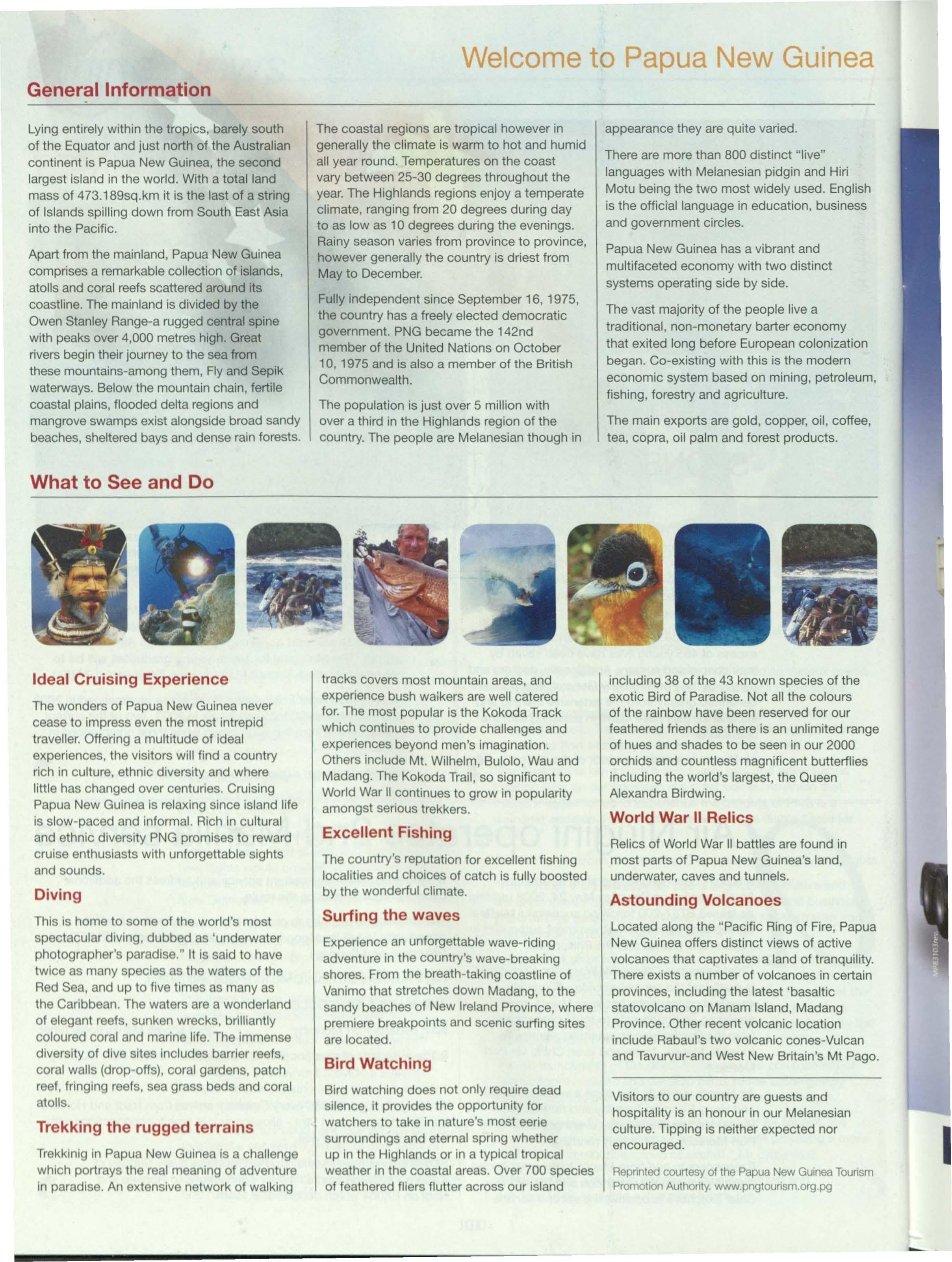
The wonders of Papua New Guinea never cease to impress even the most intrepid traveller. Offering a multitude of ideal experiences, the visitors will find a country rich in culture, ethnic diversity and where little has changed over centuries. Cruising Papua New Guinea is relaxing since island life is slow-paced and informal. Rich in cultural and ethnic diversity PNG promises to reward cruise enthusiasts with unforgettable sights and sounds.
This is home to some of the world's most spectacular diving, dubbed as 'underwater photographer's paradise." It is said to have twice as many species as the waters of the Red Sea, and up to five times as many as the Caribbean. The waters are a wonderland of elegant reefs, sunken wrecks, brilliantly coloured coral and marine life. The immense diversity of dive sites Includes barrier reefs, coral walls (drop-offs), coral gardens, patch reef, fringing reefs, sea grass beds and coral atolls.
Trekking the rugged terrains
Trekkinig in Papua New Guinea is a challenge which portrays the real meaning of adventure In paradise. An extensive network of walking
The coastal regions are tropical however in generally the climate is warm to hot and humid all year round. Temperatures on the coast vary between 25-30 degrees throughout the year. The Highlands regions enjoy a temperate climate, ranging from 20 degrees during day to as low as 10 degrees during the evenings. Rainy season varies from province to province, however generally the country is driest from May to December.
Fully independent since September 16, 1975, the country has a freely elected democratic government. PNG became the 142nd member of the United Nations on October 10, 1975 and is also a member of the British Commonwealth.
The population is just over 5 million with over a third in the Highlands region of the country. The people are Melanesian though in
appearance they are quite varied.
There are more than 800 distinct "live" languages with Melanesian pidgin and Hiri Motu being the two most widely used. English is the official language in education, business and government circles.
Papua New Guinea has a vibrant and multifaceted economy with two distinct systems operating side by side.
The vast majority of the people live a traditional, non-monetary barter economy that exited long before European colonization began. Co-existing with this is the modern economic system based on mining, petroleum, fishing, forestry and agriculture.
The main exports are gold, copper, oil, coffee, tea, copra, oil palm and forest products.
tracks covers most mountain areas, and experience bush walkers are well catered for. The most popular is the Kokoda Track which continues to provide challenges and experiences beyond men's imagination. Others include Mt. Wilhelm, Bulolo, Wau and Madang. The Kokoda Trail, so significant to World War II continues to grow in popularity amongst serious trekkers.
The country's reputation for excellent fishing localities and choices of catch is fully boosted by the wonderful climate.
Experience an unforgettable wave-riding adventure in the country's wave-breaking shores. From the breath-taking coastline of Vanimo that stretches down Madang, to the sandy beaches of New Ireland Province, where premiere breakpoints and scenic surfing sites are located.
Bird watching does not only require dead silence, it provides the opportunity for watchers to take In nature's most eerie surroundings and eternal spring whether up in the Highlands or in a typical tropical weather in the coastal areas. Over 700 species of feathered fliers flutter across our island
including 38 of the 43 known species of the exotic Bird of Paradise. Not all the colours of the rainbow have been reserved for our feathered friends as there is an unlimited range of hues and shades to be seen in our 2000 orchids and countless magnificent butterflies including the world's largest, the Queen Alexandra Birdwing.
Relics of World War II battles are found in most parts of Papua New Guinea's land, underwater, caves and tunnels.
Located along the "Pacific Ring of Fire, Papua New Guinea offers distinct views of active volcanoes that captivates a land of tranquility. There exists a number of volcanoes in certain provinces, including the latest 'basaltic statovolcano on Manam Island, Madang Province. Other recent volcanic location include Rabaul's two volcanic cones-Vulcan and Tavurvur-and West New Britain's Mt Pago.
Visitors to our country are guests and hospitality is an honour in our Melanesian culture. Tipping is neither expected nor encouraged.
Reprintedcourtesy of the Papua New GuineaTourism PromotionAuthonty.www.pngtourism.org.pg

